- Summer Game Fest 2024
- Amazon Prime Day is coming in July
- Apple WWDC 2024
- Samsung Galaxy Watch AI features
- 13-inch MacBook Air M2 deal

‘Star Trek: The Motion Picture - The Director’s Edition’ makes its glorious return
It’s still the same film, but it’ll never look better than it does right now..
If there was ever a Star Trek film that needed a do-over, both artistically and reputationally, it was The Motion Picture . Dismissed by critics as boring and sterile when it came out, its nickname inside Trek fandom has long been “The Motionless Picture.” In 1997, director Robert Wise started the process of re-examining the film, with a Director’s Edition being birthed at the dawn of the DVD era in 2001. For a couple of reasons, the altogether better version of that movie fell into obscurity, unavailable for most people to see. Now, twenty years after Wise’s amended film made its debut, the film has been given a second do-over in the form of a 4K remaster for Paramount+ .
The Abandoned Picture
You can buy a shelf’s worth of books discussing the troubled production of The Motion Picture , and its creative failures. Paramount wanted a new Star Trek TV series, until the money men balked at the cost and potential disinterest from advertisers. The pricey show got crunched into a single movie-of-the-week, right until the moment that Star Wars (and Close Encounters ) swallowed 1977 whole. Bosses wanted a slice of that late ‘70s sci-fi movie pie and upgraded the Trek project to a big-budget movie. Except none of the already-made material was movie quality, and the effects house wasn’t up to the task at hand.
The Motion Picture was directed by Robert Wise, a footnote in a career that started in 1934 and ran through 2000. Wise got his big break as Orson Welles’ editor on Citizen Kane and, more controversially, The Magnificent Ambersons . He’d won enough Academy Awards that The Motion Picture wouldn’t be in the top ten of his most notable achievements. The special effects were eventually completed by the recently-departed Douglas Trumbull and John Dykstra; both could point to 2001 and Star Wars as the highlights on their own resumes. Even so, Wise was battered by the process of making it, hand-delivering the prints to the film’s premiere and declaring it to be a rushed, unfinished job.
Length was a problem for the film, a 90-minute TV pilot expanded to more than two hours, bloated with too many special effects shots. Paramount would subsequently produce an even longer cut of the film, letting ABC screen a super-sized, 143-minute TV version which included deleted and unfinished scenes. (There is a rumor, apparently tied to this forum post from 2016 (via Memory Alpha ), which suggests that Wise re-cut the film in 1980 to be 12 minutes shorter, but producer David C. Fein doesn’t believe it to be true.)
The Director’s Edition
In 1997, Wise, through his company Robert Wise Productions, enlisted the help of producer David C. Fein, post-production supervisor Michael Matessino and visual effects supervisor Daren R. Dochterman to help fix the film. They examined the original storyboards, fixed some of the more egregious effects choices and tightened the editing. While the runtime was longer, a snappier edit (more or less) helped contextualize some of the choices made back when the film was shooting. It also helped to kickstart the reappraisal of the film as something more valuable than the big-budget catastrophe it was treated as.
Part of that work was to broaden the visual palette, especially in some of the key sequences which weren’t fully-realized in ‘79. The inconsistencies during Spock’s first scene – which were shot in broad daylight but painted on a matte implying darkness – are fixed. Many sets that were constrained even with matte paintings were broadened out and CGI – by pioneers Foundation Imaging – used to fill the gaps in the action. The film remained, more or less, like it had two decades prior, but was a much more joined-up experience on screen.
But this edition, while considered “definitive,” was never re-released beyond its original 2001 DVD printing. According to Memory Alpha , it’s because Paramount never kept its own archive copies of the CGI files for its projects. And when Foundation Imaging went under after the death of its founder, Ron Thornton, it was believed that those files were gone forever.
The Re-Remaster
“Completely untrue,” said David C. Fein who produced both the first Directors Edition and its 2022 successor, to Engadget. “Everything was designed to be able to go to film, but the resolution [in those original files] wasn’t there, [...] so it couldn’t just be re-rendered,” he said. “It had to be recreated by people who knew what we were going for, because we’re now able to put the detail in for it to be full-size.” “We re-did all the visual effects, not from scratch – the setups [from 1999] were there – then we worked in all of the new levels of technology and information,” said Fein.
Fein says that the project, which was announced in July 2021 , is “not a restoration,” and that his team wasn’t just “polishing this film,” but working to tweak it to improve the overall storytelling. That meant scanning the raw material and re-compositing everything to make a fresh, 4K scan off the original 35mm live-action footage. (Douglas Trumbull, to avoid detail loss, would shoot on 65mm film, and so his material was scanned in at 8K, while Dykstra’s VistaVision material was scanned in at 6K.)
The project is, if we’re being a little too honest, long overdue, since Paramount opted to offer the theatrical print of The Motion Picture for all of the Blu-ray releases. “Unfortunately, when the hi-def [versions of the Star Trek films] came out, Bob [Wise] got to watch the fact that it was the original theatrical version,” explained Fein. “And he sat me down in his kitchen and said, ‘I need you to promise me something Dave’ – ‘I don’t care how long it takes, I need you to finish the director’s edition and it needs to be finished ,’ meaning film quality.” But Fein says that the lag time was down to a need for the technology to improve, and also for the “guardian angels” at Paramount+ to greenlight the work.
There are a number of small tweaks to the film, designed to smooth out even more of its visual rough edges. Keen-eyed fans will enjoy spotting the additions and changes, an early highlight is the addition of Shuttle Pod 5 to the exterior of Starfleet’s orbital office. “Just about every shot [in the film] has been touched in some way, there’s a lot of subtlety added to shots,” he said. “There’s [also] at least one clearly new shot in the film that helps continuity, and I hope no-one else notices it.”
One sequence that Fein spent lots of effort on, both then and now, was when the V’Ger probe attacks the bridge. The original film sequence was projected through a bent mylar filter with intentionally harsh lighting to create the alien effect. “The way that it looked, was almost like [our] film stopped and another one started,” he explained, looking at the washed-out colors, high grain and poor continuity. Fein credits the power of HDR which enabled his team to create a harsh overexposure of the probe without dulling the rest of the film.
And a less obvious change – unless you’re like me and watched multiple versions side-by-side – is a vastly improved color grade. Because the film was so rushed, Fein explained, the process of color grading, which can take months, was crunched down to four days. He said that the crew’s opinion, at the time, was “just ‘let’s get it done as flat [as we can] so everything matched, and [get it done] as quickly as it could.” The film’s colors are, traditionally, washed out, leaden with that ‘70s sci-fi beige that makes even the actors look like pieces of furniture. “Now that we’re working from negative scans, we’re able to do what [Robert Wise’s] real intention was.”
The final task Fein had to oversee was to ensure that The Directors Edition is no longer a rare curio. Fein explained that, having worked with the digital negatives and produced a new print designed for theatrical distribution, the film is now “future proof.” That should ensure that it never again becomes the sort of film you have to actively seek out to watch. Not to mention that Fathom events will offer a handful of screenings (in select theaters) for viewers to see the film on the big screen once again.
Give me a Good Time
I don’t want to be facetious when I say that The Motion Picture is less of a film and more of an experience . For all of the complaints that the film was slow, antiseptic and cold, it also offers something a little more heavyweight than you may expect from a franchise movie. The team behind the film may not have been making Solaris , or 2001 , but those influences are keenly felt through much of the movie. It’s not dumb noisy fun, and it’s not as clever as it thinks it might be, but it’s trying to deal with some weighty issues around what it means to be human. A computer looking to understand if there’s any meaning beyond its existence is something fiction has come back to again and again – it’s always been a fascination for Star Trek , too.
Unfortunately, I didn’t get to watch the 4K transfer in all of its glory, since previews were capped at 1080p ( I know ). What is obvious, however, is that the new version is a whole lot brighter, with much more detailed CG models and much better sound, in most places. The new color grade makes a huge difference, with actors no longer blending into the background of their own film. There are only a few moments where the transfer seems less kind than you may expect, and that’s mostly when you go looking for matte lines. You can clearly see some of that hand-cut wonkiness in the more detail-heavy sequences, like the drydock scene.
(While we’re on the subject; the Drydock sequence is considered, by non fans, as the ne plus ultra of pointless fan service. Yes, it’s a six-minute scene in which Kirk stares, milky-eyed at the refitted Enterprise, well-known enough that even nü-Trek repeatedly tips its hat to it . But let’s be honest, if you wanted to spend six minutes staring at a model, you might as well make it the most beautiful model ever to be created .)
And as much as it’s Wise’s name on the film, in these modern eras, I think we should also offer kudos to Trumbull and Dykstra for their contribution. The effects sequences are, for their age, some of the best ever put to film and the trippy late ‘70s sci-fi visuals during the spacewalk sequence are on a par with anything 2001 offered. I can’t not also say that, without Jerry Goldsmith’s score, one of the best ever written, much of this film wouldn’t hold together nearly as well as it does. While the finished product is not to everyone’s taste, you can tell it is the product of a number of virtuosos all working to produce their very best work.
It’s funny, because I’d say that I’ve seen this film more times than I should probably admit, especially the first 40 minutes. Something that only occurred to me during this rewatch is how Wise’s direction, and the acting, loosens up as things go on. Kirk, Spock and McCoy all start this film stiff and stagey, acting like they’re all trying to act under the effects of a sedative. But once they’ve returned to the Enterprise and you see Kirk visibly relax into his chair, Spock and McCoy start bantering, and you could almost frame this as a deliberate choice to make the film a form of origin story.
While researching this piece, I went hunting for critical reviews of the film back when it first debuted in 1979. (The best modern essay on the film, and the best modern essays on any of the Star Trek films, is Darren Franich’s 2016 retrospective , which I urge you to read.) Weirdly, Roger Ebert wrote the smartest take on the film back then, and I reckon the conclusion of his review is probably the most elegant way anyone could discuss it. He wrote, “Some of the early reviews seemed pretty blase, as if the critics didn’t allow themselves to relish the film before racing out to pigeonhole it. My inclination, as I slid down in my seat and the stereo sound surrounded me, was to relax and let the movie give me a good time. I did and it did.”
Star Trek: The Motion Picture - The Director's Edition , will be available on Paramount+ on April 5th, 2022. A physical media release will follow with new special features.
Latest Stories
Apple's ai push will reportedly be called apple intelligence, of course.
Apple will call its long-rumored artificial intelligence play "Apple Intelligence."
Whistleblower claims Amazon violated UK sanctions by selling facial recognition tech to Russia
An ex-employee has accused Amazon of breaching UK sanctions by selling facial recognition technology to Moscow following its invasion of Ukraine.
Blackmagic's DaVinci Resolve 19 arrives for Qualcomm Snapdragon X Elite PCs
Blackmagic Design just announced that its popular (and free) DaVinci Resolve 19 beta 3 app now supports Windows machines running the Snapdragon X Elite processor.
The best backpacking and camping gear for dads
Find the best outdoor gear gifts for dad ahead of Father's Day, including camping, backpacking and hiking gear.
Amazon Freevee adds terrifying AI-generated men to 12 Angry Men poster
Amazon-owned Freevee uses a very interesting -- and terrifying -- poster for 12 Angry Men.
Engadget Podcast: How AI will shape Apple's WWDC 2024
In this episode, Cherlynn and Devindra dive into everything they expect at WWDC 2024.
The Morning After: What to expect from Apple’s big event
What to expect at WWDC 2024 and two big wins for space travel.
The best laptops for gaming and schoolwork in 2024
Here's the latest list of the most powerful and affordable laptops for gaming that students can also use for school, as reviewed by experts from Engadget.
Apple will reportedly build a dedicated Passwords app for the iPhone and Mac
The new app, simply called Passwords, will compete against existing password managers like 1Password and LastPass, which typically charge people a monthly fee for generating and storing unique passwords.
Boeing’s Starliner overcomes last-second problems to dock with the ISS
Boeing’s Starliner has successfully docked with the ISS — but not without some last-minute problems. The company’s first crewed mission to the space station linked up at 1:34 PM ET after missing its first shot due to several thrusters malfunctioning.
Amazon Prime Day 2024: Everything we know about Amazon's sale in July
Here's everything you need to know about Amazon Prime Day 2024, including when the shopping event will take place, the deals we expect and more.
WWDC 2024: What we expect to come out of Apple's Keynote, and how to watch
It's almost time to learn about new features coming to Apple devices at WWDC. Here's what we expect the company to reveal at the event.
Record labels will start reaching into the pockets of Twitch DJs
Twitch DJs who monetize will have to pay labels to use their music. The company says the status quo “was not sustainable.”
Apple's Studio Display is $300 off right now
Apple's Studio Display has dropped to its lowest price to date for models with a VESA mount and tilt-adjustable stand.
Microsoft and CWA forge labor neutrality agreement covering all ZeniMax workers
Microsoft and the CWA have forged a labor neutrality agreement for all ZeniMax workers. The CWA says the deal is similar to the one from 2022 covering Activision Blizzard’s workforce, which went into effect in April of this year.
TikTok’s AI efforts reportedly exploit loopholes to use premium Nvidia chips
The US has banned companies like Nvidia from selling their most advanced AI chips to China since 2022. But if loopholes exist, profit-hungry corporations will find and exploit them. A bombshell report on Thursday details how Oracle allows TikTok owner ByteDance to rent Nvidia’s most advanced chips to train AI models on US soil.
The best laptop you can buy in 2024
Picking your next laptop can be a daunting task. The Engadget team has tested and reviewed dozens of laptops and these are our favorites.
Skatrix for Apple Vision Pro now features room-scale mixed reality gameplay
Skatrix for Apple Vision Pro now features room-scale mixed reality gameplay. The little dude will skate all over your furniture.
Weber Slate griddle review: A smash burger machine with clever features
Weber isn’t new to the griddle game, but the company’s second attempt is more refined with plenty of room for customization. The Slate is a great way to smash burgers, cook breakfast and so much more.
FTC launches an antitrust probe into Microsoft's deal with Inflection AI
The FTC is investigating whether Microsoft structured a deal with Inflection AI to dodge regulatory review.
How Star Trek: The Motion Picture made the voyage home (to 4K)
Producer david c. fein on why this version will change minds about the first star trek film, some "happy accidents" during the restoration, and "cave spock".
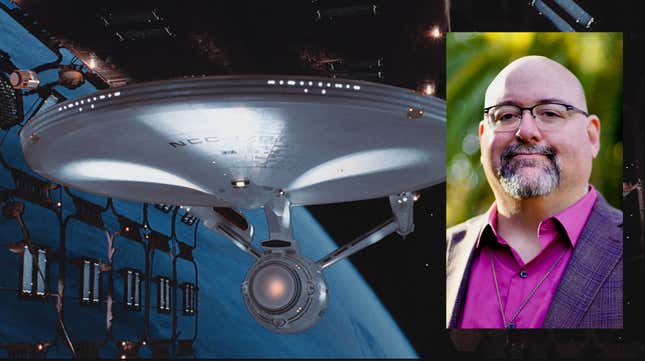
Star Trek: The Motion Picture is a benchmark film for multiple reasons. Not only did it revive the Trek franchise ten years after the cancellation of The Original Series , spawning what we’d now call an “expanded universe” of stories across a variety of other formats (film, TV, and more), but its 2001 arrival on home video with a Director’s Edition opened the floodgates for home video as a second-chance opportunity to revisit, expand, or in this case just complete a film that was never released to the filmmakers’ satisfaction. Director Robert Wise ( West Side Story ) may have been out of step with the prevailing cultural winds of 1979 when he agreed to helm The Motion Picture just two years after Star Wars changed everything about blockbuster moviemaking, but looking at the film in 2022, it’s clear that his gallant, meditative opus simply needed some extra time to connect with audiences.
Related Content
Paramount Home Video recently formalized that time warp with the release of Star Trek: The Motion Picture—The Director’s Edition—The Complete Adventure , which includes a 4K UHD remaster of the film that makes history yet again, like it did in 2001, and way back in 1979. The 2001 edition featured what were then cutting-edge special effects, but 20 years later, they’re not just outdated but unable to be replicated, which is why only the film’s theatrical cut was previously released in HD. Going back to the original camera negatives, producer David C. Fein and his team meticulously reassembled every element of the film down to the smallest details, enhancing moments that might have lacked color, brightness, or energy in earlier editions, and uncovering others that even long-standing Trek fans never noticed.
Fein spoke to The A.V. Club about how the film was compromised in ’79 by production woes and a rushed theatrical release and about why Star Trek: The Motion Picture—The Director’s Edition marks the overdue completion of the original project. In addition to pinpointing some of the tiny details that help round out Wise’s vision, Fein discusses technological advances that made this cut achievable only after some 43 years, and hints at the wealth of additional material that may be available to examine in some future release.
The A.V. Club: In the bonus materials, you said that Robert Wise saw other “director’s cuts” that helped him decide it was possible to do this. What were those films that inspired him?
David Fein: What’s unique about The Motion Picture is it’s not really a special edition or a different cut. It’s the first time the film was finished. Even our DVD version from 2001 was still just an evolution to finally getting it to film level. Because there were things we couldn’t do in color grading for home entertainment. But looking at [ Close Encounters Of The Third Kind ], Spielberg had scenes he wanted to put in but couldn’t do it because of the time. And eventually they had the collector’s edition of Close Encounters because it brought it back to what Spielberg’s original focus was. That’s probably the closest to where we’re going with the movie.
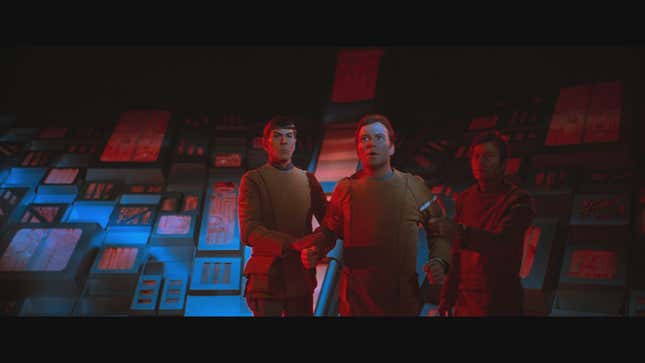
But Star Trek: The Motion Picture is not, “the film went into the theater this way and it was done.” The film never reached a full finished point until now. And there’s so many wonderful benefits we’re able to accomplish now that we weren’t able to even conceive of in 2000 in telling the story. And I’m thrilled, because we even found some answers to problems that we discussed but never really had a good solution for back then, and certainly a couple of happy accidents that worked better than I would have imagined.
AVC: Can you give me some examples of those happy accidents? And were there elements you wanted to leave alone, or just shine up a little bit?
DF: Well, the Paramount archives did an incredible job of pulling and archiving every piece of material that they had. [But] transferring those and being able to re-composite them digitally, I never realized how soft they were merely because of the rush [to complete the film back in 1979]. The dubbing was so low quality, to go back to the original camera negatives of each effects element and then re-composite them, they’re stunning. [But] there’s one story point that concerned me that I almost don’t want to tell you, because it never worked before. Something we did has such a subliminal moment to it that I think if I drew attention to it, I’m afraid it wouldn’t work as well.
AVC: You’ve whetted my appetite far too much not to tell me. Please keep going.
DF: Maybe in a month after people have a chance to look at it, we’ll connect again and I’ll tell you. But unique to this version, having the entire film available in negative form, just about every shot has been touched in some way to enhance it or to make it work. And working from camera negative as opposed to any other format, there’s this striping space where you have audio on 35mm film. There’s also picture if they don’t hard matte it, and there’s at least one moment in the film where something’s happening on the right-hand side of the screen, and it was good but it wasn’t feeling as powerful as it needed to be. And that’s when Scotty is talking to the other engineer about “why did the captain order self-destruct?” There’s another crewman who’s standing there working on it [who reacts like,] what did he say? Recognizing that he’s going to die, too. And it just helped to amplify it.
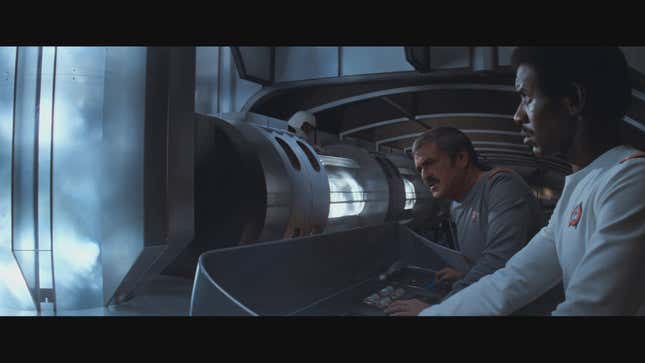
The other thing I was going to say is that there’s two places in the film where, forever, what you see on the screen is ‘what’s happening.’ It’s always been that way. But there’s two places now where what you’re seeing is more of a dream moment. The first one is when Ilia reaches out and touches Chekov and says, “I can stop this pain.” That scene had an importance because it’s what made her different on the bridge for the V’Ger probe to grab her. But this is different from even the DVD version, and she says “I can stop this pain” and she touches him, there’s a moment where the music comes up, but everything else disappears. The bridge sound effects, everything, all goes away. And it’s this psychic moment between him and her, where the world just melts away. And it’s that personal, and it amplified the importance of it. And then when he says “thank you,” it comes back into the real world. So it’s like this little dream, but it helped tell that point of the story and helped amplify her importance.
AVC: The era in which the first version was made did not have the technological complexity to zero in on those subtleties. Where was it necessary to take a little creative license to kickstart some of those ideas that weren’t as clearly articulated in the original film, without knowing if Robert Wise would have approved?
DF: The first thing that pops to mind is the color grading, because the original film had literally four days to color grade the film. They didn’t know what effects would be in there or what scenes would be in from beginning to end, so they had to leave a basic flat grade so that if something came in, they could quickly fit it into the edit. [But] the film needed dynamic range to draw you in, to get that scope of what we were looking for, and when we were doing the original project, Bob suggested, “what if we didn’t just compress that information down, but we expanded the delivery format?” And he implored me to absolutely use every tool available to tell stories. And he didn’t know what Dolby Atmos was—it didn’t exist! But now we’re sitting in this room with V’Ger [going] “BOING” over you in the Atmos mix, and now the sound helps tell the highs and lows of the story.

[Also], there’s still some long shots that felt long in the 2001 version to some people—but now you need that as a recovery moment from the highs. And that light probe on the bridge is so exciting, because now we have HDR. We know it’s so bright that people had to cover their eyes on the bridge, but now it’s bright enough to give you more of that experience. And it’s just going to improve as technology improves. And that makes me more excited than ever before, that we haven’t reached the potential that is actually on this disc—even in 4K.
AVC: There have always been retroactive changes—or explanations to those changes, like the Klingons in Star Trek: The Motion Picture were the first ones that had the ridged foreheads. Were there any changes or enhancements that you worried you shouldn’t do because it might affect Trek canon?
DF: We had our edit mostly locked from the 2001 [version], so I don’t think there would be anything that would take away from the narrative. If anything, effort was just focused on making the story work. There are key decisions that just work better now. The moral [of the story] itself was still ahead of its time, in that technology without humanity is cold and can’t move further into reality. At the time, the greatest technological advancement was a touch- tone! I think now the moral would affect them more if you just gave them what the story is now, because it relates more now. We all have cell phones. And if you took all social media away from it, it wouldn’t mean anything. So now the message has changed, or caught up to today’s reality. But it didn’t need my help.
AVC: Collector’s editions like this are more rare than ever—this is sort of the exception that proves the rule. How much is left to explore about this film or the Original Series cast Star Trek films, that fans wouldn’t know about?
DF: I started my career as a special feature archeologist, which is what I’ve always called them. And there’s always more material. I mean, we transferred so many hours of material that we can never present it all. There’s deleted moments or deleted scenes. And even this project hasn’t scratched the surface on what’s out there. I think every film, every project has so much more that could be told. The question is if there’s going to be enough motivation to have someone want to go back and do all that extra work—and whether or not there’s going to be financing for it. It’s nice that with streaming, there is opportunities to have no limitations in space, but then there’s always time and budget, whether or not it’s there.
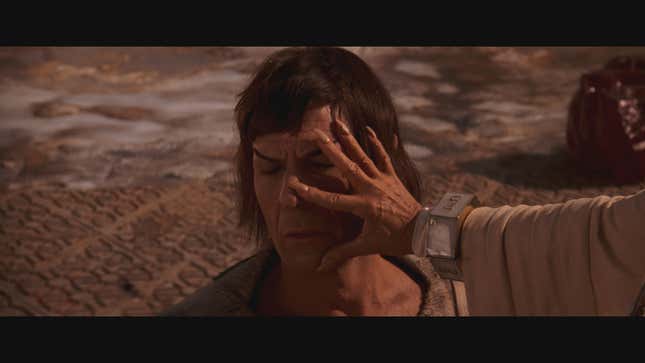
I’m always going for the coolness factor. One example on this project was “cave Spock.” That’s something that I knew about for years and everybody I spoke to, including Nimoy’s family, never knew that there was the cave Spock stuff. So I knew that was going to be fantastic. There are surprises in everything, and there is no limitation except that many, many times studios have thrown out or don’t have the same material. There are still thousands of photos that no one’s ever seen on this film. On every film. But no, we’re certainly not at the end of possibilities.
There’s deleted moments that could change a whole film. And that’s where it’s important that you have the alternate cuts, because the theatrical cut, many people fell in love with the film as a theatrical [experience]. When it became the special longer version, that’s what introduced people to the film [on TV]. That has a place for them as well. That’s why it’s included in the Complete Adventure. And now we have the Director’s Edition, where everyone should just watch it as the definitive version. But the only limitations are when there’s nothing that exists at all, on any of the movies. But even then you can get people’s current perspectives on where the film stands today, based upon the past. It’s all a matter of creativity, ingenuity, and thinking about what could be created—even out of nothing. I’d love to see a hell of a lot more on all the films.
- The Original Series
- The Animated Series
- The Next Generation
- Deep Space Nine
- Strange New Worlds
- Lower Decks
- Star Trek Movies
- TrekCore on Twitter
- TrekCore on Facebook


The news was announced at StarTrek.com this morning by way of a new trailer showcasing the restored and remastered version of the film — including new looks at visual effects and the from-the-negative new color and picture quality of the film.
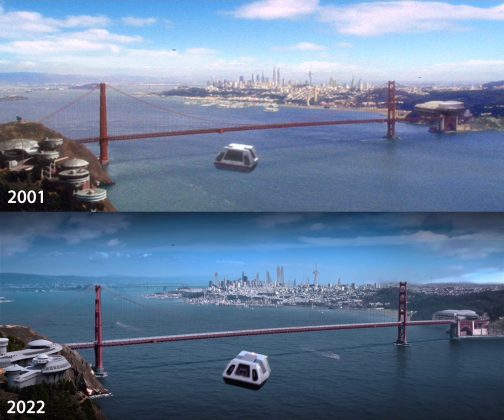
While Star Trek: The Motion Picture — The Director’s Edition will only be available through Paramount+ at the time of its debut, the studio has already announced both theatrical screenings and an on-disc release for later in the year.
Fathom Events will be holding theatrical screenings of the new TMP-DE release on May 22, May 23, and May 25 (local timings and ticket sales coming to Fathom’s website here on April 8), and the film will be coming to physical media in September per the StarTrek.com announcement.
The 4K Ultra HD Blu-ray release of The Director’s Edition is set to include HDR-10 and Dolby Vision, as well as Dolby Atmos audio — plus new bonus content (details not yet announced) and other features carried over from past releases of the film.
It also appears we will get to see at least one new deleted scene in the forthcoming Blu-ray edition, as producer David C. Fein shared on StarTrek.com today:
For fans of the film, Fein also has another big surprise he revealed during the interview. “There’s a deleted scene that we wanted to have back 20 years ago,” he said. “This was Ilia and Scotty and Decker in engineering. We found some of the footage 20 years ago, but there was no audio, so there was really no point in showing the scene. But it’s three or four scenes that people have wanted to see forever. So we re-transferred that footage… and we found out that Bob looped the dialogue for the scene. Now that scene’s going to be included in the physical media release and others, because he looped a few. And we found other key scenes that are just fantastic.”
As soon as there’s more news on the Blu-ray release, you’ll find it here at TrekCore!
- Star Trek: The Motion Picture
- Star Trek: The Motion Picture Director's Edition
- Trek Movies
Related Stories
The wand company’s star trek: the original series tricorder get a closeup on adam savage’s tested, all star trek: prodigy season 2 episodes hit netflix on july 1, star trek: discovery’s ending moment was planned for season 6 (spoilers), search news archives, new & upcoming releases, featured stories, lost-for-decades original star trek uss enterprise model returned to roddenberry family, star trek: lower decks cancelled; strange new worlds renewed for season 4, our star trek: discovery season 5 spoiler-free review.
TrekCore.com is not endorsed, sponsored or affiliated with Paramount, CBS Studios, or the Star Trek franchise. All Star Trek images, trademarks and logos are owned by CBS Studios Inc. and/or Paramount. All original TrekCore.com content and the WeeklyTrek podcast (c) 2024 Trapezoid Media, LLC. · Terms & Conditions
How Star Trek: The Motion Picture 4K Director's Edition puts the Star Wars Special Editions to shame
The best way to upgrade a classic science fiction film is to change it as little as possible.
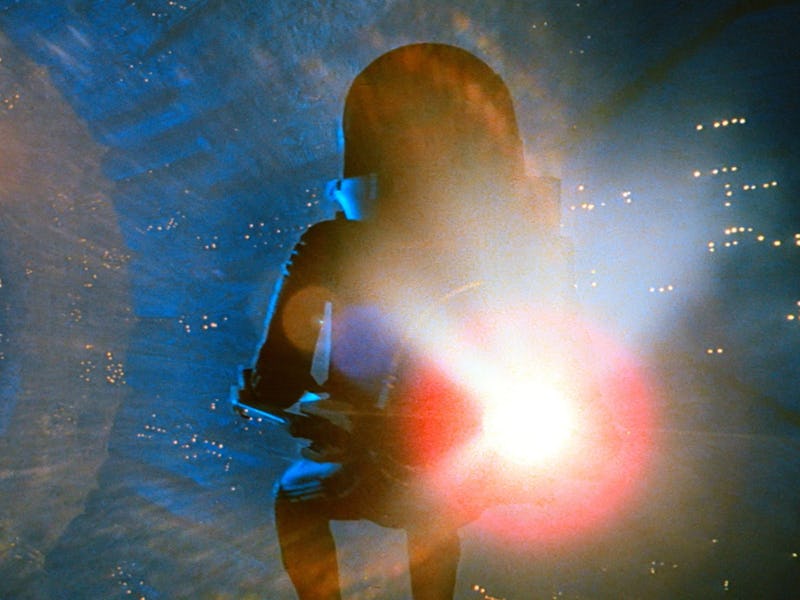
The human adventure is just beginning. At the end of Star Trek: The Motion Picture (1979), these words appeared on screen in plain white text. In the most recent 4K director’s edition , those words are in golden text. Believe it or not, this is one of the more radical changes made to the first theatrical Star Trek film.
Here’s why the beautiful new 4K restoration of this Trek film takes a subtle approach to updating an older sci-fi movie. And how it course corrects a trend established by the infamous Star Wars special editions .
Star Trek: The Motion Picture: Director’s Edition
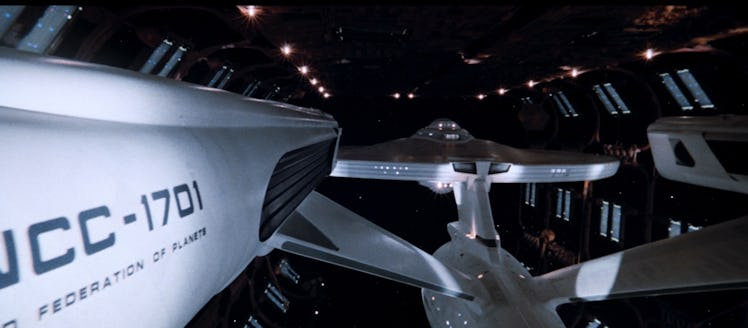
The Enterprise leaves spacedock in the 4K version.
On April 5, 2022, the new 4K restoration of Star Trek: The Motion Picture: Director’s Edition debuted on Paramount+. Overseen by David Fein, Daren Dochterman , and Mike Matessino, this cut of the film is, essentially, a spruced-up version of a previously released “director’s edition” from the year 2001. Back then, director Robert Wise was still alive and approved a few of the movie’s bigger changes, which, for the most part, are very minor.
In other words, just like there have been multiple “Special Editions” of the 1977 Star Wars or the 1982 Blade Runner , this isn’t the first time Star Trek: The Motion Picture has been re-released. In 1983, a “Special Longer Versions” of the film hit VHS , which notoriously spliced in footage from one of the film’s deleted scenes, creating a continuity error in which Kirk is wearing two radically different spacesuits just seconds apart.
Neither the 2001 nor the new 2022 Director’s Edition have these kinds of problems, but that doesn’t mean Star Trek: The Motion Picture is a perfect movie. Whether it's 1979, 1983, 2001, or 2022, the film is still a fairly humorless, slow-paced, and derivative of a pre-existing TOS episode, “The Changeling.” These days, homages and Easter eggs in Trek feel normal, considering there’s so much material to work with. But in 1979, there had only been 79 episodes of TOS . Why the eventual shooting story was, in essence, the same story that The Original Series had already told is still baffling.
Of course, there are various explanations for why The Motion Picture was written and filmed the way it was, and those accounts have filled several books, including Return to Tomorrow by Preston Neal Jones , The First Star Trek Movie by Sherilyn Connelly, The Making of Star Trek: The Motion Picture by Gene Roddenberry and Susan Sackett, Chekov’s Enterprise by Walter Koenig.
tl;dr: Nearly the entirety of the 1970s were filled with attempts to get a Star Trek film made, which, at one point, resulted in a new Star Trek TV series entering pre-production, and that failed TV show eventually resulted in The Motion Picture .
A classic science fiction film
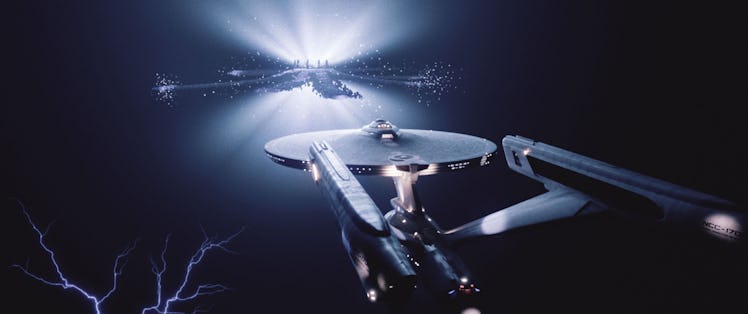
The remastered Enterprise in the 4K Director’s Edition of The Motion Picture . This is not a new VFX shot.
But the power of The Motion Picture has almost nothing to do with its story or the behind-the-scenes machinations. Like much of what is powerful about Star Trek, the subtext matters more than the context. Even with its flaws, there’s no denying this is a classic science fiction film. And it’s also obvious the film made history in many significant ways: It was the first major motion picture based upon a TV series, it was the first mainstream science fiction film to use the word “wormhole,” and it was the first feature film in what would become the ever-expanding Star Trek media franchise. Released on December 6, 1979, The Motion Picture was the literal last word in the sci-fi cinema of the 1970s, a bold and thoughtful film that has proven itself more timeless than some of its peers, most notably, the 1977 version of Star Wars .
From a purely superficial standpoint, what makes the new 4K Director’s Edition so shocking is how well the visual effects and overall design of the film hold up to contemporary scrutiny. The Star Trek franchise wouldn’t begin using Lucasfilm’s Industrial Light and Magic until Wrath of Khan in 1982, meaning the effects and production design of TMP came from a combination of talents including Doug Trumball, Alex Weldon, Robert Abel, and legendary model and prop-maker Brick Price, credited on screen for the first time in this 2022 edition.
There are a lot of behind-the-scenes reasons why The Motion Picture had so many cooks in the VFX kitchen, most of which are detailed in Jeff Bond’s amazing 2020 book, Star Trek: The Motion Picture: The Art and Visual Effects , but the result is clear: From the redesigned USS Enterprise to the mysterious V’Ger cloud to the massive sets and, of course, Spock’s ultra-memorable space-walk scene, the way The Motion Picture looked in 1979 was an achievement in a specific type of science fiction cinema which, can only be called epic . Arguably, it hasn’t been replicated, and seeing it in 4K only proves how amazing it looked the first time around.
What the Star Trek: The Motion Picture: Director’s Edition changes
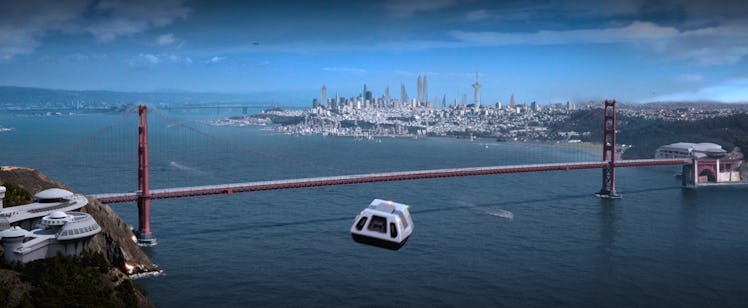
Kirk arrives at Starfleet Command in a new VFX shot. This is one of only a handful of “new” shots in the “Director’s Edition” of the film.
So, what did the new 4K version change? Essentially, everything about the original cut of the film simply looks crisper and clearer. Some of the sounds have been remixed for clarity, most notably, the trippy “wormhole” scene. A few new VFX shots have been either added or cleaned up, specifically when Admiral Kirk arrives at Starfleet Command toward the beginning of the film. And yes, the font for the opening and closing credits is gold now, not white.
But the result is pretty much the exact opposite of watching any of the various “Special Editions” of Star Wars: A New Hope . Although the enhanced DeathStar battle in the Special Edition of Star Wars is, admittedly, great, The Motion Picture didn’t actually need to do anything radical like that. Starship shots have not been replaced with new angels, and the meaning of each scene has not been changed. There is no “ maclunkey” moment in the Director’s Edition for The Motion Picture . There are no distracting CGI characters. The movie is simply the movie, just way better looking.
Because The Motion Picture is arguably the most beautiful Star Trek film of them all, this means this restoration doesn’t feel silly or gimmicky. This is Star Trek as it was in 1979, which, watching it now, feels shockingly brand new.
Star Trek: The Motion Picture: The Director’s Edition is streaming now on Paramount+ .

- Science Fiction
- Cast & crew
- User reviews
Star Trek: The Motion Picture

When an alien spacecraft of enormous power is spotted approaching Earth, Admiral James T. Kirk resumes command of the overhauled USS Enterprise in order to intercept it. When an alien spacecraft of enormous power is spotted approaching Earth, Admiral James T. Kirk resumes command of the overhauled USS Enterprise in order to intercept it. When an alien spacecraft of enormous power is spotted approaching Earth, Admiral James T. Kirk resumes command of the overhauled USS Enterprise in order to intercept it.
- Robert Wise
- Gene Roddenberry
- Harold Livingston
- Alan Dean Foster
- William Shatner
- Leonard Nimoy
- DeForest Kelley
- 581 User reviews
- 121 Critic reviews
- 50 Metascore
- 4 wins & 21 nominations total

- Captain Kirk

- Janice Rand

- Klingon Captain

- Epsilon Technician
- Airlock Technician

- Commander Branch

- Assistant to Rand
- (as John D. Gowans)
- Cargo Deck Ensign
- All cast & crew
- Production, box office & more at IMDbPro
More like this

Did you know
- Trivia When Captain Kirk addresses the crew before launching, many of the extras were noted Star Trek fans, including Bjo Trimble , co-organizer of the letter-writing campaign that kept Star Trek (1966) alive for a third season.
- Goofs When Kirk first comes on board Enterprise he is called "Admiral," and then "Captain" a few seconds later. However, it is customary for the person in command of a ship to be addressed as "Captain," regardless of his military rank.
[last lines]
Chief DiFalco : Heading, sir?
Captain James T. Kirk : Out there... thataway.
- Crazy credits End title: "The human adventure is just beginning."
- The landscape of Vulcan was changed to include a yellowish sky and new landscape featuring massive statues. All other footage was tinted gold.
- The matte painting of the Golden Gate Bridge in the scene where Kirk arrives at Starfleet Headquarters was replaced by a new CGI scene that shows Kirk's shuttle arriving at Starfleet. It is actually slightly longer than the original version.
- The matte painting of Starfleet Command was improved with CGI effects, including an original series shuttle launched in the background.
- In a close-up shot when Kirk first sees the new Enterprise from his shuttle, the image of the ship was superimposed over Kirk's face as a reflection in the shuttle's window.
- After Kirk leaves the bridge, a short conversation between Sulu, Uhura and an alien officer was inserted.**
- A new CGI shot of the Earth is shown on the viewscreen when the Enterprise leaves the planet.
- A new CGI effect showing one of the Enterprise's nacelles was inserted into the window when Kirk, Spock and McCoy speak on the observation deck.
- A new CGI shot was inserted which shows V'Ger's second energy torpedo vanishing before it could strike the Enterprise.
- The energy probe that invades the bridge now approaches in a CGI exterior shot.
- A new CGI shot shows the V'Ger vessel entering Earth orbit.
- The scene in which Chekov burns his hand is much longer and shows Lt. Ilia healing him with her empathic powers instead of Nurse Chapel.**
- The long walk to V'Ger was totally redone. There is now a walkway that materializes out of thin air, compared to the endless field in the original version.
- The Enterprise's voyage to the center of V'Ger is slightly extended. It has a scene of Spock sharing a tear "for V'Ger" and Scotty ordered to self-destruct the ship if the landing party is unsuccessful.**
- The small black "empty matte" in the window when Decker and Ilia confront each other in the recreation deck was replaced with a CGI shot of the V'Ger cloud interior.
- The final explosion of V'Ger was slightly extended. The shot from the original version remained intact, but a new element of the vessel imploding its energy for the explosion was added.
- New opening titles were commissioned for the film's opening. The opening titles now have a slight fading effect and are now seen over a background of stars. The text is colored a bright gold, compared to the original version's white.
- The explosion in the wormhole was redone. There is now an exterior shot of the asteroid exploding and the wormhole disintegrating. Additionally, the viewfinder in the next shot is enhanced to show sparks and debris.
- The final message to the audience, "The human adventure is just beginning", was altered. In the original version, the starfield cuts away to a blank title card showing the text. In the Director's Edition, the starfield was extended by a few seconds to allow the text, colored bright gold, to fade into the picture.
- The ending credits were slightly altered. The text, as with the opening titles and the final "human adventure" text, was changed color, from white to a bright gold. Additionally, the music was slightly extended to add new Director's Edition credits.
- An all-new sound mix was commissioned, keeping the music and dialog intact, and adding new effects for almost all scenes. For example, the Enterprise computer voice alarms are now replaced with klaxon sirens, the lightning effects have new echoes, and a blend of Enterprise bridge sound effects from the original Star Trek series, Star Trek II: The Wrath of Khan, and Star Trek VI: The Undiscovered Country have been added into the background of scenes taking place on the bridge. The new mix is in Dolby 5.1 EX Surround.
- The footage from 1979 was digitally restored and remastered, and combined with the new CGI elements.
- The opening overture has been restored to its full length. It is also played over a CGI starfield, rather than the blank screen in the original version.
- A slight dialog alteration was made: In the 1979 and 1983 versions, the V'Ger cloud is said to be "over 82 AUs in diameter" which equals 7.626 billion miles across - much too large for the Enterprise to realistically travel to the heart of the cloud at subwarp speeds within a reasonable length of time. For the Director's Edition, the Epsilon 9 commander's dialog was altered so that the cloud is now said to be a (somewhat) more reasonable "over 2 AUs", or 186 million miles.
- The producers of the Director's Edition submitted the film for re-rating by the MPAA, hoping for a PG rating rather than the original G rating which they believed carried a negative association; the basis for the higher rating was the intensified soundtrack. Oddly, when the original theatrical version was released on DVD and Blu-ray in 2009, it carried no MPAA rating.
- Scenes previously available in the "special longer version."
- Connections Edited into Star Trek II: The Wrath of Khan (1982)
- Soundtracks Theme from 'Star Trek: The television Series' Written by Alexander Courage and Gene Roddenberry
User reviews 581
- jonahstewartvaughan
- Jun 9, 2023
- How long is Star Trek: The Motion Picture? Powered by Alexa
- Why did V'Ger choose to take Ilia out of all the people on the Enterprise?
- Did V'Ger ever transmit its data or just join with the Creator?
- What is "Star Trek: The Motion Picture" about?
- December 8, 1979 (United States)
- United States
- Startrek.com
- Star Trek I: The Motion Picture
- Yellowstone National Park, Wyoming, USA (portions of planet Vulcan sequence filmed at Minerva Terrace)
- Paramount Pictures
- Century Associates
- Robert Wise Productions
- See more company credits at IMDbPro
- $35,000,000 (estimated)
- $82,604,699
- $11,926,421
- Dec 9, 1979
- $82,676,805
Technical specs
- Runtime 2 hours 23 minutes
- Dolby Stereo
- Dolby Surround 7.1
Related news
Contribute to this page.

- See more gaps
- Learn more about contributing
More to explore
Recently viewed.
- More to Explore
- Series & Movies
Published Mar 24, 2022
Star Trek: The Motion Picture - The Director's Edition to Premiere on Paramount+ on First Contact Day
The adventure that started it all makes a triumphant return
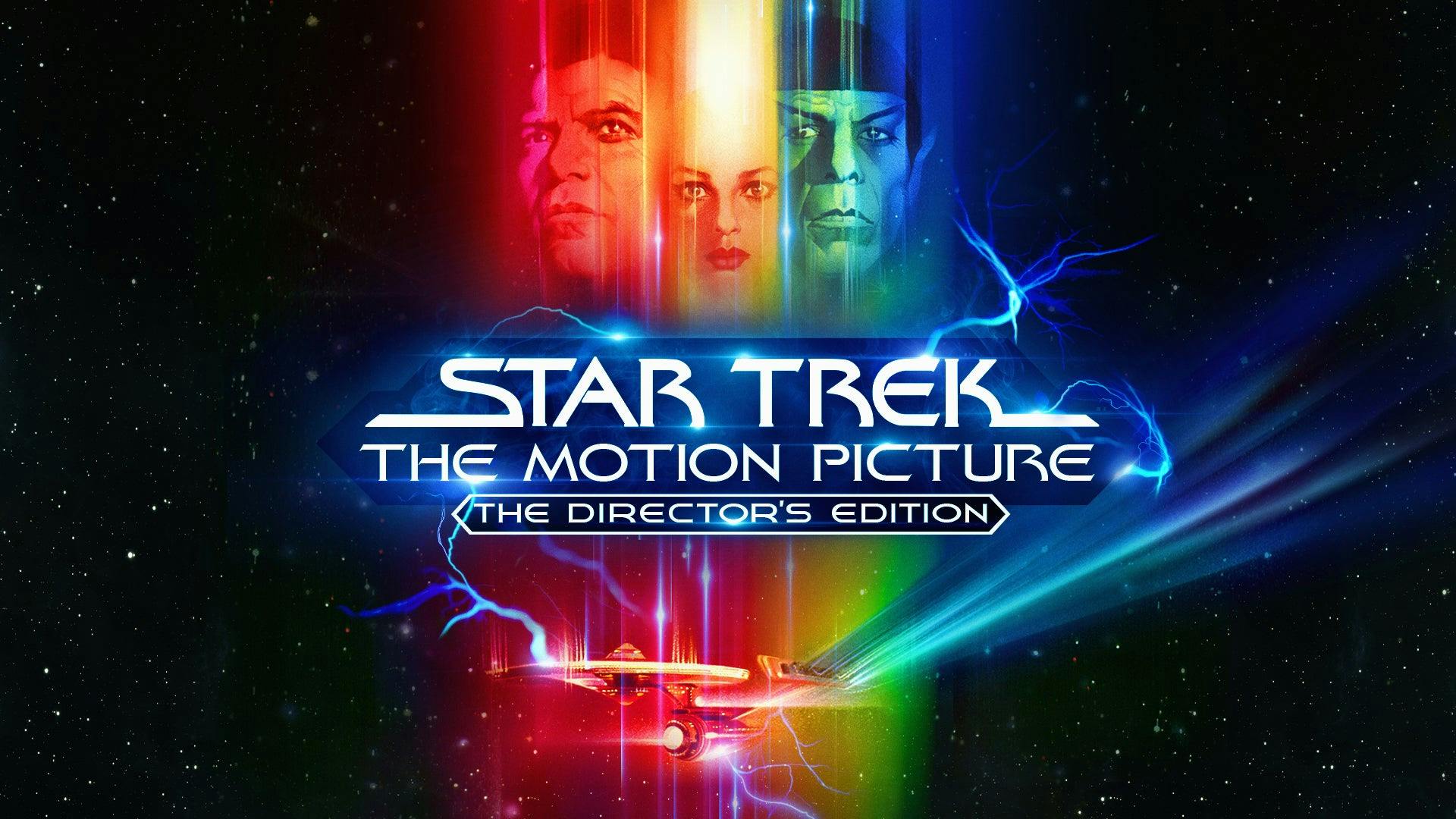
StarTrek.com
Eagerly anticipated by Star Trek fans for over two decades, Star Trek: The Motion Picture—The Director’s Edition will make its long-awaited debut exclusively on Paramount+ on April 5, 2022, in celebration of First Contact Day. The film will be available to stream on Paramount+ in 4K Ultra HD on supported devices and platforms. The newly restored film will subsequently arrive on 4K Ultra HD Blu-ray in September from Paramount Home Entertainment. In addition, fans will have the opportunity to see the restored version of Star Trek: The Motion Picture—The Director’s Edition on the big screen for the first time when Fathom Events and Paramount Pictures bring it to theaters for an exclusive two-day event on May 22 and May 25. Tickets will go on sale Friday, April 8 at FathomEvents.com.
Originally released in 1979, Star Trek: The Motion Picture became the fourth highest grossing movie of the year and earned three Academy Award® nominations for Best Visual Effects, Best Art Direction, and Best Music, Original Score. The film successfully launched the Star Trek franchise beyond the original television series, despite having been rushed to theaters with incomplete special effects and forced editing choices.
Star Trek: The Motion Picture - Director's Edition Remastered Trailer
In 2001, director Robert Wise revisited the film to refine the edit and enhance the visual effects. His updated vision was released on DVD in standard definition and embraced by fans but has never been available in higher definition until now. Meticulously assembled and restored by producer David C. Fein with preservationist Mike Matessino, both of whom originally collaborated with Wise, the film has been prepared for presentation in 4K Ultra HD with Dolby Vision™ high dynamic range (HDR) and a new powerful and immersive Dolby Atmos® soundtrack. Fein and Matessino assembled a team of special effects experts, led by returning visual effects supervisor Daren Dochterman, and utilized the extensive resources in the Paramount Archives to recreate the effects not just in HD, but in Ultra HD. After more than six months of painstaking work, the updated movie looks and sounds better than ever while staying true to Wise’s original intention.
“I couldn’t be prouder and more thrilled to have completed the film in 4K,” said Fein. “Paramount offered unprecedented access to the original elements and exceptional support and the results are stunning. Utilizing the latest discoveries and innovations of modern film production, The Director’s Edition delivers so much more today than was previously possible. It’s an adventure you’ll never forget!”
The Star Trek: The Motion Picture—The Director’s Edition 4K Ultra HD Disc and Digital releases will include HDR-10 and Dolby Vision,™ as well as Dolby Atmos®, accompanied by extensive new and legacy bonus content, which will be detailed at a later date.
Get Updates By Email
David Fein Reflects On The Legacy Of Star Trek: The Motion Picture - Exclusive Interview
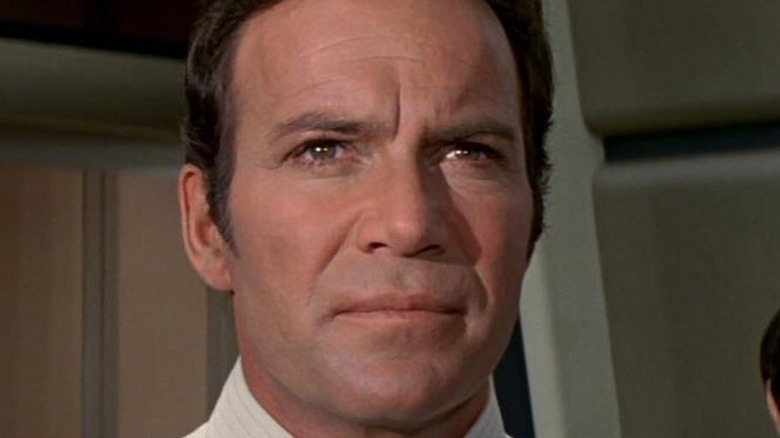
"Star Trek" remains an indelible part of pop culture — it transported audiences beyond the stars to look into what kind of future was possible when humanity starts cooperating with one another. It's no wonder the franchise remains relevant all these decades later, with a plethora of television shows now readily accessible as well as a film series that looks as though it's ready to kick up once again .
It's an appropriate enough time to look back at how far "Star Trek" has come and reflect upon the first movie based on the series to come out — "Star Trek: The Motion Picture." Released in 1979, the film received an update in 2001 when a remastered edition, overseen by director Robert Wise, came out. It brought new computer-generated effects, new scenes, and remastered audio to the proceedings, resulting in a brand new experience for Trekkies from all walks of life to enjoy.
Whether you're a newcomer to the "Star Trek" franchise or have seen the original motion picture dozens of times, a new remaster is now available in 4K Ultra HD. The movie looks better than ever before, and Looper had the chance to sit down to chat with producer David C. Fein, who's overseen the development of "Star Trek: The Motion Picture — The Director's Edition." He spoke on all things related to "Trek," from its legacy to the one scene in the movie that absolutely terrified him upon first watching it.
On changes made to the movie
With the 4K remaster, what, in your opinion, is the most impressive effect altered for this version of the movie?
The color grading and the sound work is stunning. It absolutely helps tell the story better than it ever has before in every way. There's so many things we were able to do with the edit, but now to bring the audio up to the level that we could imagine, and the color work, and the sheer ability to change and perfect so much in the film ... I've often said just about every shot has had some change, modification, alteration — just slightly — to bring it to the point where it really draws you in. The fact that it works better than ever before makes me more excited than I can possibly tell you.
In the commentary for the movie, you discuss how "Star Trek" has influenced real-world technology. What other items from the "Star Trek" universe would you like to see make the leap to reality?
I like transporters because it takes too long to get anywhere. Still, [it's] just as terrifying. This was the first film that scared the hell out of all of us. When you think of beaming somewhere, but then coming together to something that, as they say, doesn't live long — that's terrifying. That idea, plus the medical advances that have happened ... it's funny.
A little tidbit is that when we did the project originally, I got everybody on the project the Motorola i1000, which was a communicator, because we could communicate with each other. I was talking about how this time, you actually could use the Apple Watch as the communicator, which is closer to where motion picture is. But we are getting there every step. Look at the pad that they've used in "Next Generation" and even classic "Star Trek." They didn't show it as much, but that technology is the iPad where we are today.
We keep getting closer and closer, but other than the other standards of warp speed and traveling to other worlds, transporters are a great idea. All I can think of is how we can digitally enhance films and be able to do everything digitally perfected. Imagine if that could happen with a person — not that we're changing personality, but something happens where you could beam and even use it for medical purposes, being able to fix certain problems or otherwise, where we all become ones and zeros. [That] also goes back to the whole concept of the movie of ... technology without humanity is cold.
Touch-tone phones were the most advanced thing at the time. Now we have iPhones with social media. If we even go further with transporters of the digital, where's the humanity in it? It brings up some other interesting questions of ethics, too. If you can make a change, but if you don't like someone and you're not having a good argument — not succeeding in an argument — you beam them somewhere and change their opinion. No, that's too dangerous. But I do love the stories about technology in general.
Terrifying technology
Going back to the transporter, how did that scene impact you the first time you saw the film?
It was always terrifying in concept. I'll tell you a little secret, which, of course, it's not a secret because I'm sharing it. One of the problems that we had early on in the production and went to the DVD version is that the rating of G had evolved from being a film for general audiences to a kid's film. I knew a few things. Number one — this isn't a kid's film, "Star Trek: The Motion Picture." But number two, if we were able to have that rating re-rated and changed to PG and motivated, it would not only represent the film better, but it would also raise curiosity about what could you possibly do to the film to bring it to that level. At that time, I went to my sound people and said, "Bring in everything. I want nails on a chalkboard level of hair standing up on the back of your neck during the transporter accident."
One of the quotes that I remember that I kept going back to is — imagine you are this deformed mass thinking, looking for a way to scream, and you don't have anything to scream from until finally something opens. God, I'm scaring myself. But something opens and that's the sound that comes out. That's what I was going for. That I attribute to getting the PG rating. But it's also the most horrifying death in all of "Star Trek" in some cases. I don't think they did that too many other times. I guess it was frightening.
The legacy of Star Trek
Why do you think "Star Trek" has remained so influential all these decades since the original movie and the original series first came out?
Optimism — absolutely optimism. I am the ultimate optimist myself. I see the positive in everything. When there's something negative, I turn around and try and find the positive in any way to do it. But "Star Trek" always inspires, and it always inspires us to be better than we are, and in the world where we try to do our best, to just be better.
Even in the worst cases, in some "Star Trek" history, there's always a moral to it. I like the moral story. I like where it tries to take us. It's intelligent as well, something that makes you think, and that's one of the things that's made a big difference to me. So many people have been saying that they've seen the film for the first time right now. It's not insulting ... Insulting intelligence is what people say about some films.
It's not spoon-feeding you a story. It's helping you think about what the results are of what's being presented. That's beautiful to give you something to think about. Everyone says that they see this ... The teens and the 20-somethings that are seeing the film are saying they left and [they're] still thinking about it. It's surprising, but that's what great films are — something that inspires you.
That's what "Star Trek" [has] been doing over the years. It gives you something more to ponder [about] how it relates to your life. That was one of the things that Gene [Roddenberry] was doing in classic "Star Trek": "I'm going to tell stories about Vietnam. I'm going to tell stories about interracial relationships. I'm going to show stories about intolerance but have it be aliens." By telling it about some other race, anybody can accept it because it's not us — when it really is a story about us. That's a certain amount of brilliance in the storytelling that "Star Trek" has always inspired. This too.
David Fein's thoughts on other Star Trek projects
With so many different "Star Trek" projects in the works now — "Picard," "Strange New Worlds," "Lower Decks" — are there any "Star Trek" shows on right now that you're a particular fan of?
I've watched "Picard." I'm watching all of them. I enjoy "Lower Decks." I was concerned that it would be a little ... I enjoy the positive nature of the shows. I love [that] the humor is with us, not about or against those who love it. I sometimes feel things like "Big Bang Theory," sometimes tongue-in-cheek, laugh at being a fan. It's important to me that it expresses the love of the franchise and shows it in a positive light in so many ways. [With] "Picard," I'm happy to see that people are coming back, that it's carrying on the same story, but I'm happy about "Motion Picture" too, that "Motion Picture" [is] back. I like focusing on that.
Is there anything you'd like done to the original "Motion Picture" further down the line, perhaps for a 50th-anniversary re-release?
Films are always abandoned. What we have right now in regard to where we are is because there's been so many technological advancements. Bob [Wise] was inspired and inspiring in using all the tools that were available to us to tell the best story. My focus here is when it comes down to a 50th anniversary, Atmos may be even better. There may be ways to improve it.
There's been a rumor that they found that if you dig deeper into the negative of a movie, it may have been light field photography, which is where they discovered that you had the wonderful dynamic range that you never knew before that became HDR. [This] means every film is better than you ever could imagine because it was more photographed. We presented in HDR.
There's some speculation and some tests being done right now to see that everything could have been filmed in 3D. I'm excited about, what are those possibilities? It's not so much how this film would be changed in some way. There's little things that I'd like to tweak here and there. But if those discoveries happen, how much better could the film tell its story? Imagine if everything was 3D, if suddenly now you could take a film and have it be 3D, but not fake, not reproduced, not balanced by an intentional decision, but having it be that way. I'm excited to see what the advancements are.
"Star Trek: The Motion Picture — The Director's Edition" on 4K Ultra HD Blu-ray™ is available now, complete with new and legacy special features from Paramount Home Entertainment. Additionally, the "Star Trek: The Original Motion Picture Collection," featuring all six big-screen adventures with the original series crew, is also available on 4K Ultra HD.
This interview was edited for clarity.
How 'Star Trek: The Motion Picture’s Cerebral Take on the Franchise Remains Fascinating Over 40 Years On

Your changes have been saved
Email Is sent
Please verify your email address.
You’ve reached your account maximum for followed topics.
This '70s Sci-Fi Gem Was Eerily Ahead of Its Time
'the watchers' ending explained: ishana night shyamalan drops a horrifying twist, this underseen 2024 crime comedy has a 100% on rotten tomatoes.
The road to Star Trek: The Motion Picture was a long one. Initially conceived by series creator Gene Roddenberry in 1969 following the cancellation of the original television series, it wasn’t until six years later that Paramount Pictures agreed to begin development on the project. But despite a revolving door of some top writers in science fiction pitching ideas, disagreements regarding the budget and Paramount’s desire for an epic blockbuster led to Roddenberry abandoning the project in favor of a new television show, tentatively named Star Trek: Phase II . Except when that fell apart too, Paramount had a big issue on their hands. Production had been set to begin in a matter of weeks, with a full cast and crew already hired and an entire season of sets and scripts under construction. There was no way Roddenberry could afford to let all that work go to waste, and as luck would have it, he had no intention to either.
The result was Star Trek: The Motion Picture , built from the ashes of Phase II that reused as many resources from its parent project as it could, most notably the script “In Thy Image” that had been intended as the show’s pilot episode (albeit one that got heavily rewritten when the jump to a feature film was made). With The Sound of Music and West Side Story director Robert Wise in the directing chair progress was finally being made, and despite several behind-the-scenes troubles that resulted in hourly script rewrites and special effects being worked on right to the final deadline, Star Trek finally hit the big screen in December 1979.
RELATED: Every ‘Star Trek’ Movie Ranked from Worst to Best
And the result was not what Paramount had been hoping for. While the film was a modest success at the box office, the film received a mixed response from critics with criticism directed at its slow pacing and lack of action. Roddenberry was forced out of creative control for the sequel, The Wrath of Khan , which placed a greater emphasis on action and received a much warmer response in turn, becoming the template future Star Trek films would follow. This also resulted in The Motion Picture feeling like a bizarre anomaly in its own franchise, with a tone in vast contrast to later entries. The slow pacing has led to fans dubbing it The Slow Motion Picture, and it is generally accepted that newbies should skip this one in favor of its more accessible sequels. But to do so would be doing a disservice to a film with more merit than its reputation suggests. The Motion Picture will not appeal to those who prefer films of a more reasonable length with an explosion or two thrown in for good measure, but for those looking for a more thoughtful and cerebral take on the science fiction genre, there is plenty to appreciate.
The film’s story, written by seemingly every writer in Hollywood but credited to just Harold Livingston , sees recently promoted Admiral James T. Kirk ( William Shatner ) taking command of the newly refurbished USS Enterprise as he investigates a mysterious cloud of energy known as V’Ger that destroys everything in its path, and which is currently on a collision course with Earth. And that’s basically it. The script feels like exactly what it is; an episode of a TV show that has been stretched to fit a feature film, and that does create some problems. The plot remains rather stationary throughout its runtime, lacking much in the way of exciting set pieces or even a clear villain that’s more than just a cloud, but Wise takes advantage of the minimalist plot to craft an experience like no other.
For one, nothing in the franchise’s sixty-year history captures the grandeur of space like this. While future films may have had larger stories when compared to the simplicity of this, none of them come close to the levels of splendor The Motion Picture imbues into every moment. The sequence of Kirk and the ship’s engineer Scotty ( James Doohan ) boarding the retrofitted Enterprise lasts six minutes, most of which consists of reaction shots of the two actors as they bask in the ship’s glory. To some it’s an overlong sequence that could be completed in a fraction of the time, but the excellent special effects and grandness of Jerry Goldsmith’s musical score combine to make it an utterly memorizing scene. Beauty for beauty’s sake, a concept that too few films embrace. This same sense of grandeur persists throughout the film, where even the most mundane of moments are presented with enough pomp and ceremony to fill a musical (the echoes of Wise’s previous work can clearly be felt). Space is the ultimate of grand concepts, and with many contemporary films (including some in the same franchise) barreling through entire galaxies in the blink of an eye like the characters are just casually driving down a country lane, it’s refreshing to see a film bask in the wonders of science fiction, where even the most distant of stars glow with the power of endless possibilities.
But the film’s methodical pace also allows for richer characterization than its successors. The friendly comradery between the crew of the Enterprise is gone here, replaced by a coldness that alienated fans of The Original Series , but it’s a decision that allows Wise to explore these characters in new but refreshing ways. Ten years have passed since audiences last saw these characters, and rather than picking things up like no time has passed, it genuinely feels like ten years of hardship have befallen them. Kirk is a far more vulnerable character than his television counterpart, with his unfamiliarity with the retrofitted Enterprise the source of much conflict with its new captain William Decker ( Stephen Collins ). He demotes Decker and takes command of the ship, partly due to his greater experience dealing with such events, but also for his own selfish desires to pilot a starship again after spending the last few years trapped in the offices of Starfleet Operations. It’s a decision that nearly destroys the ship when he activates warp speed, causing Kirk to gradually accept the importance of his crew rather than assuming his decisions will always be correct. It’s nothing revolutionary, but it develops his character beyond being just a standard hero archetype he often falls into, whilst also providing a standalone arc that ensures The Motion Picture feels like a complete feature rather than just another episode of a TV show. Shatner, while never the best of actors, does an admirable job playing a more reserved version of his signature character, and the result is his best performance in the role.
This richer characterization also extends to the film’s supporting cast. Chief medical officer Leonard McCoy ( DeForest Kelle y) is unhappy about being drafted back into action, only softening to the idea after Kirk tells him there’s a thing out there that he needs help dealing with (with McCoy’s response “why is any object we don’t understand always called a thing” being the film’s defining line). Even Spock ( Leonard Nimoy ), never the most excitable of characters, seems more emotionally distant than ever. When he first appears on the Enterprise there’s no grand entrance or reprise of classic Star Trek music as he reminisces with his old friends, he merely appears and resumes his work without even glancing at most of the crew. It’s as though, amongst the vast emptiness of space, everyone has lost their humanity, a feeling echoed by the clinical nature of the costumes and set design. But this is also a film where people strive to be better, where its idea of a dramatic sequence is not explosions and fighting but Kirk and McCoy desperately trying to get Spock to open up about his problems, so they can help him. Sparks of humanity are hard to come by, but when they do, they are cherished like they’re the most valuable thing in the universe. The budding romance between Decker and the ship’s navigator Ilia, while in any other film just a forced addition to widen mass-market appeal, becomes the cornerstone which the entire climax depends on. By the time the end credits roll Kirk and his crew have resumed their close friendship The Original Series thrived on. It took over two hours to get there, but the optimistic future Gene Roddenberry had envisioned is back, and it’s stronger than it has ever been.
The film’s special effects were one of the few elements to receive praise when it first released, and rightfully so, even if it wasn’t an easy process getting there. After the original special effects supervisors were fired following a full year of work that had yielded almost no usable footage, legendary visual effects maestro Douglas Trumbull was brought onboard. His work on 2001: A Space Odyssey and Close Encounters of the Third Kind had earned him an excellent reputation in Hollywood, giving him effectively an unlimited budget to complete years’ worth of effects in just nine months. Work continued right up to the eleventh hour, but Trumbull and his team managed it, and their work remains impressive to this day. The magic of the docking scene or the film’s famous light probe sequence wouldn’t be half as good without his work, and it took several years before the series again featured effects that replicated the brilliance of Trumbull’s work.
Perhaps the most impressive element of The Motion Picture is its villain, or lack thereof. V’Ger, the evil cloud that has been causing everyone such problems, is actually Voyager 6, a space probe programmed to gather knowledge from every corner of the universe, and also something that had been thought lost centuries ago. In reality, it gathered so much information that it achieved sentience, but in doing so became a being of pure logic that began to question its own existence. The reason for its journey to Earth isn’t to cause mindless destruction, it merely wants to question its creator about its place in the universe, with the havoc it is causing being an unintended consequence of its newfound sentience. It’s a remarkable change of pace when compared to the villains in virtually all other science fiction properties whose motivations can often be boiled down to just power, money, or revenge. Instead, The Motion Picture opts for a lonely machine than just wants a purpose in life, and our characters go about solving this methodically and thoughtfully without a trigger ever having to be pulled.
It’s a mindset that encompasses the entirety of The Motion Picture , a film that favors contemplation about the human soul in lengthy scenes full of subtle performances and cleverly written dialogue, rather than hurrying through the dull bits to get to the next action scene. Not that such films are inherently bad, of course. The Wrath of Khan placed a greater focus on action and proved to be a perfectly enjoyable summer blockbuster, but the unique approach of The Motion Picture makes it a film that is long overdue a revaluation.
- Movie Features
- Star Trek The Motion Picture
Log in or sign up for Rotten Tomatoes
Trouble logging in?
By continuing, you agree to the Privacy Policy and the Terms and Policies , and to receive email from the Fandango Media Brands .
By creating an account, you agree to the Privacy Policy and the Terms and Policies , and to receive email from Rotten Tomatoes and to receive email from the Fandango Media Brands .
By creating an account, you agree to the Privacy Policy and the Terms and Policies , and to receive email from Rotten Tomatoes.
Email not verified
Let's keep in touch.

Sign up for the Rotten Tomatoes newsletter to get weekly updates on:
- Upcoming Movies and TV shows
- Trivia & Rotten Tomatoes Podcast
- Media News + More
By clicking "Sign Me Up," you are agreeing to receive occasional emails and communications from Fandango Media (Fandango, Vudu, and Rotten Tomatoes) and consenting to Fandango's Privacy Policy and Terms and Policies . Please allow 10 business days for your account to reflect your preferences.
OK, got it!
Movies / TV
No results found.
- What's the Tomatometer®?
- Login/signup
Movies in theaters
- Opening this week
- Top box office
- Coming soon to theaters
- Certified fresh movies
Movies at home
- Fandango at Home
- Netflix streaming
- Prime Video
- Most popular streaming movies
- What to Watch New
Certified fresh picks
- Hit Man Link to Hit Man
- Am I OK? Link to Am I OK?
- Jim Henson Idea Man Link to Jim Henson Idea Man
New TV Tonight
- Star Wars: The Acolyte: Season 1
- Ren Faire: Season 1
- Sweet Tooth: Season 3
- Clipped: Season 1
- Queenie: Season 1
- Mayor of Kingstown: Season 3
- Becoming Karl Lagerfeld: Season 1
- Criminal Minds: Season 17
- Power Book II: Ghost: Season 4
- Erased: WW2's Heroes of Color: Season 1
Most Popular TV on RT
- Eric: Season 1
- Dark Matter: Season 1
- Tires: Season 1
- Evil: Season 4
- Star Wars: Ahsoka: Season 1
- Trying: Season 4
- Best TV Shows
- Most Popular TV
- TV & Streaming News
Certified fresh pick
- Star Wars: The Acolyte: Season 1 Link to Star Wars: The Acolyte: Season 1
- All-Time Lists
- Binge Guide
- Comics on TV
- Five Favorite Films
- Video Interviews
- Weekend Box Office
- Weekly Ketchup
- What to Watch
The Bad Boys Movies Ranked by Tomatometer
All 73 Disney Animated Movies Ranked
What to Watch: In Theaters and On Streaming
Vote For the Best Movie of 1999 – Round 4
House of the Dragon : Season 2 First Reviews: Gorgeous and Expertly Crafted, with Epic Dragon Fights
- Trending on RT
- The Acolyte First Reviews
- Vote: 1999 Movie Showdown
- The Watchers
Star Trek: The Motion Picture
Where to watch.
Watch Star Trek: The Motion Picture with a subscription on Max, rent on Fandango at Home, Prime Video, or buy on Fandango at Home, Prime Video.
What to Know
Featuring a patchwork script and a dialogue-heavy storyline whose biggest villain is a cloud, Star Trek: The Motion Picture is a less-than-auspicious debut for the franchise.
Critics Reviews
Audience reviews, cast & crew.
Robert Wise
William Shatner
Leonard Nimoy
Commander Spock
DeForest Kelley
Lt. Cmdr, Leonard H. 'Bones' McCoy, M.D.
Stephen Collins
Persis Khambatta
Lieutenant Ilia
Movie Clips
More like this, related movie news.

- June 6, 2024 | Paramount/Skydance Deal Runs Into New Snag, And Now Another Bidder Has Emerged
- June 6, 2024 | Interview: Doug Jones On ‘Star Trek: Discovery’ Finale, Saru’s Happy Ending, And If He Was Ready For More
- June 5, 2024 | Connor Trinneer And Dominic Keating Launch ‘D-Con Chamber’ Podcast; Season 3 Of ‘InvestiGates’ On The Way
- June 4, 2024 | Netflix To Release All 20 Episodes Of ‘Star Trek: Prodigy’ Season 2 In July; Also Coming To SkyShowtime
- June 4, 2024 | Nog Is Faced With A Ferengi Existential Crisis In Preview Of ‘Sons Of Star Trek’ #3
‘Star Trek: The Motion Picture – The Director’s Edition’ New Videos & Theatrical Showings Update
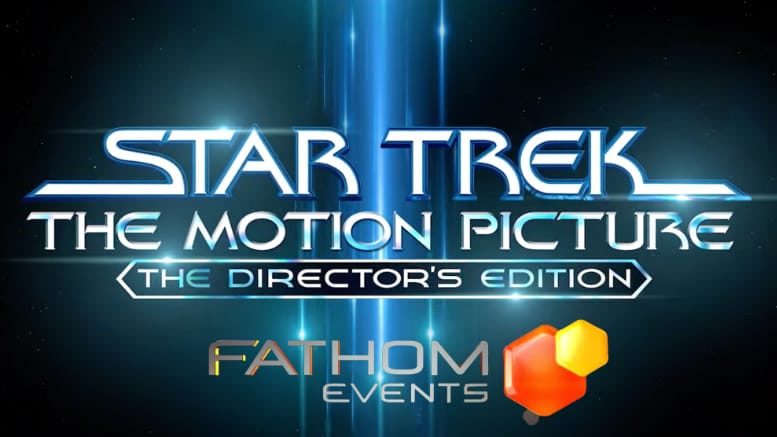
| April 15, 2022 | By: TrekMovie.com Staff 94 comments so far
The newly released Star Trek: The Motion Picture – The Director’s Edition on Paramount+ has been garnering positive reviews around the web. This new version practically demands to be seen on a large screen. So it’s not surprising that we have an update on the Fathom Events showings of film, and a few other little bits of TMP love as well.
Fathom Events adds a third day
Initially the showings were scheduled for only two days: Sunday May 22, and Wednesday May 25. Now Monday May 23 has now been added. Tickets are on sale now at fathomevents.com. Fathom also put out their own version of the DE trailer, included below.
Showings should be high quality
More good news about the Fathom showing comes from a fan asking producer David Fein on Twitter about the quality of the showings (hat tip to @StarTrekVisComp for calling attention to the interaction). Fathom events uses a variety of delivery mechanisms, including what is effectively just a special Dish Network satellite feed, so these events can have a wide variety of quality levels depending on the delivery mechanism.
Fein responded that he is expecting Fathom to use a Digital Cinema Package, which is the industry standard method for delivering feature films to movie theaters. So the quality is expected to be as good as any other current film distributed to theaters.
This is good news! This isn’t going to a stream shown on a big screen, it’s an actual Digital Cinema Package! https://t.co/fuKr4IU8ot — Star Trek TMP Visual Comparisons (@StarTrekVisComp) April 13, 2022
The Director’s Edition team talks Trek and Robert Wise
Last week Paramount+ released a fun video that features the Director’s Edition team discussing their fandom and their mission to bring director Robert Wise’s preferred cut of the film into the modern era.
4K Theatrical and Director’s Editions Compared
YouTube movie fan My moonization has already grabbed a few scenes from the 4K/HDR versions of the theatrical version of TMP that was released in 2021 and the new Director’s Edition to compare.
The video is available on YouTube in 4K and HDR with compatible displays, and is best viewed on such equipment.
Find more news about Star Trek: The Motion Picture at TrekMovie.com .
Related Articles
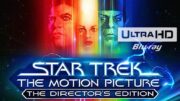
DVD/Blu-ray/Streaming , Feature Films (TMP-NEM)
Review: ‘Star Trek: The Motion Picture – The Director’s Edition’ Stuns On 4K Ultra HD Blu-ray
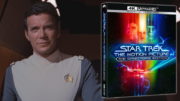
‘Star Trek: The Motion Picture’ Directors Edition 4K UHD Blu-Ray And TOS Movies Collection Coming In September
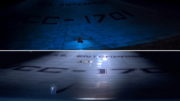
12 Most Fascinating Updates For The 4K ‘Star Trek: The Motion Picture – Directors Edition’
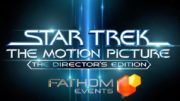
Conventions/Events/Attractions , Feature Films (TMP-NEM)
Reminder: ‘Star Trek: The Motion Picture – The Director’s Edition’ In Theaters Starting This Weekend
I hope some one goes back to fix that god awful rotoscope meeting with Kirk, Spock and McCoy, it’s like watching 1970’s Doctor who effects. I appreciate what the effects artist wanted to put right but it is so jarring that I suggest putting the original shot back in.
If it’s the lounge scene you’re talking about – I think the only way to fix that sequence is to add some closed shutters over the windows and just color-correct the hell out of the costumes, hair, and makeup! I would prefer a weathered wood shutter – – or perhaps some Hello Kitty! or Peppa Pig curtains to appeal to a younger crowd…
I would also like to suggest some laser hair removal on Kirk’s arms – – Paramount’s 4K transfer without a remaster of the camera original has not been kind to William Shatner…
Funny you mention Shatner’s arms. When I first saw the movie back in 1979, one of the (many) things that bothered me was that Roddenberry had made him shave his arms (and chest!) for the cheapie TV show but NOT for the multimillion-dollar Motion Picture!
Yes, on the Director’s Edition I streamed with friends last week, I couldn’t not see the hair on his very light skin in places it shouldn’t have been (and a couple of shots where the applied foundation and powder was obvious) – – I saw this once in a theater when I was in school and never noticed that.
I kinda feel bad for him – I feel like Mr. Wise would have taken better care of the actors supervising the 4k transfer than Paramount has…
As long as they remove the matte lines around Shatner’s toupee, I am fine with it…
brilliant, I’m going to steal it and claim it as my own with my friends!
I agree, that scene takes one completely out of the experience – the rotoscoping especially and those terrible window frames which look as if it was done by a Photoshop newbie. Even the SD Directors Cut version of this shot will suffice. Otherwise, this release is just superb!
Exactly. It’s too distracting.
It’s kinda crackin’ me up that the comparison YouTube video wastes time comparing the unsalvageable rear screen with Kirk and Scotty in the shuttle pod!
And the V’ger cloud as well.
One is an affront WTF moment and the latter is a steaming-pile-of-poop at any resolution WTF moment! : )
I wonder if we’ll be able to sneak cocktail into the movie theater for a drink every time Spock’s uniform changes color!!!
Just the color correction alone makes me want to see the new version.
Nice video on the comparisons between the Directors edition and 4K version.
1st time I think I ever saw Jerry Goldsmith’s pic.
There is some great music in that video.
This would be something if there were still some good theaters left. I’m in a pretty large metro area and there are exactly ZERO good theaters here. None. Nada. It’s why I rarely go to movies anymore. All the theaters are in malls now. Ugh. And the largest auditorium in most of those is 1/3 the size of the old giant screen theaters of just 10 years ago. This would be something to go see but alas… Nowhere good to see it. I’ll just have to be content with waiting for the disc to arrive this fall.
One reason to see it at the mall is the theatre probably has a better sound system than you have at home.
Can’t argue there. What they lack in size they make up for in sound quality. But I still like large auditoriums. Even the IMAX they have here don’t feel all that big. Hence the term “Lie-Max”. When I hear about IMAX I still think of the 4 story high screen at the first IMAX screen I ever saw. The Pictorium at a local amusement park. IMAX at the multiplex aren’t even the size at the two largest screens at the old Century Domes that were torn down recently. (Where I saw TMP back in 1979!)
Yes, people generally assume that all IMAX screens are the same but they are not. By the way, I first saw ST TMP in 1979 at the KB Macarthur Theatre in DC, which had the world premiere (where most of the cast and crew first saw it).
TMP is the gift that keeps on giving. There are more articles for it than any other Trek Film.
I don’t get it, honestly. I thought it was a really bad film and I don’t want to watch it again. I saw someone say it represented what Trek is really about and I thought it was a sick burn, but they meant it as a *positive*…
Some of us simply love it. I get that it’s imperfect, sure, but I deeply admire its ambition, as well as an awful lot about its execution.
Hell, Jerry Goldsmith’s score alone would have it high in my own personal rankings even if I hated everything else about it, and I love much else about it, so…
I don’t really understand it either. It seems to be a lot of nostalgia by people who saw it when it was first released after waiting for years, and many false starts, to see live-action Trek revived.
I’m trying to get through it but I can only take about thirty minutes at a time.
That is how I am tackling it too.
I saw the ‘original’ version last year for my grand rewatch of the franchise. It’s probably been 20 years since I watched it. I saw the whole thing, but after watching it, I could wait another 20 years until I watch it again. ;)
But since everyone was talking so much about the Director’s Edition and being on Paramount+, I thought the new effects alone would make it more interesting and tried watching it again. It doesn’t. I got through 30 minutes of that before I gave up again and ended up watching First Contact instead (on First Contact day). It’s just too dry for me.
It’s historic whether you like the film or not. Every Trek since then (up to the present moment) uses the aesthetic those designers created in that movie.
I sure hope this event comes to Canada. So far, no sign of it. ☹️
I watched the 4K version yesterday. It is a visual and audio masterpiece. The story is still a little dry, but the 4K version has helped me appreciate it more. Plus, I never caught on in the theatrical version that the Vyger cloud dissipated and the ship orbited the Earth. That was cool!
I’m there for it.
I like how at 7:19 in the comparison video they switched the deflector dish color from blue to yellow/orange. The rule was supposed to be yellow/orange at impulse and blue at warp. This was just calling for continuity errors that occurred throughout the movie. In the following movies, they just left it blue at all times, which was easier to manage.
I think that kind of thing is more reliable in the later films where ILM was in charge/involved. TMP was chaos in motion. I’ve heard stories from guys in post (unfortunately NOT confirmed by Mr. Wise who had no recolection) that they weren’t getting workprint of a lot of the effects footage and some of the camera original so they were literally examining the negative for action and color match and logging it for the negative cutters!
If that doesn’t mean anything to you – all of the color registration and value is some degree of opposite, add exhaustion to that and I’m sure light burnt orange vs light blue looked similar enough!
I’ve never worked under conditions like those for people involved with TMP – so many really bad decisions beforehand, contractors with big promises that never delivered, and management at every level at Paramount that really had no idea what they were doing. In many ways, I still feel it was unfair of the DGA to refuse to force Paramount to take Mr. Wise’s name off the film.
It’s unfortunate that most of the VFX, post, and principle department heads remained silent in public in order to be good little Hollywood film workers. It really is a miracle that anything at all cogent made it to the screen. That’s a testament to the incredible talents of the below the line crews and managers – and, honestly, they’re love of Star Trek. So many of the contractors ended up making far less than minimum wage with all the hours and the taxes, at that time on overtime and overtime penalties. But, that and the silence is the old school Hollywood way.
Nonetheless, it is one of my very favorite movies to play drinking games with – soooooo many opportunites to spot a DRINK moment packed into one movie!! Great to see with friends. I wish there were talk out loud screening of the film to have that kind of fun – – I have a feeling, at $20 a pop, these screenings will be full of shhhh-ing and kicking of seats. : (
I’m really starting to wonder what your bona fides actually are. The crew I’ve talked with about TMP (about 25 or so, spread out over the last 30 years) have never voiced any kind of complaint about the money — in fact, guys like one of the Apogee folks who did the transporter, Mike Fink, told me that not having a day off for something like 7 or 8 months was one of the best things that happened to him financially.
Still not seeing you cite anything like a source for the ‘Wise wanting his name off the film’ thing, which you’ve now repeated in at least two threads. Again, if that were the case, why would he have pushed so hard to finish on time? Would Paramount have gone after him with lawsuits? The backlash over that would have been worse than even missing the release date.
There have been plenty of outspoken vets of TMP, dating back to even before the film came out. So the idea that folks were seriously circumspect about certain matters — outside of Yuricich, who clearly considered being a company man was just part and parcel of his professionalism — just doesn’t hold water.
I’ve read a lot too on TMP, and his comments just don’t add up to anything that I have come across? I would of course be extremely reticent to accuse someone of just “making shit up,” so I am willing to be swayed differently if this dude ever cites any sources.
My feelings about TMP these days pretty much boil down to this: while it certainly has its share of significant flaws, it’s probably a better movie, better science fiction, and better Star Trek than many give it credit for. (Interestingly enough, my opinion on TWOK is precisely the reverse.)
Unlike you, I prefer the 2001 Director’s Cut to the original theatrical version, and am very much looking forward to seeing this latest souped-up re-release on a big screen, since I don’t have Paramoynt +. In anticipation I’ve finally started to read Neal Preston Jones’ RETURN TO TOMORROW, which I had purchased at Loscon years ago but had never cracked open until this week.
I’m really glad you are getting into RtT … while there are some errors or misremembrances from interviewees (confusing Steve Bochco with Bill Norton, thinking Dennis Lynton Clark wrote part of SILENT RUNNING when that was in fact Bochco), and the book has a significant amount of redundancy (sort of like TMP’s near-constant reminders that the thing is x-hours away). this tome is just an awesome achievement and a very useful reference.
You may hit a wall in the VFX section, which lives in the weeds for awhile, but stick with it.
Well, you could have asked Mr. Wise or any of the other department heads or Execs, with all your years of interviewing experience of all the people that worked on the film… or perhaps your “inside knowledge” speaks to what all of these people thought of you and the press junket interviews they provided you.
A researcher that actually works in the industry, of course, could just ask the DGA, or actually look it up (which seems all you do) in ANY of the industry trades. You do know how to look up a DGA dispute, don’t you? Research Hollywood Reporter ? Documents and memos in the AMPAS holdings?
Or perhaps you’re just a Paramount tool trying to whitewash the history of the film… that would surprise me least of all. Ditto to your minions on this site and you and their conspicuous lack of citations and disclosure.
‘Minions,’ really?! Perhaps your research time would be well-spent assessing why Daren Dochterman didn’t bother rotoscoping-out those arm hairs on Bill Shatner that Robert Wise put on film for all the world to see back in 1979. Now that would be hard-hitting film journalism!
Looks like they didn’t approve my lengthy and detailed reply to BEEDEE — it has been many hours now and my other posts made since then have appeared. If that one doesn’t show up, it’ll be an indicator about whether I’ll continue posting here, so either way, thanks for calling him on the ‘minions’ nuttiness, Michael. We’ll probably never see exactly eye-to-eye on the merits of the TMP reworkings, but there’s definitely respect that is maintained anyway.
No hidden message there. Extra long posts get flagged for moderation. I approved it earlier today.
Still bringing the fun, I see!
Though I have written and sold nearly 400 articles on film production, I have never been on a ‘press junket’ in my life. About the closest I ever came to that kind of travesty was a group phone call with several other journalists where each got to ask Patrick Stewart a single question. Even the rare set visits were solo, and I’ve never written PR-style flack, even on the occasions (always declined) when an interviewee offered to augment the wages I was getting from an outlet. I got started writing for CINEFEX, which pretty much always tried for a ‘just the facts’ approach, so that should give you an idea of my headspace with respect to spin. That’s not to say you don’t face RASHOMON-type situations, but you do follow basic journalism tenets to confirm which viewpoint seems to be supported by evidence, and when the need arises, you either omit the dubious passage or put in a qualifier, so as to not become part of an incorrect record that will then be repeated as fact ad infinitum.
Shoot, just the fact that I have run afoul of ILM, resulting in a near-total ban for the better part of a decade, for daring to call one of their PR folk on an outright falsehood about TREK 09 (something that was already documented here and elsewhere), should speak volumes to my integrity, and if you can’t be bothered to ask or do research, that speaks volumes to your lack of same, and points to a lack of credibility.
As to ‘my minions’ … it is to collapse in giggles at the very thought. If I have any minions, they clearly utilize advanced stealth technology. If most of my views aren’t generally considered to be minority opinions (from STV to The Craig Monster infesting 007), I don’t know whose might be.
It seems like you are taking a Trump-like position of attacking based on the opposite of truth — suggesting I’m a Paramount stooge really is a scream, given how many times I dismissed a certain senior trekbbs poster’s deliriously pro-studio comments for the same reason. (Though I still feel justified about that.) Plus I’m the guy who for years was practically the only person on Earth refuting all that crap about Klingon blood color being ratings-related, and that is specifically because I don’t believe in ‘printing the legend’ just because Rick Berman said something on the record without any basis in fact.
By the way, consider occasionally answering a question instead of covering by asking other questions. That would also speak to credibility. The other alternative would be for you to ignore my question, which you did in the other thread. Of course if you do that enough times it will also suggest you’re posting to run your mouth instead of to actually offer data.
I’m not in L.A and so can’t just go down to check the archives like some other folks (at least one of whom seems to make a living by paraphrasing what he finds and then making up a bunch of stuff that enhances the narrative in a series of books that make a travesty of real journalism), but if you would point to any SPECIFIC record supporting your Wise/DGA thing, I would welcome being corrected. Unless of course that is too much trouble for you to go to …
The one point we do both agree on is how much Paramount still seems to be intent on spinning the facts about TMP. That they were still attempting to censor stories about it in the 00s — I helped Ross Plesset with his FILMFAX piece on P2 and TMP and that ran into this head-on … Paramount wouldn’t provide images till they saw the article, and then after seeing it still wouldn’t provide images, even though it was far from a hit piece, just honest) and then wouldn’t provide images for RtT in the 10s is ample evidence of that.
Note that I’m not trying to end on a conciliatory note on that matter upon which we do seem to agree. I’m just acknowledging the validity of the statements you’ve made with which I concur. Now if you’d actually provide a bit of support for your other positions instead of coming to ludicrous conclusions about me, maybe we’d both be starting to get somewhere. Until that time, I may have to consider the bulk of your output to be, as the ship’s computer says in DARK STAR, “False data.”
hey kmart, you and I have had our disagreements here, but I have never criticized the journalistic level of info that you have brought to the table over time on this site, and you frequently cover the sources of your info as well.
I find it very telling that this dude, when asked to provide some citations for his unusual information which none of us have heard of before, instead responds with a personal attack on you.
His response is not at all helpful into me giving any credence to this kind of alternate info he claims to know on the making of TMP. And yes, you are correct to point out the analogy of the Trump-like behavior he is exhibiting here.
Memo to Bee Dee: “Where’s the beef?”
thread closed
If this Wise/DGA and TMP VFX salary issues come up in yet another thread (this was the second one with the Wise wants his name off the film claim), will the discussion be allowed to play out or will that be an instant thread-closer?
Am asking because I already got a friend to ask: a film scholar who did a research book on TMP about Wise and a TREK TMP jr VFX person about the wages.
I would just LOVE to drop those reply-bombs onto BEE DEE’s next missive.
So instead of providing some citations for your information which no one apparently has heard of before, you go all personal attack on kmart? Seriously?
Well you just answered my concern on whether you might be “making shit up.”
Thanks for clarifying that.
Am I the only one who thinks that this “color fixing” they did in many cases washes out the intended colors of the scenes? And the Starfleet shuttle station in SF — the original looked a hell of a lot better than the replacement CGI scene…why replace that awesome background?
Excellent question. Of course, the whole decision to invent new shots for San Fran and Vulcan when there were finished but not included ones available from 1979 seems very curious to me, both decades back with the DVD DE and now again today. Also, for San Fran, they could have gone back to the original early evening warmth color scheme that we never got to see, because in ’79 the color timing folk at MGM wrecked those paintings in the theatrical by cooling the color down, effectively making excellent matte paintings into things that looked like, well, just paintings, with bleak and unconvincing skies.
Along with an establishing view of Vulcan that wasn’t tarted up, there were at least two SF shots that didn’t make it into the theatrical, a side view of the bridge and a close view of the shuttle going by overhead (the latter is seen in the long unreleased theatrical trailer, the former glimpsed in still form in an old ENTERPRISE INCIDENTS magazine), so swapping from those high-rez images and the theatrical originals to the low-rent 2001 CG (and now the to-my-eye very flawed 2022 CG) makes no sense … unless these efforts were more about putting a new stamp on the film than fulfilling the mandate to make it as much like the theatrical would have been if they’d had the time back then.

Hey, I remember seeing that unused shot back in the day, probably from that issue of E.I. that you mention. Nostalgia is cool! But I still prefer the modern take on 23rd century San Fran, and the new Vulcan matte over Yurichich’s original, sorry.
Yeah, we definitely have differing tastes in this case. I’m a huge admirer of Yurichich, but don’t consider the TMP shots to be amongst his best work, and only wish they could have done a complete reworking of the SF tram station while they were at it.
I think the best matte shots in TMP are Rocco’s: the closer view of the tram station in the Sonak/Kirk two-shot (though I still can’t find the Coke can he put in there somewhere) and that unbelievably good close shot of the top of the saucer when Spock’s shuttle does the flipover prior to docking.
I think Y’s best shots were the discarded ones, his first attempt at Vulcan, plus the side shot of the bridge I linked to in one of these TMP threads yesterday (I thought it was this one, but I don’t see it today, so maybe not.) The wide tram interior was DOA just from the design, there’s no way you just paint people standing there and leave them static for such a long stretch without blowing the game in a pretty embarrassing way. In particular I was very disappointed with the Enterprise cargo interior, which might as well be a painted backing from GREEN ACRES THE MOTION PICTURE for all the credibility it carries. Then again, I always thought they should have done that shot as a miniature, and only used a bit of matte painting to tie it into the live-action.
Which ‘original’ – 1979 or 2001? Not that I’d agree in either case.
Seeing movies in a movie theater is always the best way to see them. I saw a washed out pink print of the theatrical release of this and as bad as the print was, this movie played slightly better on a big screen. Can’t wait to see this beautiful remaster on a huge screen.
And I just noticed the weird titling up front — like it’s some cheap “bronzing” of the great looking original efficient white look…Why???
The original white was all because of the rush to get the movie out to avoid lawsuits that would bankrupt Paramount. Wise didn’t like them!
I have to agree about the ‘bronzing,’ myself, which comes across as a little cheesy, a case of literally gilding -the-lily. But it’s not a deal-killer.
I think it’s so corny and bad
So is it as bad as the 2001 DE version? Cuz that, along with FIRST CONTACT, rank as the worst ones I’ve seen to date, though GENERATION’s also have an inappropriate feel IMO.
I saw a pink-to-red faded TWOK at a revival house 15 years ago and it was ghastly — went home and rewatched the thing on DVD just to wash the bad impression from mine (though part of the bad experience was the theater playing ‘in old monterrey’ on their speaker system over and over for 20 minutes before the movie started — it was like that early scene in THE WEDDING SINGER, but not funny.)
I can honestly say that from the early 2000s up through 2012, digital projection was so bad it pretty much killed the whole moviegoing experience for me (I did see 35mm prints of THE MANCHURIAN CANDIDATE and 2001 during that period, and those were excellent as ever.) After that I found a theater that played GRAVITY properly, but since then, the only time I’ve seen a movie projected properly — and the last time I set foot in a movie theater — was SEBERG, and that was at a press screening where nobody but me showed up.
That’s pretty massive disillusionmant from somebody who for nearly 20 years regularly saw at least 150 movies per year in the theater. There’s nothing like seeing a great movie projected properly with a good crowd (opening night for CE#K was incredible!), but I don’t consider it likely that those aspects will ever all line up again in a way that is worth the trouble at this point, short of LARRY o’ ARABIA in 70mm turning up locally.
In general, I agree with you. But I have seen some very good theater presentations in legitimate IMAX theaters in the past decade, including TENET, the las two MI’s, The Last Jedi, Interstellar, Dune and Dunkirk (note, I am not commenting on the quality of these movies, just the theatrical presentation of them).
I watched DUNE on my phone, my pretty decent home theatre, and in IMAX, and was bitterly disappointed in each and every format.
Michael, it sure sounds like you gave it a really good try. Did your disappointment stem from the same factors, regardless of presentation type? I’m asking as somebody who really likes the new version, even the parts I don’t agree with in terms of approach and execution. And I’ve only seen it on my decent-sized TV.
I’m also thinking that some of the anomalies in part 1 will pay off in part 2, but that’s my read based on talking with the editor, who was very open about most stuff but honest in noting he couldn’t go there about certain other aspects that I’m guessing will resolve in the next film. It does have a certain arid quality (perhaps intentional? the movie-experience equivalent of actually being IN a desert?), almost a Kubrick-like detachment that seems totally at odds with the Lynch version (which I love regardless of defects … I sometimes think of that as SF’s equivalent to ACTION JACKSON, where you wind up laughing when you realize the smoke levels on indoor scenes is so high even in night scenes that the moon must be perched 10 feet above a mansion’s skylight to give this kind of illumination.)
I have tried to watch Mann’s HEAT so many times but just can’t get past the first 45min or so. Keep thinking the next time I will just jump to the big gunfight everybody talks about to get myself hooked, then back up and try again. That’s how I finally got into Herbert’s novel, I jumped up to the banquet scene about 140 pages in, finally found some passages I dug, and then went back. Took me from 1972 till summer 84 to manage that!
Oh God, where to start? Though I’m not a Dunatic, I had high hopes for this adaptation based solely on Villenueve’s ARRIVAL, which I consider to be one of the very best SF films of this century, and (with the possible exception of 2001) the best film about first contact with aliens ever made.
Instead, I’m bemused to find myself in the “kmart contrarian Trek 5” ™ position of stating that, for all of its excesses and narrative flaws, I vastly prefer the 1984 Lynch version. For one thing, it has much better production design, in my opinion, clearly delineating the various planetary environments and the aesthetic preferences of their inhabitants. In the current version, it’s all just Brutalist architecture that doesn’t distinguish anybody. And this leads into another issue: the utter lack of what your former boss Fred Clarke referred to as that “sense of wonder.” For all its technical polish, there’s nothing in the 2021 DUNE to compare with the image of thousands of Atreides frigates rising up to dock with the massive Guild ship, or the navigator using his spice-enhanced powers to tie two distant realties together. (If Villenueve meant the frigates rising from the ocean, which made about as much sense as it did in INTO DARKNESS, to have that kind of impact, from where I sat it was a poor substitute.)
Most perplexing and frustrating of all, though, is how little the current DUNE accomplishes narratively in its running time as compared to its predecessor. I watched the film three times, and just a few months later am hard-pressed to think of any major scenes or plot point that Lynch didn’t also address with almost twice as much ground to cover. Both versions suffer greatly from omitting scenes, character moments and other connective tissue that helps to explain who these people are and why they do the seemingly outrageous things that they do. (Just one example: the dinner scene, which not only codifies the Atreides’ sense of noblesse oblige but gives the audience some insight into Arakeen society that can’t be found anywhere else in the story, it all being pretty much about the Atreides, their enemies, and the Fremen.)
Sure, there were things I liked better this time around: dropping the turgid voice-overs, the technical polish of the cinematography and effects (though I liked the design of the ’84 sandworms better), the more sophisticated approach to Paul’s visions, and a few other things. But overall, I found the whole movie to be a two-star, emotionally joyless experience, and given my expectations the biggest genre letdown since Tim Burton’s remake of PLANET OF THE APES.
If we had a legit IMAX theater up here, I might have nibbled, but I don’t know that there is one less than several hours’ drive distant, except for OMSI, which I’m pretty sure doesn’t show narrative feature films. Just realized I haven’t seen anything in IMAX since the late 80s!
“Just realized I haven’t seen anything in IMAX since the late 80s!”
Well there you have it. Yea, you do need to find a legitimate IMAX theater, not a pretender, before you can conclude your comparisons here. Here in CA, there are several in SoCal and two in the Bay Area that I like, plus I have been to a couple Collider special screening invites to the IMAX corporate theater near LMU in LA.
Oh, I live in LA, and it’s one of the few remaining perks of the place is the generally above average quality of projection. Audience experience can fluctuate, but usually, sight and sound is in the area of peak performance.
Every time I pass the defunct Cinerama Dome on Sunset, where I was privileged to see ‘2001’ in all its glory a million years ago, I give a silent salute.
Are they trying for landmark status? I’m wondering why if it is shuttered that they haven’t torn it down, be keeping with how progress winds up trashing all the nice architectural art in the world.
Pretty sure that is where I saw 2001 in 68 as well. My mom took me down for a short vacation to go to Universal Studios and I talked her into taking my picture in front of some grand theater playing 2001, in front of the moonbase poster. After that it was easy to get her to take me in to see the movie, but I was such a mess afterwards (it blew my 7 year old mind as well as my soul, didn’t know what to make of the last section, though the rest of the movie probably played like a NASA recruitment film the way TOP GUN did for other kinds of people decades later), we held off on Universal and only did a partial day there. Really wish she had coughed up the photo albums at some point in the decades that passed, because there was a great pic of me standing next to a life-size statue of the Phantom of the Opera. Just as she took the picture, the ‘statue’ reached out and touched my shoulder, and in the still, I’m like a vertical blur, practically leaping out of my skin!
I saw 2001 there not in ‘68, but more like ‘74 or ‘75, on a field trip from Huntington Beach High School. My English teacher, Betty Needhoff, was a huge fan of the film. I remember enjoying the screening well enough—hey, it was a day off school—though it wasn’t my first time seeing it, and I never had any trouble following the plot as I’d read Clarke’s novel many times by then. But of course my passion for that movie has grown by leaps and bounds in the decades since, and I’d kill for the chance to see it in Cinerama again.
It’s the only star trek I’ve never seen, and I’m going to watch it today on my new 13 foot screen and 4k digital projector. Hope I’m not let down
and again, Canada is left out in the cold. Getting really sick of this crap from Fathom.
Some of the effects and color changes are very welcome. But why have they deleted some of the background sounds and voices?! There is no more computer voice announcing “travel pod available at cargo 6. Travel pod available, cargo 6.” And that computer voice is now 100% missing from this new cut. It was also heard in engineering during a pre-warp checklist. Kirk also doesn’t tell Uhura “ viewer off” twice in the rec deck after the horror of watching the destruction of the Epsilon 9 station. This underscored her shock and the magnitude of the moment. How are these changes improvements that are aligned with the director’s vision when Wise himself could have made these changes when he was still alive for the 2000 cut. It all looks great minus the cheesy Babylon 5-looking cheap CG shot of Vger at the end. That shot is worse than something a high school kid with a laptop could have done.
The 2nd ‘viewer off’ WAS eliminated for the 2001 version.
Got to admit, that one was pretty inexplicable to me — it was an interesting character moment in a film that isn’t exactly overflowing with them.
I think they just didn’t want Kirk to have to yell at Uhura.
That’s very probably true — I even recall the “Director’s Cut” producer touting that Kirk is more likable in the current cut. I don’t see that necessarily as a plus, myself. But I still think it’s a better, more polished product overall.
A lot of fans were critical of Kay Anderson’s CFQ review of TMP where she claimed Kirk comes off like a finalist in a ‘prick of the century’ contest (which ain’t far off the mark, to be honest.) I think Kirk’s weakness in the film comes from some of Shatner’s eccentric choices. His ‘no’ when denying ilia probe’s demand isn’ the ‘no’ voiced in the novelization (a spot that GR got right), where Kirk says it flatly, hard, not in this cutesy self-conscious way. Having said all that, I really do like how he does the ‘out there’ part, it feels like real Kirk again, one of the only times in the whole films series where that happens for me.
Roddenberry’s TMP novelization is a fascinating ’70s curio, showcasing his strengths and weaknesses as a writer/futurist/guru. There are some details that the movie frankly would have benefited mightily from, such as Will Decker’s background, which helps his willingness to merge with V’Ger at the end of the film to actually make some sense.
I think it’s possibly that, possibly just wanting to shave a second off the new cut
I take it you’re not familiar with the 2001 Director’s Edition. All of those are changes Wise wanted and approved in the 2001 version of the DE.
I found that I missed the deep baritone computer voice saying a pod was available. If I recall, the announcement is still there on the Director’s Cut DVD but it’s a different voice.
I miss the computer voice, too and the original Klaxon alarm. In the theater, it (klaxon alarm) scared the heck out of me but it delivers on the alert status and then some. The new one is less, much less. In Susan Sackett’s ‘Making of’ book, there’s notation of the actual Roddenberry memo to insert the alarm and voice that was in the original ’79 cut.
I’m just thinking,to myself, when Wise did the DE, he never liked the dramatic tone of the alert and since Roddenberry had died 8 years or so prior, he (Wise) would have the now final say. Oh well.
I’m looking forward to the actual theatrical showings in DCinema. Perhaps, it will play better with the updated sound. However, to me, I felt mass and movement in the theater sitting close to the front of the screen. When your field of vision is wide as the screen with no disturbance and you take in that stereo sound, you move with the action. The warp drive jump is a good example. When they make that first jump, I literally felt the urge to move back in my seat viewing the colorburst, ship warping and sound effects. Upon subsequent viewings, I turned to observe several audience members movement, too, during the same scene.
On my subsequent viewings of CLOSE ENCOUNTERS in the theater, I made a point of watching the opening at the very back of the theater, so I could see all the seats ahead of me rock backwards during the initial explosion of light and sound at the end of the brief opening credits. Then I’d go take a seat further up front to take in the splendors seen in the rest of the film.
Reminds me of The Simpsons gag where the THX logo causes eyeglasses to shatter, heads to explode, etc.
I hate the sound mix of Christopher Nolan’s films for precisely that reason. You don’t have to listen to APOCALYPSE NOW at a level where the explosions or the music will damage your hearing to understand the dialogue or have a great immersive experience. Why is that so hard?
I ‘hear’ you … we’re getting used to using the subtitles and keeping the volume down low, as my wife’s tinnitus (she has two kinds, one in each ear) has probably been caused by 13+ years on plaquenyl (which is also probably why she went from fine hearing to 80% loss in the last year.)
I’ve always had a hard time understanding different dialects (and don’t even get me started on Bane!), but the last few years of shows on the tube seem to have gotten more problematic, maybe because the voices are mixed lower than the sound effects, which in movies seems to have been a problem from around LETHAL WEAPON 2 onward for me. Sometimes I’ll spend 20 minutes playing with the settings just to see if I can find something that works for me before I really embark on watching a new series, but I don’t fancy myself as Harry Caul in THE CONVERSATION and so I have to feel my way to a sound that works rather than just knowing the magic switch to throw.
One more thought about being at the back to watch audiences in front of you react to the movie: once upon a time there was a parody movie called THE GROOVE TUBE, and in one skit on venereal disease, there is an odd looking puppet giving the PSA. Gradually, audiences realize that the thing talking is not a puppet, but is in fact male genitalia. That is where I first noticed the wave effect, because people up front seemed to figure it out before people further back, but it was like a slow-motion shockwave in a well-filled theater. I saw the movie again on dvd a couple years ago, and the effect, while anticipated and therefore not shockingly funny anymore, is what I can only characterize as a ballsy bit of filmmaking.
I don’t know why but I miss that too. The Klaxon was superior for sure. The computer voice, well, I can see why you would change it for a human crew, but for some reason I just miss the comp voice. Maybe they could have kept the comp voice for some automatic functions (like the travel pod being available). Or the emergency alerts.
The wide shot of Vger is way better than the one from 2001, I can live with it.
Hope this post of mine doesn’t get the whole thread closed, but the quality of the work this person doing the comparisons produces is and has been very much in question: https://forum.blu-ray.com/showthread.php?t=341664&page=40
Not taking a side here, just reporting.
Oof. Well I wouldn’t use any YT video for anything definitive anyway. But yikes, sounds like that person has a history of poorly produced videos.
So, I have the Blu-Ray of the updated 2001 version, and now the streaming version of this on Paramount+, and a pretty good TV plus sound system at home, and I will probably buy the new Blu-Ray as well, will I still spend the $14 to see it in the theater in May?
Yes, yes I will.
Still my favorite Trek film. The DE is the definitive version. Now when do we get the Special Longer (TV) Version in HD?
I finished watching the movie on Paramount+. It’s definitely a huge improvement over the original. I can finally see what V’Ger’s ship looks like behind the cloud and the editing helps improve the pacing. Unfortunately, it doesn’t change the fact that the crew spent a majority of the time on the bridge staring at a screen in amazement and the story itself is too surreal and philosophical for mainstream audiences.
If I could make my own cut, I would. I think I would keep the theatrical credits – those stupid glinting titles are really distracting and corny. I liked the original red alert. There are just little things that I feel like need touching up, and I was hoping this new DE would take care of it all. I guess only in my headcanon does the “true” TMP exist.
Same here. I have to think that in some universe, saner minds prevail and that stupid shot of the tiny astronaut figure fleeing ep9 would have never made it into any cut of the film. It may be that ILM made a 3ft Star Destroyer look like it was miles long in STAR WARS, but here some of those same folks (now at Apogee) took a two foot miniature guy and made him look even tinier (and wholly not-credible) in that coming-to-camera shots, which ends with a jittery move that reads like a toy falling off its guide wire. Dykstra said they did various shots of the death wave chasing the astronaut that didn’t get into the film… could those have been any worse?
Multiple that issue — which has to do with just a few seconds of film, times about 30 other things, and you’ll get the idea of what my ‘notes’ would be for fixing TMP, and almost none of them coincide with what has actually been done, or if they have, not the way they were done.
Well, if I had my druthers for its 40th anniversary we’d have gotten a peek at the version of APOLCALYPSE NOW that won the Palme d’Or at Cannes in 1979, instead of another, slightly less-bloated and unnecessary rework by an artist-turned-winemaker once again second-guessing his decades-younger self. And we’d also be getting a Blu-Ray theatrical cut of AMADEUS, so I could throw out or give away the execrable “Director’s Cut” that Milos Forman inexplicably saddled us with.
That said, at the end of the day they’re just movies, not to be confused with anything of cosmic significance. And unlike the two works mentioned above, TMP would still have the mix of virtues and flaws that make it a problematic watch, even if you agreed with every single upgrade that had been made to it.
Yeah, to solve some of the biggest problems I will always have with it, you’d need to do more than tweaking, you’d need to create new material. For me, I loved the Bob Collins idea that Jon Povill hated — the idea that everything on the voyager laserdisc would be seen and heard all around them during the fusion/transcendence, sort of like a lightshow version of EG Robinson’s SOYLENT GREEN death.
The other big dramatic miss for me is the vger overflight. Everybody has retconned that passage into this technobabble biz of matching warpfields, but to me, this scene should have been about Sulu matching speeds at warp 7.6whateverPLUS0000001 to creep over the intruder — so that stuff about 500 meters REALLY means something. You could have had the spectacle of the overflight balanced by and intercut with Sulu really struggling, probably calling for power so Engineering gets involved … it would also be a nice ‘proving’ moment for the rebuilt ship. Also then when Sulu pauses to wipe his brow after they finally pass the front end, boom, THAT’s when they get hit with the tractor beam.
Also, and this goes back to what Abel wanted to do with the warp fx, you’d have had various field effects around the ship, so the cloud passage would have been a lot more exciting. You’d still have wonderful vistas, but then suddenly you’d have foreground activity where the wisps interact with the ship’s fields.
No matter what you change, you’re still stuck with that dread ‘2nd half of act 2 dropoff’ that kills so many movies for me, where it is basically Kirk watching Decker and Ilia fail to connect. Maybe the way to have fixed THAT would be to have Ilia get snatched as soon as they break through the cloud and see vger’s butt-end. That would augment Sulu’s difficulties, since he’d be the only guy up front briefly till Ilia’s replacement arrives. It would also push the Kirk/Decker friction, then release it, so there’s a breather before Decker questions Spock about getting shot down on the phaser idea and gets no reply.
Yeah, reshuffling things would help, but it’s still a band-aid on a neutron detonation. Everything looks the same, but seriously irradiated.
See, that’s funny, ‘cause to me the first half of TMP is its weakest by far. For all the complaints I have no problem with the extended V’Ger overflight, and it’s only when the story starts to grapple with its central mystery, Decker being forced to deal with the simulacrum of his dead lover, and the wonder of Spock’s internal and external journey that the movie achieves any liftoff at all.
Robert Wise may not have been a brilliant auteur, but he was always a solid craftsman, and it’s always been my theory that he was just overwhelmed by the unprecedented challenge of dealing with the “living legend” (his words) cast of a failed, funny little TV space opera that had improbably become a cultural phenomenon. And I think for their part the cast members were rattled, too. I can’t imagine any other reason for his failure to get decent performances out of them — particularly in the early reunion scenes, which are just plain embarrassing.
Create a free profile to get unlimited access to exclusive videos, sweepstakes, and more!
10 ways Star Trek: The Motion Picture changed Trek canon forever
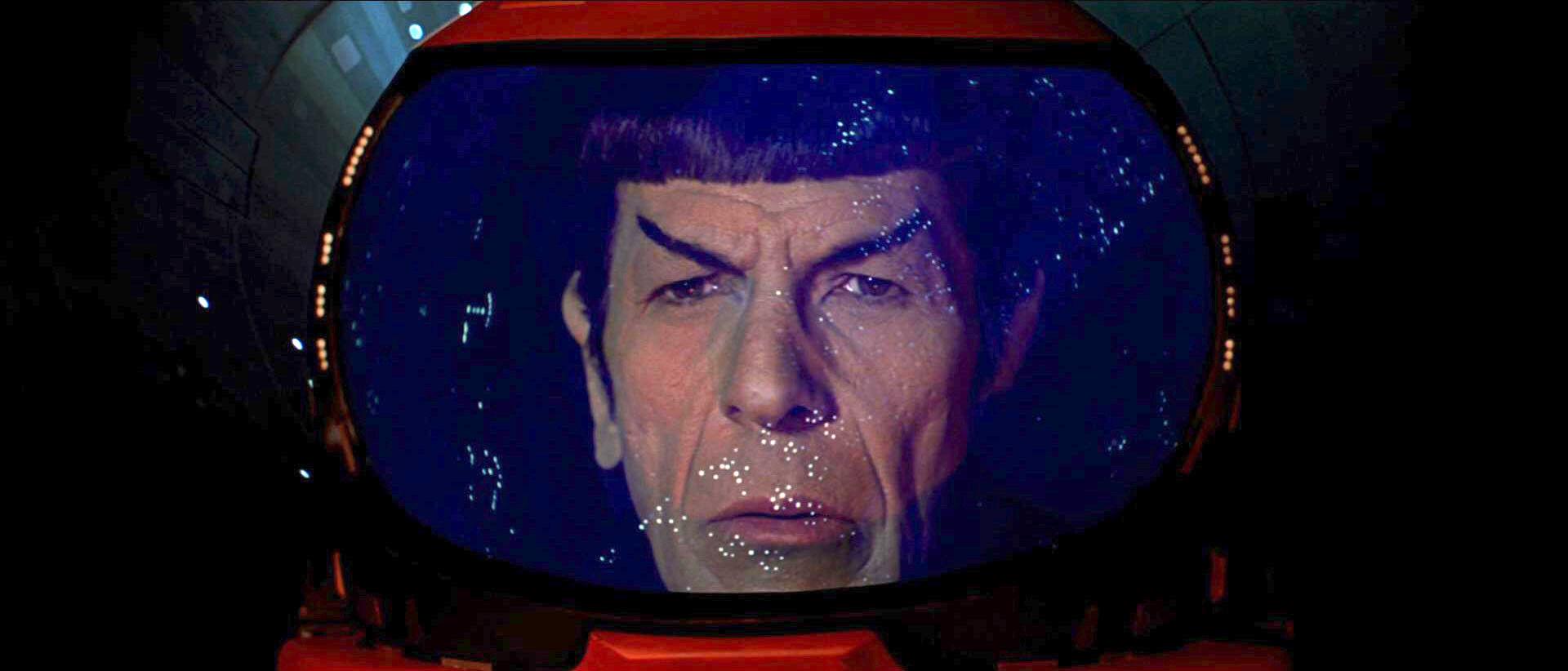
Credit: Paramount Pictures/CBS
For 40 years, the vast majority of Trekkies have considered 1979's Star Trek: The Motion Picture to be inferior to its successors, specifically 1982's Star Trek II: The Wrath of Khan . For many, the cinematic voyages of the starship Enterprise didn't really kick into warp drive until after the first movie. But however you feel about the movie's artistic merits, The Motion Picture remains historically significant as the first time Star Trek experienced a low-key reboot.
From small changes in the roles of familiar characters and tweaks to Starfleet traditions and uniforms to the actual canonical depiction of genre-famous alien races, Star Trek: The Motion Picture created a new aesthetic for the franchise. More significantly, that "look" is the one stuck with Trek ever since. From The Next Generation to Discovery , contemporary Star Trek owes more to The Motion Picture than it doesn't.
This week, the first Star Trek film ever returns to theaters for a limited run, and to celebrate the occasion, here are the10 ways the film changed the canon of the final frontier forever.
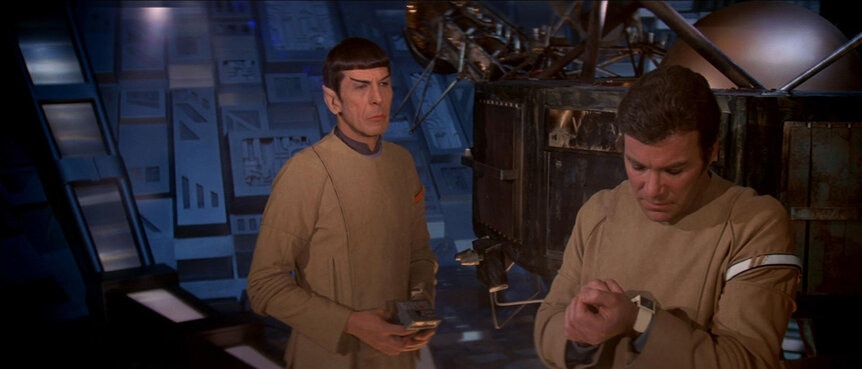
10 . Wearable communicators
In 1987, Star Trek: The Next Generation traded the famous flip-up Starfleet communicator for a wearable badge that you tapped; kind of like jewelry that was also a cellphone. But, the idea of having a wearable communicator actually started in Star Trek: The Motion Picture .
In this movie, everybody has wrist-communicators that look like Apple watches manufactured by Atari. By The Wrath of Khan , Starfleet would seemingly switch back to the flip-up communicator, even though a few people (namely Chekov) still rocked the wrist-style. If you want to go hard on your nerd lore; the oldest and probably most famous instance of the wrist-watch phone comes not from Trek , but from old Dick Tracy comic books.
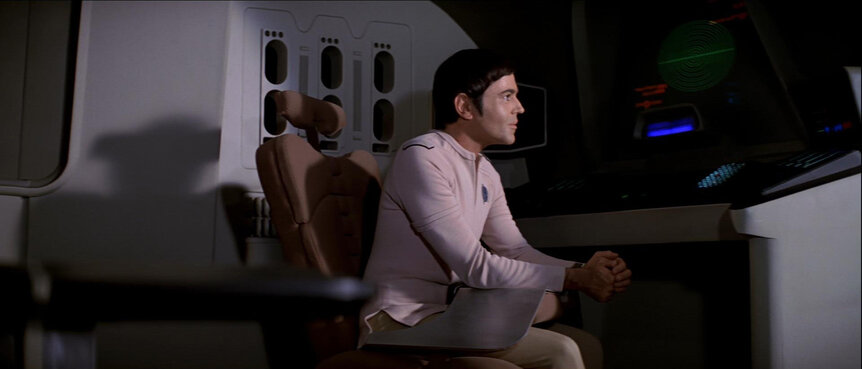
09 . Chekov’s new job
Speaking of Chekov, the character actually has a slight change of career in The Motion Picture that is subtle enough not to be noticed right away. In Seasons 2 and 3 of the original series, Chekov was the navigator of the Enterprise , which means he sat next to Sulu — the helmsman — at the front of the bridge.
But, in The Motion Picture , Ilia is the navigator, and Chekov is now both the tactical officer and a security officer. In the next film, The Wrath of Khan , Chekov ends-up serving on another ship, the USS Reliant , where he's actually the first officer. This means that the navigator spot is open on the Enterprise ;in that movie, too, which is why Saavik sits up-front with Sulu in that movie. In the last two classic Trek movies (numbers 5 and 6) Chekov returns to his navigator position on the Enterprise-A. . But, despite that, in Star Trek VI: The Undiscovered Country , it seems like he's also still in charge of security. In that movie, he tells the security officers what to do, and actively attempts to solve a mystery that is clearly an issue of ship's security.
Prior to Chekov's subtle career change, the tactical and/or security officer wasn't usually a major character in a Star Trek series. But after this, it becomes the norm. After Chekov takes over tactical in The Motion Picture , most Trek shows have tactical/security officers in the main cast; Worf and Yar in The Next Generation , Odo and Worf on Deep Space Nine , Tuvok on Voyager , Reed on Enterprise, and Ash Tyler and Nhan in Discovery .
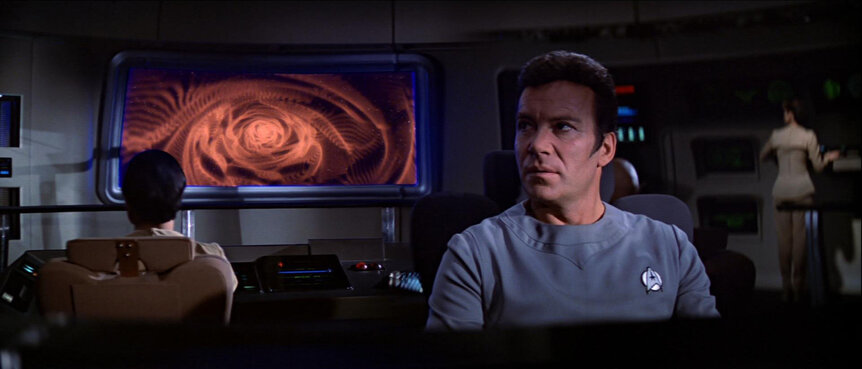
08 . Wormholes, Trek style
The idea that "a wormhole" could be caused by a distortion in space and time, of course, existed in physics prior to Star Trek , but The Motion Picture is the first time the franchise makes use of the concept. Toward the beginning of the movie, an imbalance in the warp engines of the Enterprise creates a dangerous wormhole and everyone talks in slow-motion and their faces get blurred. Though a much larger wormhole would later play a huge role in Deep Space Nine , the second season finale of Discovery also featured the crew going through a temporary wormhole; and the visual effect was nearly identical to this scene in The Motion Picture.
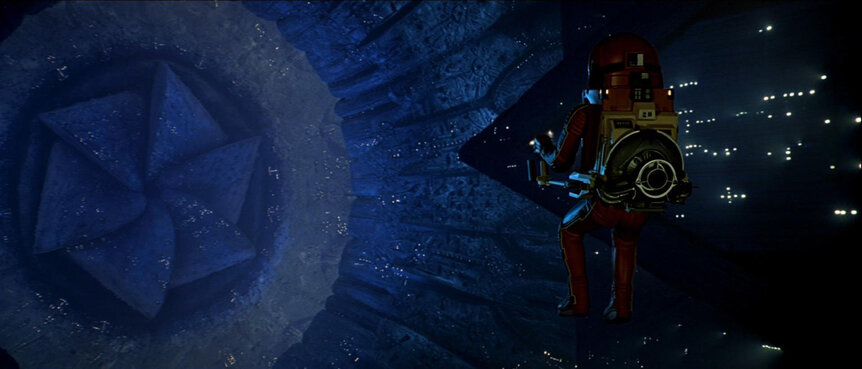
07 . Spock’s amazing spacesuit
Spacesuits in the original Star Trek were fairly rare, and when they did appear (like in "The Tholian Web") they looked goofy and decidedly uncool. The Motion Picture fixed this in a big way in an excellent sequence in which Spock used a "thruster suit" to explore the interior of the alien cloud known as "V'Ger."
After The Motion Picture , slick-looking space suits became a staple of the rest of the franchise. In fact, the very first episode of Star Trek: Discovery featured Michael Burnham in a spacesuit equipped with a "thruster pack" very similar to Spock's in The Motion Picture .
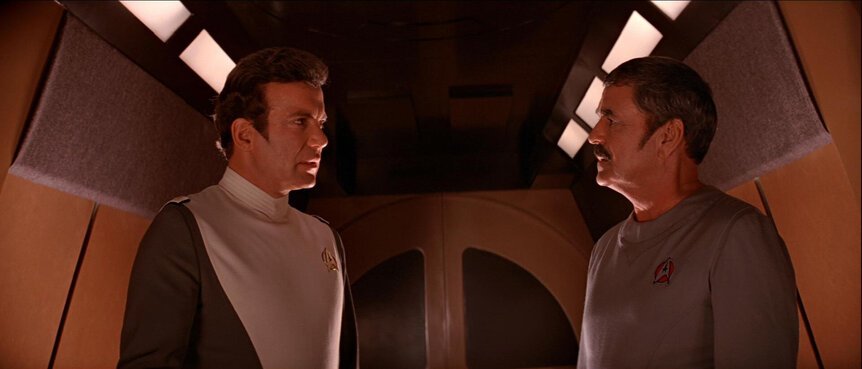
06 . Kirk’s starship tradition
Because the transporters on the Enterprise are broken at the start of The Motion Picture , Scotty and Kirk have to fly over to the newly refurbished starship in a travel pod instead of beaming-over. This results in a very long, and very famous (or infamous) sequence in which Kirk silently stares at the new Enterprise from several angles, as if he's in love with it. (Spoiler alert: he is!)
Whether you like the scene or hate it (personally, I love it) the idea that a ship's captain would head over to his new starship for the first time via a small shuttlecraft is a tradition that continued throughout several other iterations of Trek. In The Next Generation finale "All Good Things..." we see Captain Picard come aboard the Enterprise-D or the first time in a very similar fashion, and in the first episode of Enterprise , Captain Archer sees the Enterprise NX-01 in almost exactly the same way Kirk does in The Motion Picture .
This means, that somehow, Kirk's tradition extends both backward and forwards along the space-time continuum, but in terms of on-screen canon, this is the first time we saw this happen.
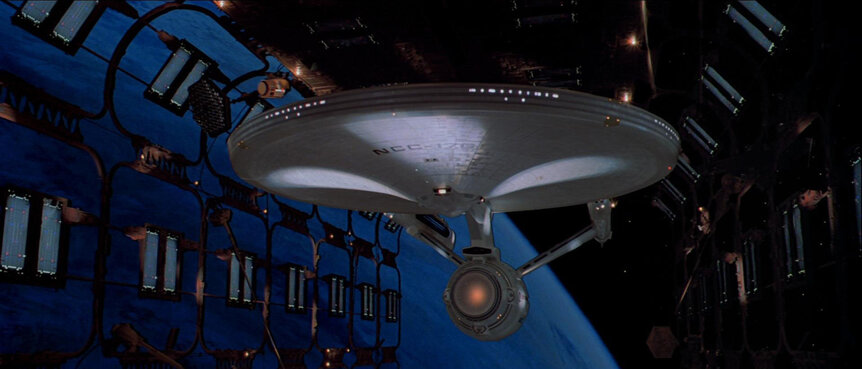
05 . The look of the USS Enterprise
The Enterprise of The Motion Picture is supposed to be the same starship from the original '60s show, but with a ton of upgrades. The most noticeable difference is that the warp nacelles on this version are less rounded and more rectangular. The colors of the deflector dish also change from orange to blue throughout the film and the entire interior of the ship looks almost nothing like it did in the classic show.
Whereas the interior design of the '60s Enterprise had an arty flashiness too it (along with a lot of the color orange ) the new Enterprise in The Motion Picture had a more sensible and muted color scheme. This approach to how the insides of Starfleet ships look pretty much stayed consistent after this film. True, there were variations, but much of the look of the late 23rd century comes from the sets on The Motion Picture .
Plus, this is the first time we saw what the warp "engine core" of a starship looked like. The long cylindrical crystal structure glimpsed in The Motion Picture certainly inspired the warp core on The Next Generation , and in Star Trek: Voyager , the warp core of that ship looks almost exactly like the one in this film.
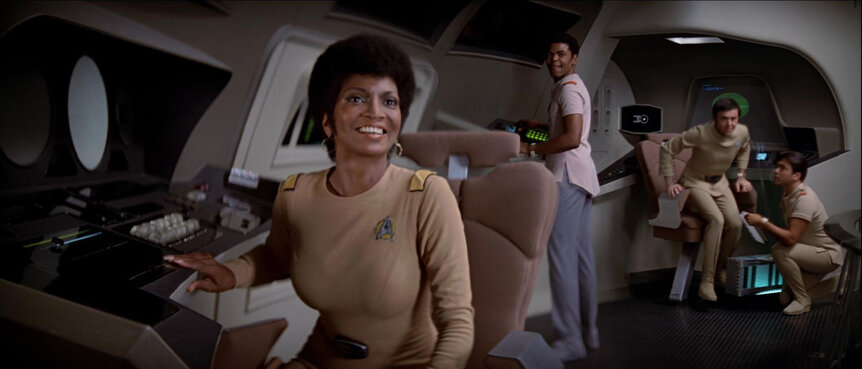
04 . Starfleet insignia and new uniforms
In the original series, the iconic "delta shield" insignia worn on the uniforms of the crew of the USS Enterprise was seemingly not the entire insignia of Starfleet. In fact, in multiple TOS episodes, it's very clear that different ships have different insignias. But, in The Motion Picture, the famous symbol becomes the symbol for all of Starfleet.
Because this symbol is perhaps the most famous symbol in all of science fiction, it's significant that this movie is the first time it becomes representative of all of Starfleet, at least in terms of on-screen canon. However, since then, certain prequels (like Star Trek: Discovery ) seem to make it clear that the famous symbol was used by other non- Enterprise ships well before the events of The Motion Picture .
So what's the deal? Some sources say that variant Starfleet insignia worn by the crews of other ships in TOS is simply a production error and that we should all ignore that stuff.
But, one thing is clear: This film is also the first time Starfleet uniforms changed significantly from their appearance in the original series. Obviously, after The Motion Picture , Starfleet uniforms would change a lot, but before this movie, the color-coded uniforms of "The Cage" and the original series were all fans had. And, in this film, it was strongly suggested that everybody could wear blue or beige or white and it wouldn't indicate anything about which division they worked in at all.
Also, this time around, it was hard to be a sacrificial "red shirt" since nobody wore red. (Even though by the next film, everybody would wear red.)
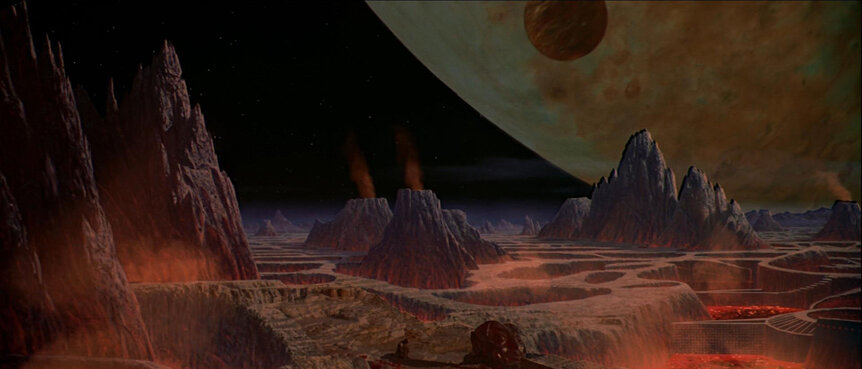
03 . The planet Vulcan
Star Trek: The Motion Picture features the first on-screen depiction of the Vulcan language. But, more interestingly, it also reboots what the surface of the planet Vulcan is supposed to look like.
In the original series, the crew had only visited Vulcan once, for Spock's "wedding" in "Amok Time." And then, because it was a cheap '60s set, it was just a red sky with a bunch of rocks. But, in The Motion Picture , we really get to see the planet Vulcan, which appears to have more than one natural moon in its orbit.
At the time, a lot of fans freaked out. Why? Well, in "The Man Trap" Spock says his home planet didn't have a moon, but whoops, there Spock is, in an early scene in The Motion Picture , looking at two objects in the sky that seems like moons.
Later, these things were explained-away as "sister planets" of Vulcan that weren't actually moons. In fact, in the novel The Vulcan Academy Murders, great pains are made to explain that one of these sister planets only appears every once in a while. In the Star Trek 2009 reboot, J.J. Abrams took advantage of this situation by adding another planet, Delta Vega, that was close enough to Vulcan that Spock could see the planet destroyed from its surface.
Notably, the first Abrams reboot depicts Vulcan very much the way it appears in The Motion Picture , which is also true of The Next Generation , several episodes of Enterprise and, of course, Discovery .
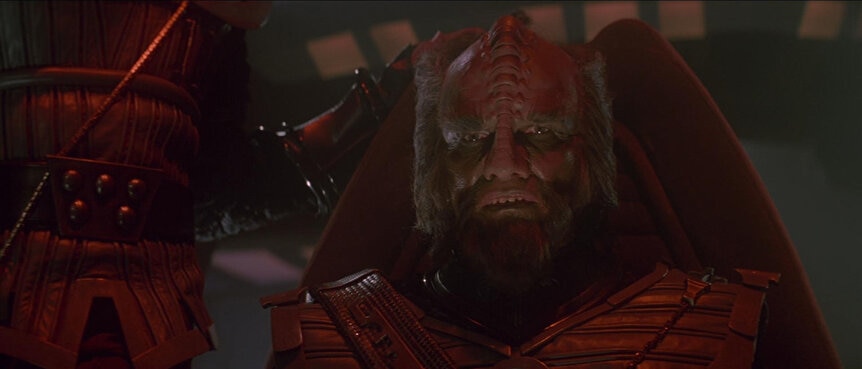
02 . The 'new' Klingons
In its very, very first scene, The Motion Picture contradicted the canon of the original series, and, subsequently established a new visual constant which created headaches in the franchise ever since. In the classic show, the Klingons did not have bumps on their foreheads, but in the first scene of The Motion Picture , they do! In fact, literally everything about the Klingons — from their uniforms to their ships — became the standard default look for Klingons from the run of the classic films all the way through the end of Voyager .
When the prequel series Enterprise rolled-around, a small retcon was attempted to "explain" the existence of the smooth-headed Klingons from TOS: a genetic virus had caused a huge mutation that made them look more human. If you buy this, that means, the first time Star Trek fans saw "real" Klingons was in Star Trek: The Motion Picture . And, after 1979, the Klingons didn't get a major redesign until 2017 when Star Trek: Discovery introduced a new look for the Klingons in its very first episode.
That said, even the Disco Klingons are inspired by the "lobster-headed" Klingons from the beginning of The Motion Picture . The Klingons in this scene also speak Klingon exclusively, which is the first time this fictional language was on screen, too. They played a minor role in The Motion Picture , but if you like Klingons, everything about the way they talk and dress really starts right here.
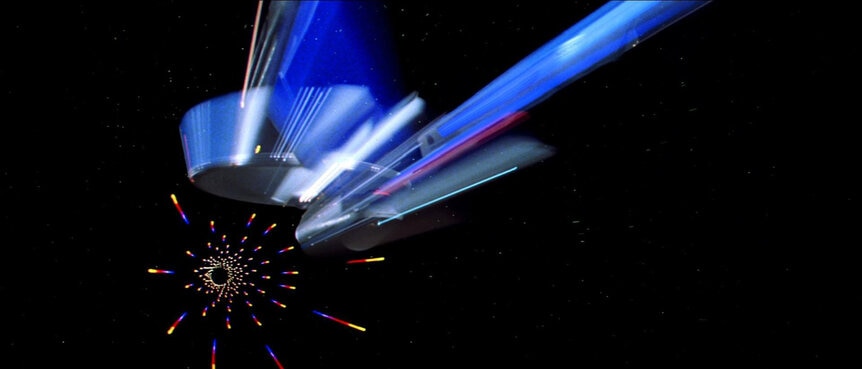
Credit: Paramount/CBS
01 . The music
If you've never seen Star Trek: The Motion Picture before, you might be shocked to discover that the opening credits feature the same music everyone came to associate with The Next Generation .
The score for The Motion Picture was composed by Jerry Goldsmith, which began his long association with the franchise. Goldsmith would later compose the opening theme for Star Trek: Voyager and also memorably score Star Trek: First Contact. But, among Star Trek music, the opening them for The Motion Picture is perhaps the music that says "Star Trek" more than any other piece, and is perhaps the second-most-famous sci-fi fanfare, right behind the opening theme to Star Wars .
The film also features a slow, ballad-like version of this familiar theme, which is called "The Enterprise." The music is so good that Goldsmith was nominated for an Oscar for Best Original Score in 1980. So even if you cling to the belief that The Motion Picture isn't the best Trek movie, nearly everyone can agree it has the best soundtrack.
- Star Trek: The Motion Picture
Related Stories

Everything We Know About the New Jason Bourne Movie
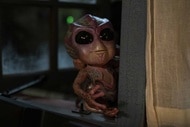
The 20 Best Sci-fi TV Shows on Peacock in June 2024
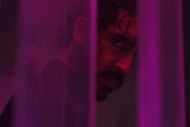
Monkey Man Streaming Exclusively on Peacock: How to Watch
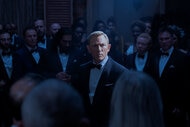
Daniel Craig Explains Why His James Bond Had to Die
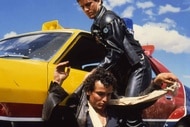
How Mad Max Pioneered the Post-Apocalyptic Worlds We Love
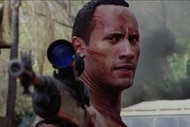
Remembering Dwayne “The Rock” Johnson in The Rundown

Knock at the Cabin's Abby Quinn on Getting Killed by Shyamalan
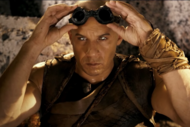
Vin Diesel Righted the Science Fiction Ship with Riddick
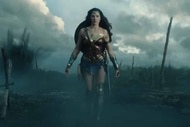
Wonder Woman: DC’s Most Complete Movie Since Batman
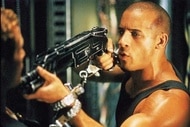
'Pitch Black' and the Science of Enhanced Vision

Chris Pratt Mourns Jurassic World Stunt Double
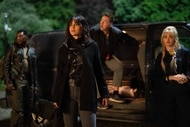
Abigail Star Reveals Alternate Ending for Vampire Flick
Recommended for you.

Linda Hamilton on Resident Alien Role: "I'm Not the Funny Girl, I'm the Straight Man"

The Classic Twilight Zone Episode That Inspired Jordan Peele's Us

Resident Alien's Alan Tudyk on Harry's New Love Interest, Edi Patterson's Blue Avian

- 87 listed changes - Difference without logos/credits: 10 sec (of which about 7 sec are pure master errors on DVD)

STAR TREK: THE MOTION PICTURE and its troubled production

The budget was massively exceeded with 40 million US dollars, a considerable part of which was spent on visual effects. The first company, Robert Abel and Associates, was unable to deliver usable material, so all the effects shots had to be hastily recreated. To be on the safe side, veterans Douglas Trumbull ( 2001 , Close Encounters of the Third Kind ) and John Dykstra ( Star Wars ) were brought on board. Under such difficult conditions, they delivered a remarkable outcome, but with more time, more would have been possible.
On top of that, some annoying mishaps happened, for example the original ADR sound was not used in 1979. In America it is a common practice that parts are re-dubbed due to poor quality of the studio sound. All of these ADR shots were indeed recorded, but in the hurry they only resorted to the studio sound. So a comparatively poor audio track was delivered and the effects shots came in at the very last minute before the theatrical release, so there was some fine tuning missing here as well, which both the director and the seasoned FX artists were actually aiming for.
Extended TV version and a DVD-exclusive Director's Cut

In any case, director Robert Wise was never quite satisfied with the film over the decades. Various matte paintings and storyboards are also a good testament to the different vision he had for various scenes in the film at the time. Ironically, the digitally remastered versions of the "quasi-competitor" Star Wars may have been a major factor in why Wise was given another chance to work on his baby at the turn of the millennium. In contrast to Lucas' ever-changing improvements, the 2001 director's cut can be said to have an absolutely undeniable added value.
Some of the longer scenes already known from the TV version were added here, focusing on those with a real added value and leaving out filler material. At the same time, material from the theatrical version has been trimmed , e.g. logic and continuity errors that have been corrected in this way. Various effect scenes , which were faulty or simply never completed at the time, could now be created retrospectively for the first time. For this, too, some shots used in the theatrical version as a substitute for those missing effects were deleted. In addition, a new sound mix was created, which was a clear improvement over the theatrical/TV version, but basically used the same source material.
The Director's Edition was completely remastered in 4K

Another highlight was that in the meantime the original ADR recordings had been recovered and the original score by Jerry Goldsmith had been restored. So even the troubled audio situation could now be tackled with a significantly improved starting point and in the spirit of the original version.
For the 55th anniversary of the series on September 07, 2021, they unfortunately weren't ready yet, so "only" the theatrical version was released in 4K here for the time being. However, in April 2022, a 4K version of the director's cut premiered exclusively in the US VOD offering from Paramount+. Since September 05, 2022 , this "Director's Edition" is also available on 4K Blu-ray as well as Blu-ray. We now work up here what eager fans have already collected in the months since VOD release sometimes more and sometimes less detailed.
The differences in the 4K director's cut

In the course of this, even the original effects were given a makeover . In contrast to the 1979 theatrical version, which was of course composited using the trick technology of the time, there was no longer any generation loss and obvious edges around the matte paintings. Also, because of the time pressure at that time, some composites of effects scenes were much blurrier than usual, this is now also fixed.
Some elements remained unfortunately lost, so that one had to trick here otherwise. Details about this are explained in a 90-minute YouTube interview with the people responsible for the 4K restoration , which is worth listening to. Many nice examples of reworked effects can be found in DVD Schweizer's huge image comparison . Here, we will only focus on the cases where clear differences between the visuals itself are also noticeable.
As just mentioned, the access to original elements at that time was worth its weight in gold there. Goofs in e.g. landscapes in the background were often ironed out, or a curious example in this respect are the changing jackets of Spock and McCoy shortly before the end credits. In general, small continuity errors and geometric inconsistencies were often addressed. The completely rebuilt CGI models got different shapes here and there in detail. Again, it must be clearly attested that these changes don't seem out of place at any moment, as is sometimes the case with George Lucas' many reworkings of the original trilogy.
Also curious are a few alternate or completely exclusive shots . In some moments of the 2001 director's cut, such as the scene with Spock in the 11th minute, alternate takes were used. The 4K DC goes back to the original theatrical version footage here. In the 95th minute, there is an approximately 3 sec long completely new shot of the rings, which was probably added for continuity reasons.
Last but not least, the recovered ADR bits in the audio track should be highlighted again. In the documentary on the new bonus Blu-ray there is an excerpt of the ADR session with Leonard Nimoy as Spock, where you can see for yourself the effort that director Robert Wise made back then. Also in several other places, which are not even highlighted in the cut report, a clearly better sound quality is noticeable. In some cases, radio calls are distorted differently or dialogues were deliberately mixed left/right for spatiality. In addition, the soundtrack by Jerry Goldsmith has also been polished up, as mentioned in the previous section.
It should be summarized as a conclusion that these are mostly adjustments that are actually clearly to be welcomed. Revisionist, yes - but in a conscientious way that respectfully gives the film another little polish. With excellent picture quality and the touching up of many little things that Wise unfortunately couldn't do himself during his lifetime, the classic has now been duly archived for eternity
Summary on the three main versions of the movie
Here is a quick overview of the three main versions, which also includes a few small comments that have not found a place in the long text up to this point.

a) VHS/DVD/2009 Blu-ray : In several editions this is clearly the version that has been released most times. For director Robert Wise, however, this has more the character of an incomplete rough cut due to incomplete realization of effects, soundtrack and some action scenes.
b) 2021 4K-remastered : Basically the same film version, but in one scene in particular it was noticeable that an attempt was made to digitally conceal a film error (model arm of the Enterprise covers the dock). However, this was done carelessly and even a piece of the Enterprise was cut away, see high-resolution image comparison from DVD Schweizer .

a) On VHS/Laserdiscs from the 80s and 90s , a version was released based on the theatrical version, adding just under 13 minutes of Deleted Scenes to it. Was also released in Germany on VHS, including re-dubbing for all additional parts.
b) 2022 4K-remastered : Basically the same film version, but for the additional scene "Kirk's spacewalk" the missing set background was now completed digitally.

a) 2002 DVD : Personally supervised by director Robert Wise, this is a reconstruction of his desired version. With many digitally redone effects and some new action scenes, but also some scenes cut from the theatrical version.
b) 2022 4K : Newly restored version of the Director's Edition by the core team also involved in the DVD reconstruction. Further details that could not be technically realized in 2002 were added.


Suggested Searches
- Climate Change
- Expedition 64
- Mars perseverance
- SpaceX Crew-2
- International Space Station
- View All Topics A-Z
Humans in Space
Earth & climate, the solar system, the universe, aeronautics, learning resources, news & events.
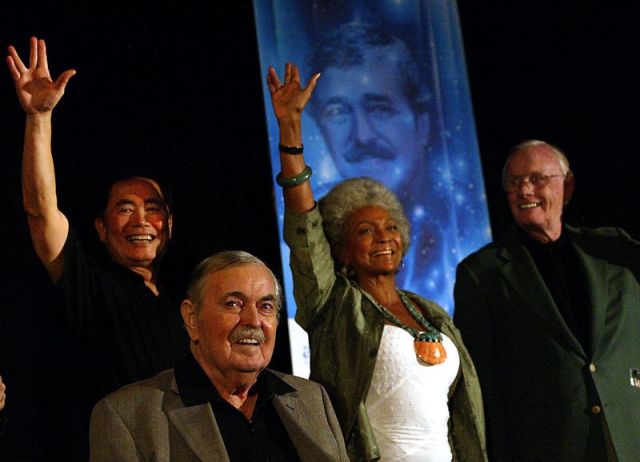
55 Years Ago: Star Trek Final Episode Airs, Relationship with NASA Endures

Space Station Research Advances NASA’s Plans to Explore the Moon, Mars

What’s Up: June 2024 Skywatching Tips from NASA
- Search All NASA Missions
- A to Z List of Missions
- Upcoming Launches and Landings
- Spaceships and Rockets
- Communicating with Missions
- James Webb Space Telescope
- Hubble Space Telescope
- Why Go to Space
- Commercial Space
- Destinations
- Living in Space
- Explore Earth Science
- Earth, Our Planet
- Earth Science in Action
- Earth Multimedia
- Earth Science Researchers
- Pluto & Dwarf Planets
- Asteroids, Comets & Meteors
- The Kuiper Belt
- The Oort Cloud
- Skywatching
- The Search for Life in the Universe
- Black Holes
- The Big Bang
- Dark Energy & Dark Matter
- Earth Science
- Planetary Science
- Astrophysics & Space Science
- The Sun & Heliophysics
- Biological & Physical Sciences
- Lunar Science
- Citizen Science
- Astromaterials
- Aeronautics Research
- Human Space Travel Research
- Science in the Air
- NASA Aircraft
- Flight Innovation
- Supersonic Flight
- Air Traffic Solutions
- Green Aviation Tech
- Drones & You
- Technology Transfer & Spinoffs
- Space Travel Technology
- Technology Living in Space
- Manufacturing and Materials
- Science Instruments
- For Kids and Students
- For Educators
- For Colleges and Universities
- For Professionals
- Science for Everyone
- Requests for Exhibits, Artifacts, or Speakers
- STEM Engagement at NASA
- NASA's Impacts
- Centers and Facilities
- Directorates
- Organizations
- People of NASA
- Internships
- Our History
- Doing Business with NASA
- Get Involved
- Aeronáutica
- Ciencias Terrestres
- Sistema Solar
- All NASA News
- Video Series on NASA+
- Newsletters
- Social Media
- Media Resources
- Upcoming Launches & Landings
- Virtual Events
- Sounds and Ringtones
- Interactives
- STEM Multimedia
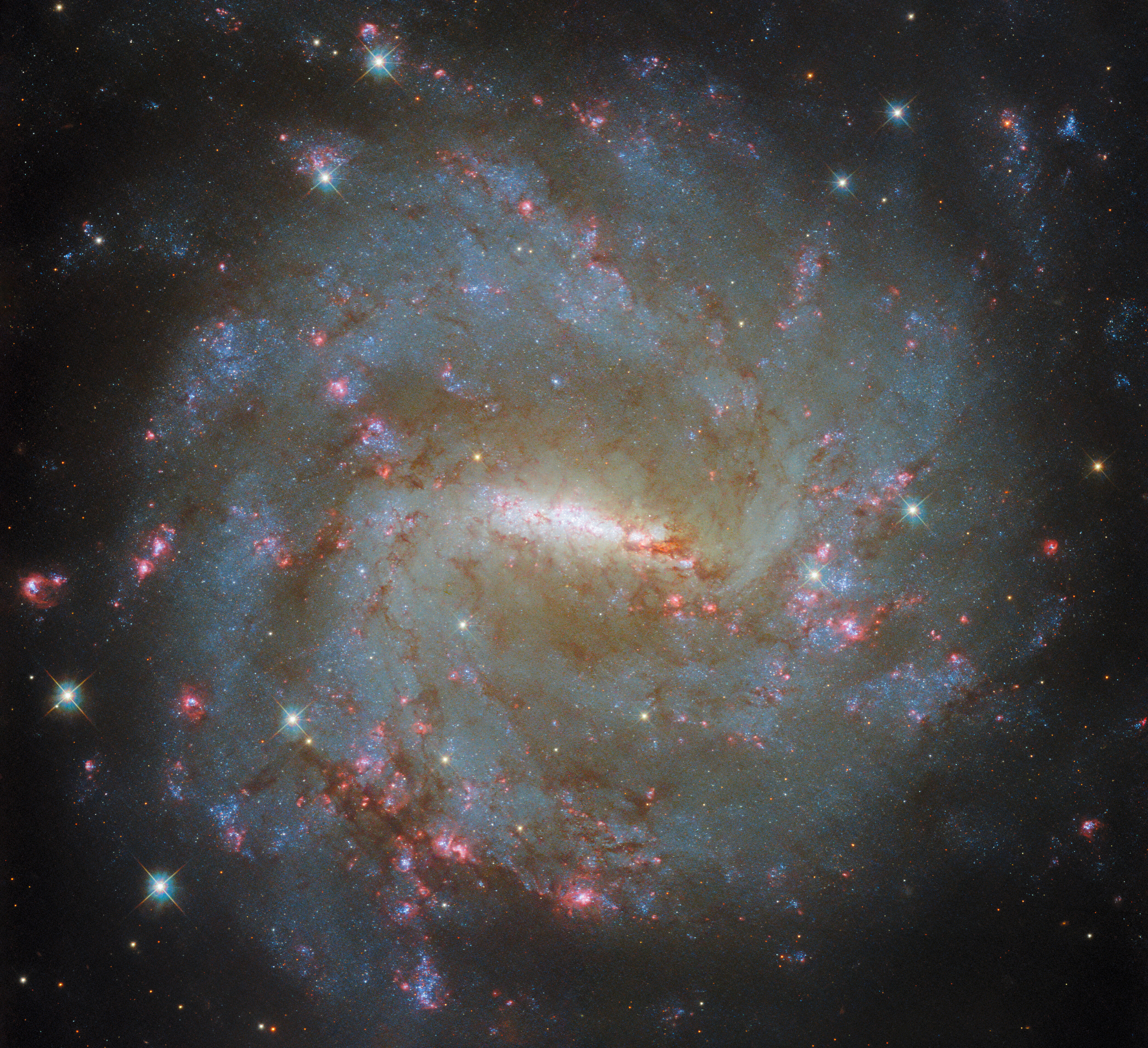
Hubble Examines a Barred Spiral’s Light

Webb Finds Plethora of Carbon Molecules Around Young Star

NASA Scientists Take to the Seas to Study Air Quality

NASA Astronauts Practice Next Giant Leap for Artemis

Former Astronaut David R. Scott

NASA Mission Flies Over Arctic to Study Sea Ice Melt Causes

Twin NASA Satellites Ready to Help Gauge Earth’s Energy Balance

Solid State Quantum Magnetometers—Seeking out water worlds from the quantum world

C.12 Planetary Instrument Concepts for the Advancement of Solar System Observations POC Change

NASA to Change How It Points Hubble Space Telescope

B.10 Heliophysics Flight Opportunities Studies Correction

ARMD Solicitations

Winners Announced in Gateways to Blue Skies Aeronautics Competition

NASA, Industry to Start Designing More Sustainable Jet Engine Core

Tech Today: Measuring the Buzz, Hum, and Rattle

Artemis Generation Shines During NASA’s 2024 Lunabotics Challenge

Ames Science Directorate’s Stars of the Month, June 2024

Ted Michalek: Engineering from Apollo to Artemis
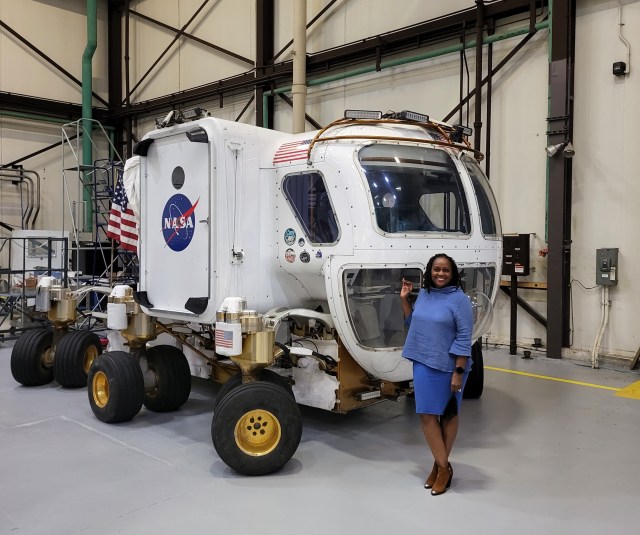
Aerospace Trailblazer: Shirley Holland-Hunt’s Visionary Leadership Transforms Space Exploration

Diez maneras en que los estudiantes pueden prepararse para ser astronautas

Astronauta de la NASA Marcos Berríos

Resultados científicos revolucionarios en la estación espacial de 2023
15 min read
Johnson Space Center
The voyages of the Starship Enterprise came to a sudden and premature end on June 3, 1969, with the airing of the final episode of the Star Trek original television series. Ironically, the show’s cancellation came just six weeks before humanity embarked on its first voyage to land on another celestial body. Although the show ran for only three seasons, it generated a devoted fan base disappointed by the cancellation despite their write-in campaign to keep it on the air. But as things turned out, over the decades Star Trek evolved into a global phenomenon, first with the original episodes replayed in syndication, followed by a series of full-length motion pictures, and eventually a multitude of spin-off series. With its primary focus on space exploration, along with themes of diversity, inclusion, and innovation, the Star Trek fictional universe formed a natural association with NASA’s real life activities.

Star Trek creator Gene Roddenberry first had the idea for a science fiction television series in 1964. He presented his idea, a show set in the 23 rd century aboard a starship with a crew dedicated to exploring the galaxy, to Desilu Productions, an independent television production company headed by Lucille Ball. They produced a pilot titled “The Cage,” selling it to the National Broadcasting Corporation (NBC) network that then bought a second pilot titled “Where No Man Has Gone Before.” NBC introduced the show to its fall 1966 lineup, with the first episode “The Man Trap” airing on Sep. 8. To put that date in perspective, NASA launched Gemini XI four days later, one of the missions that helped the agency achieve the Moon landing nearly three years later. Meanwhile, Star Trek’s Starship Enterprise continued its fictional five-year mission through the galaxy to “seek out new life and new civilizations.” The makeup of the Enterprise’s crew made the show particularly attractive to late 1960s television audiences. The major characters included an African American woman communications officer, an Asian American helmsman, and a half-human half-Vulcan science officer, later joined by a Russian-born ensign. While the show enjoyed good ratings during its first two seasons, cuts to its production budget resulted in lower quality episodes during its third season leading to lower ratings and, despite a concerted letter-writing campaign from its dedicated fans, eventual cancellation.

Despite the show’s cancellation, Star Trek lived on and prospered in syndication and attracted an ever-growing fan base, turning into a worldwide sensation. Often dubbed “trekkies,” these fans held the first of many Star Trek conventions in 1972. When in 1976 NASA announced that it would name its first space shuttle orbiter Constitution, in honor of its unveiling on the anniversary of the U. S. Constitution’s ratification, trekkies engaged in a dedicated letter writing campaign to have the orbiter named Enterprise, after the starship in the television series. This time the fans’ letter writing campaign succeeded. President Gerald R. Ford agreed with the trekkies and directed NASA to rechristen the first space shuttle. When on Sept. 17, 1976 , it rolled out of its manufacturing plant in Palmdale, California, appropriately accompanied by a band playing the show’s theme song, it bore the name Enterprise. Many of the original cast members of the show as well as its creator Rodenberry participated in the rollout ceremony, hosted by NASA Administrator James C. Fletcher . Thus began a lengthy relationship between the space agency and the Star Trek brand.
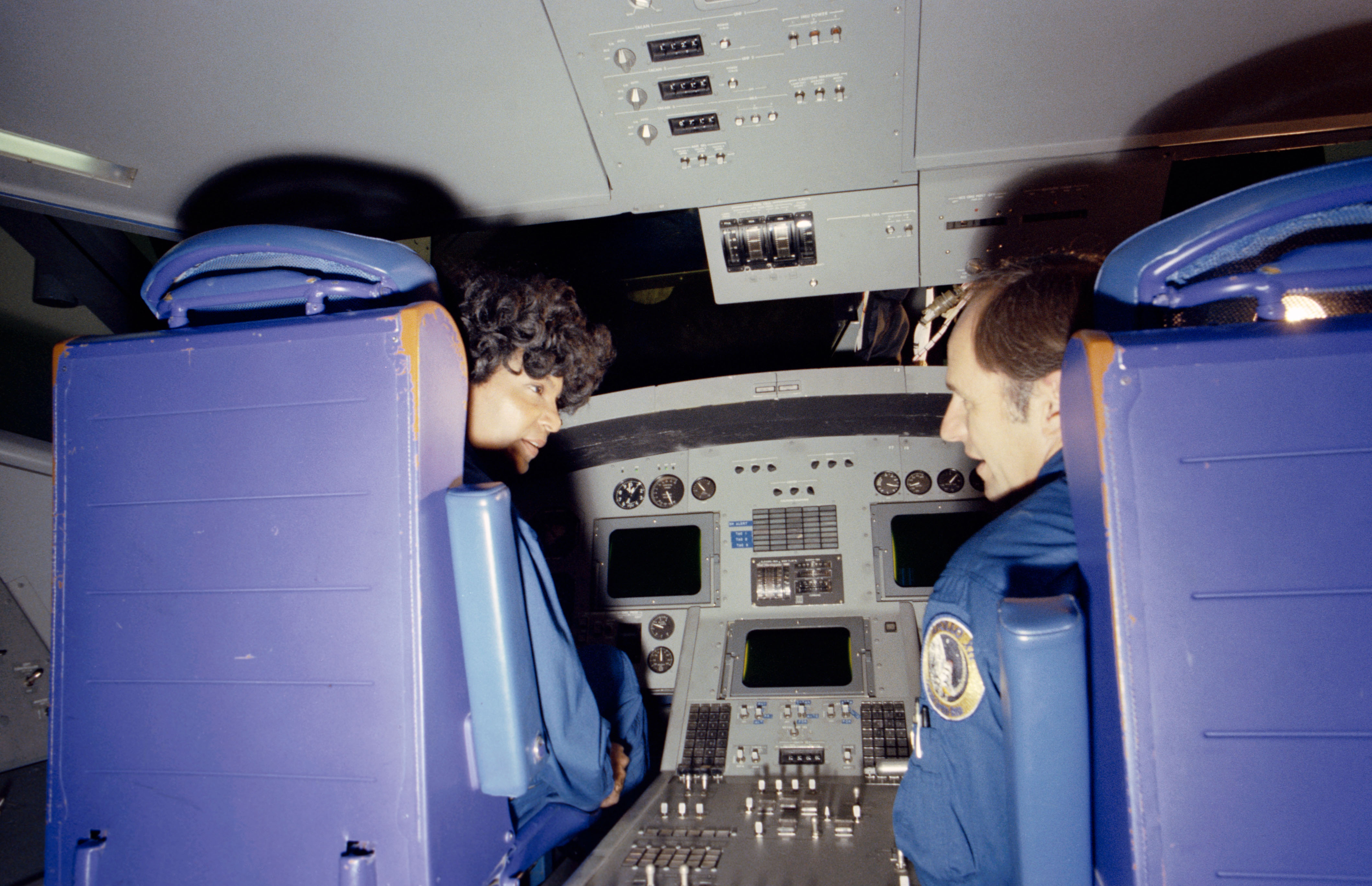
During the development of the space shuttle in the 1970s, the need arose to recruit a new group of astronauts to fly the vehicle, deploy the satellites, and perform the science experiments. When NASA released the call for the new astronaut selection on July 8, 1976, it specifically encouraged women and minorities to apply. To encourage those applicants, NASA chose Nichelle Nichols, who played communications officer Lt. Uhura on the Starship Enterprise, to record a recruiting video and speak to audiences nationwide. She came to NASA’s Johnson Space Center (JSC) in Houston in March 1977, and accompanied by Apollo 12 and Skylab 3 astronaut Alan L. Bean , toured the center and filmed scenes for the video in Mission Control and other facilities. NASA hoped that her stature and popularity would encourage women and minorities to apply, and indeed they did. In January 1978, when NASA announced the selection of 35 new astronauts from more than 8,000 applicants, for the first time the astronaut class included women and minorities. All distinguished themselves as NASA astronauts and paved the way for others in subsequent astronaut selections. Nichols returned to JSC in September 2010 with the Traveling Space Museum, an organization that partners with schools to promote space studies. She toured Mission Control and the International Space Station trainer accompanied by NASA astronaut B. Alvin Drew . She also flew aboard NASA’s Stratospheric Observatory for Infrared Astronomy (SOFIA) airborne telescope aircraft managed by NASA’s Ames Research Center in Silicon Valley, California, in September 2015.

Meanwhile, the Star Trek brand renewed itself in 1979 as a full-length motion picture with the original TV series cast members reprising their roles. Over the years, several sequels followed this first film. And on the small screen, a reboot of sorts occurred in 1987 with the premiere of Star Trek: The Next Generation, a new series set in the 24 th century aboard the Enterprise-D, a next generation starship with a new crew. That series lasted seven seasons, followed by a near-bewildering array of spin-off series, all built on the Star Trek brand, that continue to this day.

James Doohan, the actor who played Lt. Cmdr. Montgomery “Scotty” Scott, the Starship Enterprise’s chief engineer, had early associations with NASA. In April 1967, Doohan visited NASA’s Dryden (now Armstrong) Flight Research Center in California, spending time with NASA test pilot Bruce A. Peterson. A month later, Peterson barely survived a horrific crash of the experimental M2-F2 lifting body aircraft. He inspired the 1970s TV series The Six-Million Dollar Man, and the show’s opening credits include film of the crash. Doohan narrated a documentary film about the space shuttle released shortly before Columbia made its first flight in April 1981. In January 1991, Doohan visited JSC and with NASA astronaut Mario Runco (who sometimes went by the nickname “Spock”) toured the shuttle trainers, Mission Control, and tried his hand at operating the shuttle’s robotic arm in the Manipulator Development Facility. In a unique tribute, astronaut Neil A. Armstrong , the first person to step on the lunar surface , spoke at Doohan’s retirement in 2004, addressing him as “one old engineer to another.”
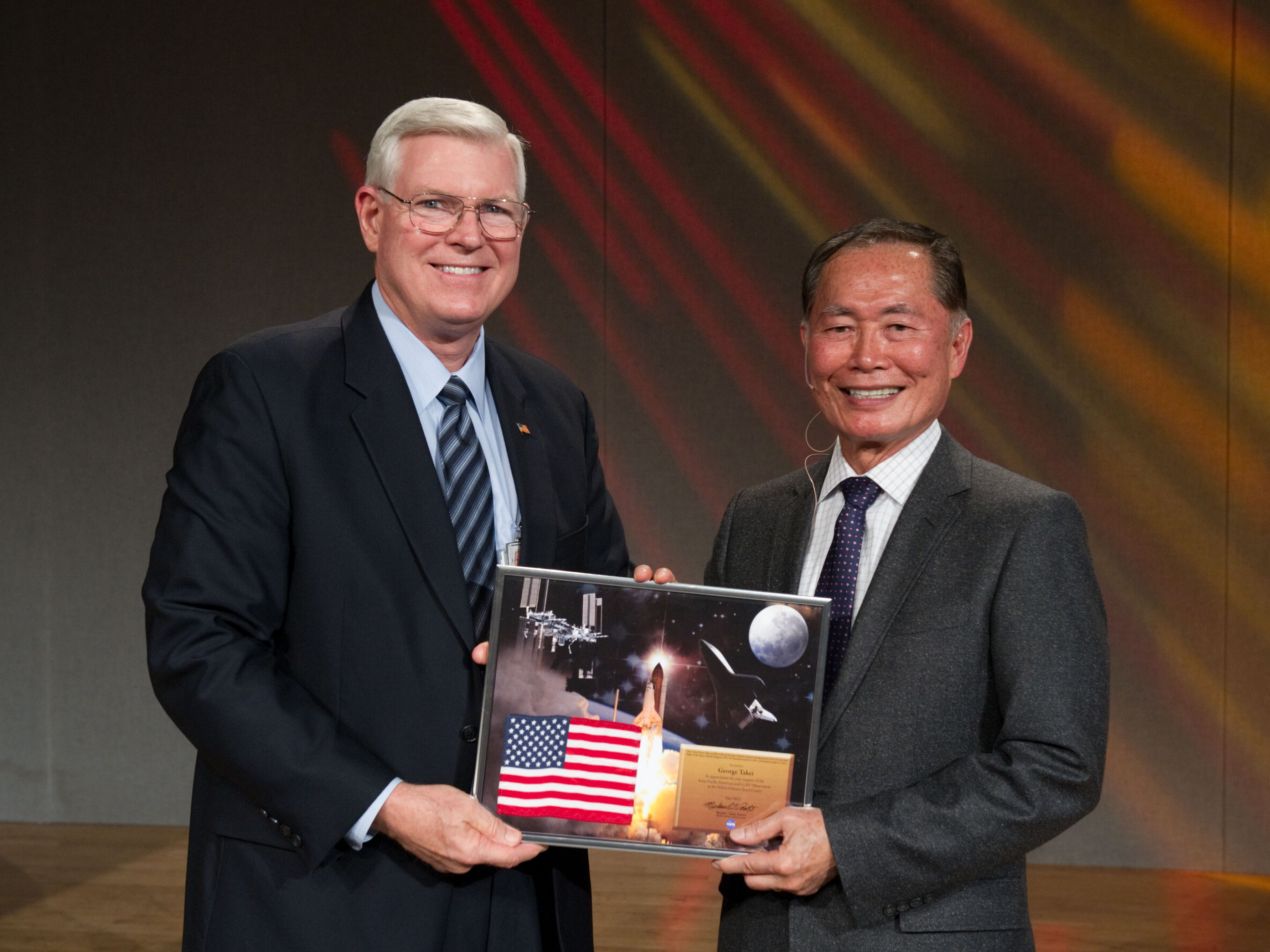
George Takei, who played Enterprise helmsman Lt. Hikaru Sulu, and his husband Brad, visited JSC in May 2012. Invited by both Asian American and LGBTQ+ Employee Resource Groups, Takei spoke of leadership and inclusiveness, including overcoming challenges while in Japanese American internment camps during World War II and as a member of the LGBTQ+ community. He noted that Star Trek remained ahead of its time in creating a future when all members of society could equally participate in great undertakings, at a time when the country struggled through the Civil Rights movement and the conflict in Southeast Asia. The inclusiveness that is part of NASA’s culture greatly inspired him. JSC Director Michael L. Coats presented Takei with a plaque including a U.S. flag flown aboard space shuttle Atlantis’ STS-135 mission. He also visited Mission Control and spent some time with Robonaut.
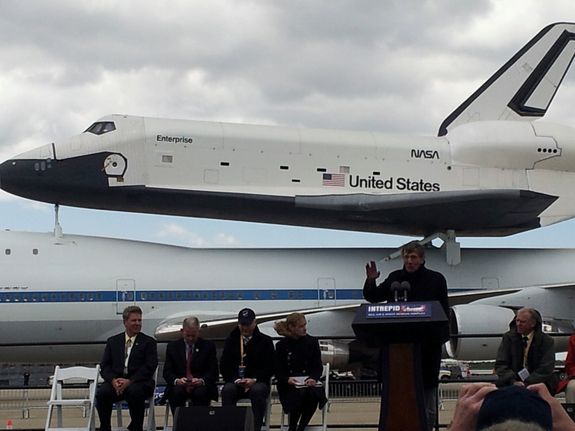
Leonard Nimoy played the science officer aboard the Starship Enterprise, the half-human, half-Vulcan Mr. Spock. The actor watched in September 2012 when space shuttle Enterprise arrived at John F. Kennedy International Airport in New York, on the last leg of its journey to the Intrepid Sea, Air and Space Museum, where it currently resides. “This is a reunion for me,” observed Nimoy. “Thirty-five years ago, I met the Enterprise for the first time.” As noted earlier, the Star Trek cast attended the first space shuttle’s rollout in 1976. Following his death in 2015, European Space Agency astronaut Samantha Cristoforetti paid tribute to Nimoy aboard the International Space Station by wearing a Star Trek science officer uniform, giving the Vulcan greeting, and proclaiming, “Of all the souls I have encountered … his was the most human.”
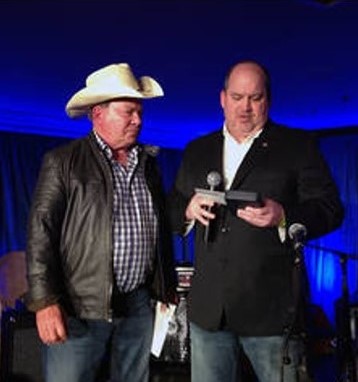
Captain James T. Kirk, played by actor William Shatner, a life-long advocate of science and space exploration, served at the helm of the Starship Enterprise. His relationship with NASA began during the original series, with references to the space agency incorporated into several story lines. In 2011, Shatner hosted and narrated a NASA documentary celebrating the 30 th anniversary of the Space Shuttle program , and gave his time and voice to other NASA documentaries. NASA recognized Shatner’s contributions in 2014 with a Distinguished Public Service Medal , the highest award NASA bestows on non-government individuals. NASA Deputy Associate Administrator for Communications Robert “Bob” N. Jacobs presented the medal to Shatner. The award’s citation read, “For outstanding generosity and dedication to inspiring new generations of explorers around the world, and for unwavering support for NASA and its missions of discovery.” In 2019, Shatner narrated the NASA video We Are Going , about NASA’s plans to return astronauts to the Moon. He has spoken at numerous NASA-themed events and moderated panels about NASA’s future plans. On Oct. 13, 2021, at the age of 90, Shatner reached the edge of space during the NS-18 suborbital flight of Blue Origin’s New Shepard vehicle, experiencing three minutes of weightlessness.
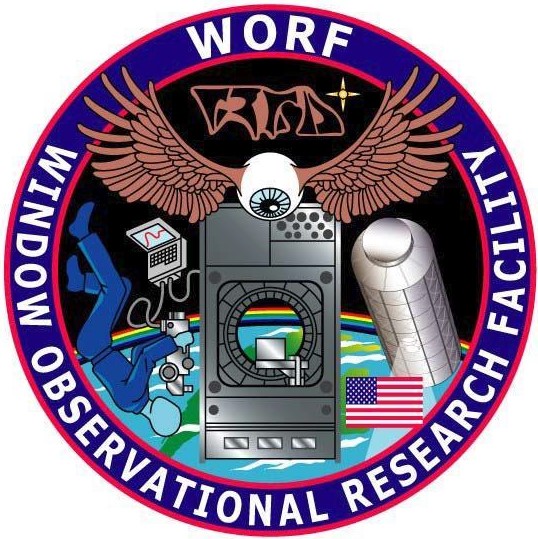
Elements of the Star Trek universe have made their way not only into popular culture but also into NASA culture. As noted above, Star Trek fans had a hand in naming the first space shuttle Enterprise. NASA’s Earth observation facility aboard the space station that makes use of its optical quality window bears the name the Window Observational Research Facility (WORF). The connection between that acronym and the name of a Klingon officer aboard the Enterprise in the Star Trek: The Next Generation TV series seemed like an opportunity not to be missed – the facility’s official patch bears its name in English and in Klingon. Several astronaut crews have embraced Star Trek themes for their unofficial photographs. The STS-54 crew dressed in the uniforms of Starship Enterprise officers from Star Trek II: The Wrath of Kahn, the second full-length feature motion picture of the series. Space shuttle and space station crews created Space Flight Awareness (SFA) posters for their missions, and more than one embraced Star Trek themes. The Expedition 21 crew dressed in uniforms from the original series, while the STS-134 crew chose as their motif the 2009 reboot motion picture Star Trek.
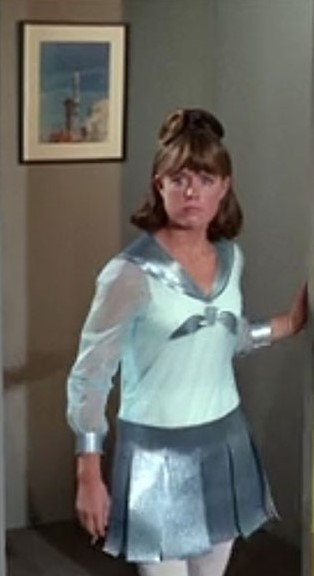
As much as Star Trek has influenced NASA, in turn the agency has left its mark on the franchise, from episodes referencing actual and future spaceflight events to NASA astronauts making cameo appearances on the show. The first-season episode “Court Martial” that aired in February 1967 featured a photograph of the December 1965 Gemini VI launch adorning a wall aboard a star base. In the second-season episode “Return to Tomorrow,” airing in February 1968, Captain Kirk in a dialogue about risk-taking remarks, “Do you wish that the first Apollo mission hadn’t reached the Moon?” a prescient reference to the first Apollo mission to reach the Moon more than 10 months after the episode aired. Astronaut Mae C. Jemison , who credits Nichelle Nichols as her inspiration to become an astronaut, appeared in the 1993 episode “Second Chances” of Star Trek: The Next Generation , eight months after her actual spaceflight aboard space shuttle Endeavour. In May 2005, two other NASA astronauts, Terry W. Virts and E. Michael Fincke , appeared in “These are the Voyages…,” the final episode of the series Star Trek: Enterprise.
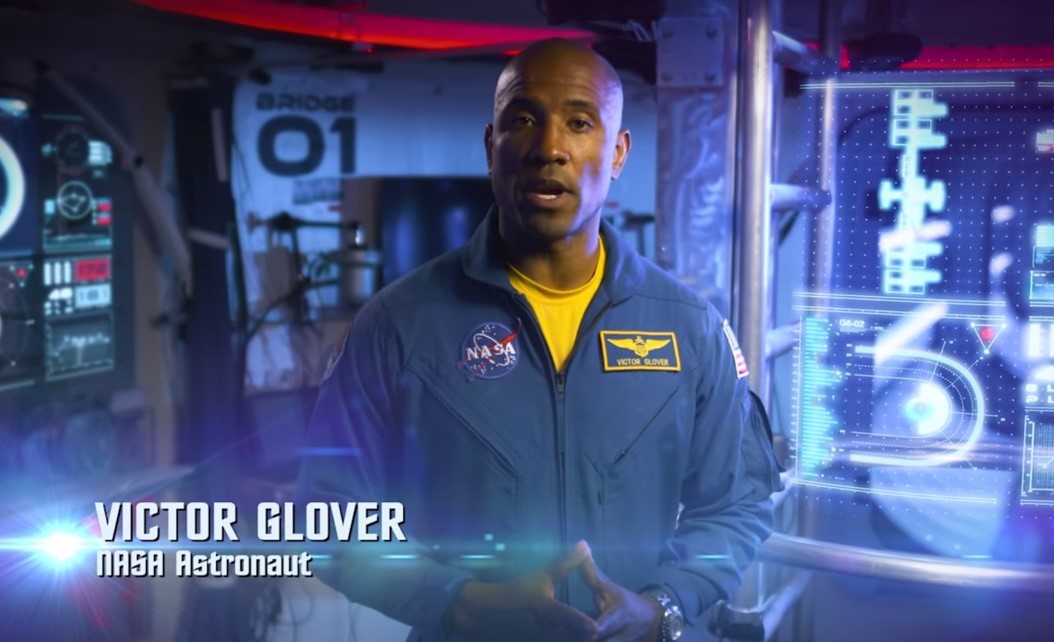
In the 2016 documentary “ NASA on the Edge of Forever: Science in Space ,” host NASA astronaut Victor J. Glover states, “Science and Star Trek go hand-in-hand.” The film explores how for 50 years, Star Trek influenced scientists, engineers, and even astronauts to reach beyond their potential. While the space station doesn’t speed through the galaxy like the Starship Enterprise, much of the research conducted aboard the orbiting facility can make the fiction of Star Trek come a little closer to reality. Several of the cast members from the original TV series share their viewpoints in the documentary, along with those of NASA managers and scientists. Over the years, NASA has created several videos highlighting the relationship between the agency and the Star Trek franchise. In 2016, NASA Administrator Charles F. Bolden led a video tribute to celebrate the 50 th anniversary of the first Star Trek episode.
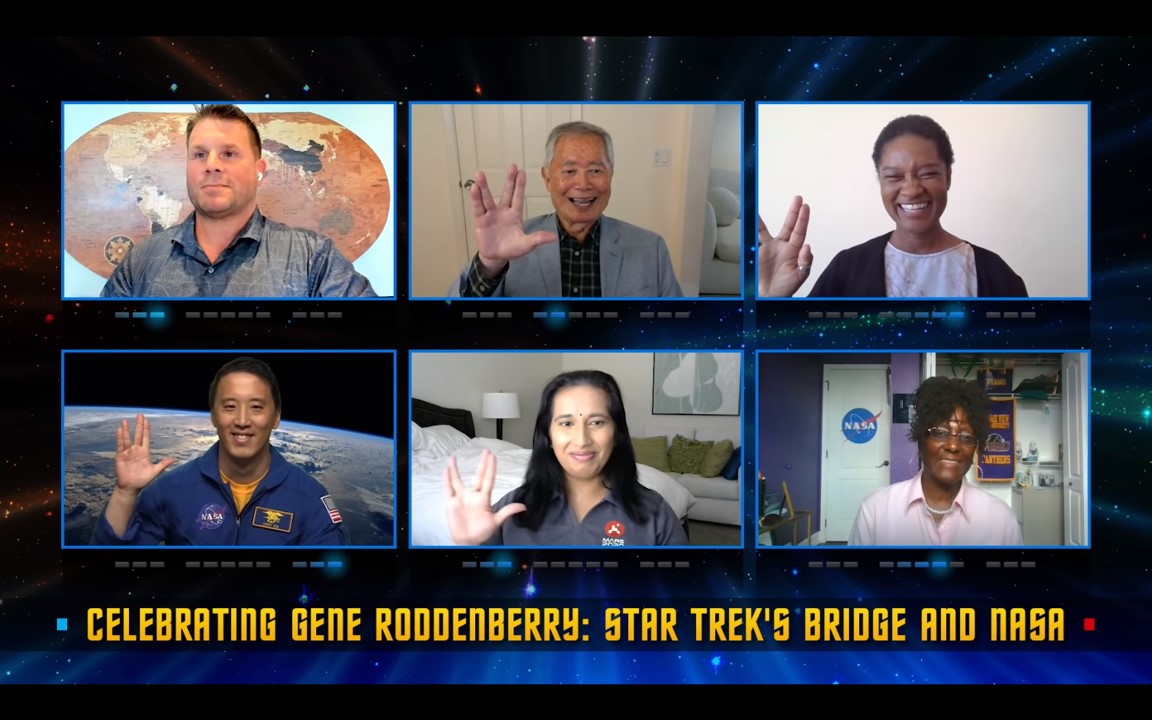
In 2021, on the 100 th anniversary of Gene Roddenberry’s birth, his son Rod hosted a virtual panel discussion , introduced by NASA Administrator C. William “Bill” Nelson , about diversity and inspiration, two ideals the Star Trek creator infused into the series. Panelists included Star Trek actor Takei, Tracy D. Drain, flight systems engineer for the Europa Clipper spacecraft at NASA’s Jet Propulsion Laboratory (JPL) in Pasadena, California, NASA astronaut Jonny Kim , Swati Mohan, guidance and operations lead for the Mars 2020 rover at JPL, and Hortense B. Diggs, Director of the Office of Communication and Public Engagement at NASA’s Kennedy Space Center in Florida.
The mutual attraction between NASA and Star Trek stems from, to paraphrase the opening voiceover from the TV series, that both seek to explore and discover new worlds, and to boldly go where no one has gone before. The diversity, inclusion, and inspiration involved in these endeavors ensure that they will live long and prosper.
Explore More
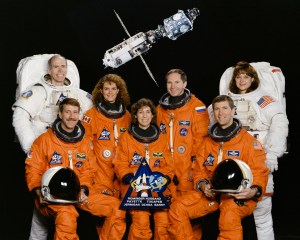
25 Years Ago: STS-96 Resupplies the Space Station

15 Years Ago: First Time all Partners Represented aboard the International Space Station
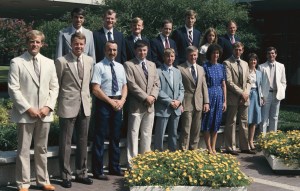
40 Years Ago: NASA Selects its 10th Group of Astronauts

Every Star Trek Movie Comic Book Adaptation, Ranked
- Star Trek movie comic book adaptations have been released by various publishers throughout the franchise's history.
- Some of the adaptations took liberties with the original scripts, but still featured awesome and poignant moments.
- The comic book adaptations provide fans with additional scenes and perspectives that were not in the final movies.
Comic books have been an essential component of the Star Trek franchise for most of its history. Publishers such as Gold Key, Marvel, DC and IDW have taken turns with the Star Trek license, giving fans new and exciting adventures in the final frontier. Nearly every incarnation of the franchise has appeared in comic book form, and some publishers have also created original material.
Another component of the Star Trek comic book experience is the movie adaptations. In the 1980s, it was common practice for major publishers to release books adapting popular movies—and Star Trek was one of them. Here are all the Star Trek movie comic book adaptations, ranked.
Star Trek III: The Search for Spock
Published by dc comics, 1984.
Star Trek III: The Search for Spock is arguably the best of the odd-numbered Trek films, but its comic book movie adaptation takes some liberties with the script, namely in the sequencing of events. For example: the comic adaptation begins with the arrival of the USS Grissom at the Genesis Planet, an event that occurred a third of the way through the actual movie. However, the adaptation is not without awesome and poignant moments that did not make it into the final movie, including an epitaph spoken by Edith Keeler in “City on the Edge of Forever.”
Related: 2023 Proved Star Trek's "Deep Space Nine Sequel" More Than Deserves the Name
Star Trek: Generations
Published by dc comics, 1994.
The first Star Trek: The Next Generation movie adaptation would be the last published by DC Comics , as they would lose the license shortly afterward. Fan opinion on Generations remains divided, with its critics pointing to numerous plot holes, such as the Nexus. DC’s adaptation of Generations does not plug any of these holes, but is still an enjoyable read nonetheless. The comic book version of Generations is notable for including a scene not in the original cut of the film, such as Captain Kirk’s orbital sky-dive. While rough cuts of it are now available to watch, for many years this was the only way for fans to see it.
Related: Star Trek vs Alien Crossover Was Meant to Give Picard His Ultimate Challenge
Star Trek IV: The Voyage Home
Published by dc comics, 1986.
Star Trek IV: The Voyage Home is probably the most accessible of the original Trek films: a light-hearted romp with a serious environmental message. The Voyage Home’s comic book adaptation is a faithful one , largely sticking to the original film’s script. Writer Barr adds some dialogue, including a brief exchange between former Enterprise officers Doctor Chapel and Yeoman Janice Rand . Artists Sutton and Villagran are, like Barr, firing on all thrusters here. Star Trek IV: The Voyage Home is widely regarded as one of the best films in the franchise overall, and its comic book adaptation is worthy of the name.
Star Trek: First Contact
Published by marvel comics, 1996.
Star Trek: First Contact is a tense, nail-biting film , and its adaptation reflects that. Published by Marvel as part of their short-lived “Paramount Comics” imprint, Star Trek: First Contact stays faithful to Brannon Braga and Ronald D. Moore’s original screenplay, but is forced to cut some scenes due to spatial limitations. However, this does not deter one bit from the adaptation. Star Trek: First Contact’s movie adaptation was one of a few to receive a reprint years later from IDW, who currently holds the Trek comic license.
Star Trek VI: The Undiscovered Country
Published by dc comics, 1991.
Star Trek VI: The Undiscovered Country was the last ride of the original crew of the Enterprise , a bittersweet end to a glorious run, and its comic book adaptation perfectly captures this tone. Part of the adaptation’s success can be attributed to Peter David , who has written numerous Trek comics and novels, many of which are fan favorites. David and artist Gordon Purcell, who also illustrated a good portion of DC’s Star Trek output, deliver a first-rate adaptation, one that flows just as well as the source film. The Undiscovered Country is one of Trek’s finest hours, and its comic book adaptation is just as good.
Star Trek V: The Final Frontier
Published by dc comics, 1989.
Among fans, Star Trek V: The Final Frontier is regarded as one of the weakest entries in the franchise, but its comic book adaptation shines. Peter David, who had just finished up on DC’s first Star Trek comic, turns in an excellent adaptation that makes the original shine. Drawn by James W. Fry, Star Trek V: The Final Frontier’s comic adaptation hits all the right notes, perfectly distilling the film’s best parts. The comic book version of The Final Frontier was then used to inaugurate DC’s second line of Star Trek comics, which launched shortly thereafter.
Related: 10 Biggest Changes to Star Trek Canon Delivered By Its Epic 'God War'
Star Trek II: The Wrath of Khan
Published by idw, 2009.
Despite being regarded as one, if not the best, Star Trek films, The Wrath of Khan never received a comic book adaptation when it was released in 1982, as Star Trek comics were in limbo at the time, with DC acquiring the license soon after. IDW rectified this problem in 2009, releasing a three-issue adaptation of the movie, which bucked the trend of Trek movie adaptations being one-shots. Thanks to the extra space afforded writer Andy Schmidt and artist Chee Yang Ong, this adaptation shines. Ong’s art especially compliments the movie’s dark tone.
Star Trek: The Motion Picture
Published by marvel comics, 1979.
The modern era of Star Trek comics began with Marvel’s adaptation of Star Trek: The Motion Picture. Initially released as the first three issues of Marvel’s Star Trek comic, The Motion Picture’s adaptation is easily the best of the franchise. Some of its success can be attributed to the legends that worked on it: writer Marv Wolfman and artist Dave Cockrum. Wolfman and Cockrum were on a roll in the late 1970s, and they brought this energy to the adaptation of Star Trek: The Motion Picture . Later released as a one-shot edition by Marvel, the adaptation was reprinted by IDW in the 2000s, giving fans the chance to experience this amazing book again.
The practice of adapting movies to comic book form has largely fallen by the wayside. While the Star Trek movie adaptations may seem relics of a bygone era, they are in fact an important part of the lore.
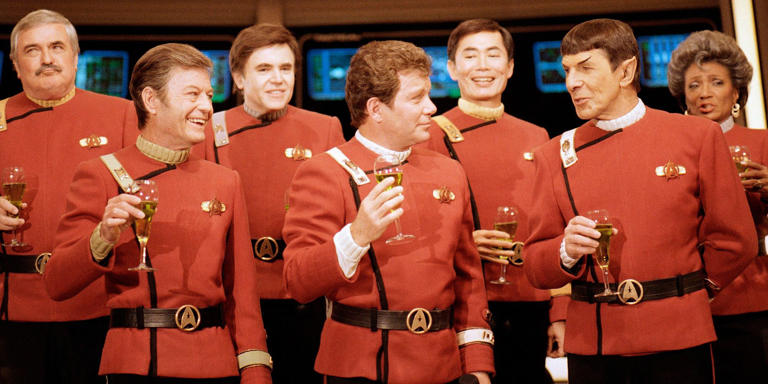
Star Trek: The Motion Picture
Your changes have been saved
Email Is sent
Please verify your email address.
You’ve reached your account maximum for followed topics.
5 Star Trek Actors With Real-Life Children In TV & Movies
Star Trek crews almost always feel like families, but some Star Trek actors got the chance to act alongside their real-life children.
Star Trek Points Out What’s Off About Discovery’s Starfleet Uniforms
The Trill Jinaal makes an offhand remark about Star Trek: Discovery's 32nd-century uniforms that pinpoints something different about the costumes.
Star Trek's Original Movie Uniforms Look Amazing On Lower Decks In Stunning Art
Star Trek: The Motion Picture's monochrome-colored uniforms from the 1970s look great when worn by the Lower Deckers of the USS Cerritos.
What Was V’Ger: Star Trek’s Original Movie Villain Explained
Star Trek: The Motion Picture was criticized for being too cerebral, and its enigmatic villain V'Ger shoulders some of the blame. But what was V'Ger?
Every Star Trek Movie In Chronological Order
With 13 entries in the Star Trek movie series from 1979-2006, there are a couple of ways to watch the films chronologically.
10 Star Trek Movies Ranked By Kirk's Crimes
Starring in ten films across two timelines, Admiral or Captain James T. Kirk breaks all the rules and frequently disobeys direct orders to save lives.
Walter Koenig's 10 Best Star Trek Chekov Moments
Here are the best moments of Walter Koenig as Star Trek: The Original Series' iconic Russian Starfleet Officer, Pavel Chekov.
Every Star Trek Movie’s New Female Character Ranked
The Star Trek franchise's 13 movies have introduced a series of important, intriguing, and intrepid new female characters.
Every William Shatner & Paul Wesley Kirk Promotion & Demotion Seen In Star Trek
Star Trek's Captain James T. Kirk received multiple promotions and demotions over the course of his illustrious Starfleet career.
5 Times Enterprise Wasn’t Ready For Its Star Trek Mission
Exploring space, seeking new life, and boldly going. But here are five times Star Trek's USS Enterprise wasn't actually ready for its iconic mission.
Janeway Became The Star Trek Admiral Kirk & Picard Could Never Be
Captain Janeway (Kate Mulgrew) from Star Trek: Voyager succeeded as an admiral where William Shatner's Kirk & Patrick Stewart's Picard could not.
13 Star Trek Movies Ranked By Worst To Best Box Office
Every Star Trek fan can tell you their personal ranking of the 13 Star Trek films, but how did they stack up at the US box office?
The Complete Star Trek Timeline Explained
From James T. Kirk to Jean-Luc Picard, from Kathryn Janeway to Michael Burnham, we're breaking down the full chronological timeline of Star Trek.
Den of Geek
Comparing The Three Versions of Star Trek: The Motion Picture
Is there a definitive version of Star Trek: The Motion Picture at last? We compared all the different versions of this misunderstood movie to find out.

- Share on Facebook (opens in a new tab)
- Share on Twitter (opens in a new tab)
- Share on Linkedin (opens in a new tab)
- Share on email (opens in a new tab)
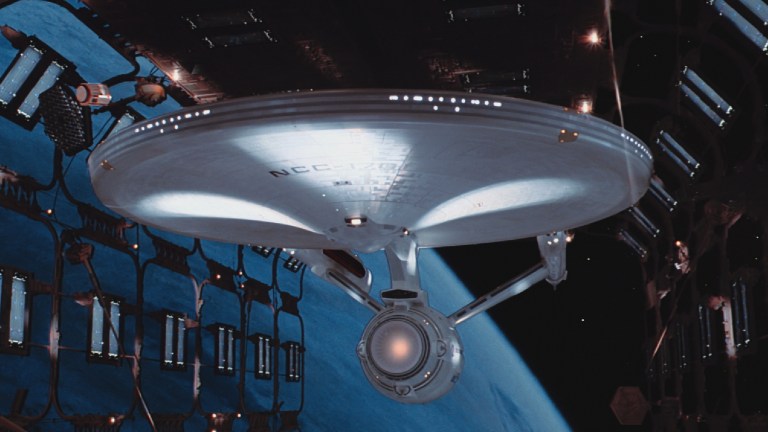
Some 44 years after it went into production, Star Trek: The Motion Picture is finally complete.
We don’t say that frivolously. Star Trek: The Motion Picture is one of Hollywood’s most famous “unfinished” films. Rushing to meet a December 7, 1979 release date, with many of the visual effects being completed right up until the last possible minute by Douglas Trumbull (who had replaced the previous VFX supervisor), director Robert Wise ( The Day the Earth Stood Still , The Sound of Music ) pretty much just stopped working on the film, carrying the first available print on a plane to the movie’s Washington D.C. premiere.
The complicated story of how ST: TMP – the first major motion picture based on an existing TV series — was developed, written, filmed, and released is a long, winding one that has been told before. It’s also well-known that the original theatrical version of the film – the one that Wise had to deliver finished or not – was not well-received by either fans or critics, although it became a sizable box office success.
Yet Star Trek: The Motion Picture steadily grew in stature over the years, gradually beginning to hold its own with fans even as later favorites like Star Trek II: The Wrath of Khan and Star Trek IV: The Voyage Home ascended to the top of the franchise.
Ad – content continues below
With fans and even critics constantly reappraising the original film, Paramount Pictures – with the encouragement of two members of Robert Wise’s production company, David C. Fein and Michael Matessino – allowed Wise and his team to revisit the movie in 2001, reconstructing it to finally adhere more closely to Wise’s original vision.
The release of Star Trek: The Motion Picture – The Director’s Edition in November 2001 on home video (DVD and VHS) confirmed for many fans that there was a far better film after all hidden inside the “rough cut” (Wise’s own words) released in 1979. Scenes were excised or trimmed, a few were reinstated, and most importantly, the visuals were spruced up with the help of CGI. The legendary Wise, who passed away four years later in 2005, got the chance to finish the movie the way he wanted.
But the story wasn’t over yet.
Star Trek: The Motion Picture Reborn
Earlier this year, Paramount+ premiered a 4K Ultra HD (high definition) version of Star Trek: The Motion Picture – The Director’s Edition . Prepared over the course of six months by Fein, Matessino, and a visual effects team with access to Paramount’s archives, this iteration of ST: TMP stayed true to the vision established by Wise for The Director’s Edition in 2001, while doing a further, extensive, HD restoration and upgrade of the entire film.
Now the Ultra HD Director’s Edition , along with 4K Ultra HD versions of the original theatrical cut and the “Special Longer Version” that was created for broadcast television in 1983, are available in a newly released set called The Complete Adventure , which gives us a definitive document of Star Trek: The Motion Picture in all three versions, looking perhaps the best they’ll ever look ( The Director’s Edition is also available on its own or as part of a set containing Ultra HD upgrades of all six films starring the original Trek cast).
Having seen the film in its original theatrical release, then on VHS, DVD, and Blu-ray, we were always put off by the seeming drabness of the image and the colors. To our eyes, Star Trek: The Motion Picture – despite the occasionally awe-inspiring visuals it did manage to pull off against all odds – never seemed to pop off any screen or medium we watched it on.
That problem is now solved, and overpoweringly so: the film in 4K Ultra HD looks absolutely magnificent, as if we’re truly seeing the film for the first time.
Get the best of Den of Geek delivered right to your inbox!
Yes, many of the VFX have been digitally enhanced or even freshly recreated, but they’re integrated almost seamlessly into the original aesthetic of the film, while many of the rough spots in the original release have been repaired or replaced. Now the 4K image really does leap off the screen in amazing color and detail. To watch Star Trek: The Motion Picture in this way is to watch a 44-year-old science fiction movie that looks in many ways like it was made last year.
And now that all three versions of the movie are here in this beautiful, pristine form, which one holds up the best and do they differ?
The Original Theatrical Cut
It may look better than it ever has, but the original theatrical cut of Star Trek: The Motion Picture still has all the issues it had when it first came out. It’s slow-moving to the point of being inert, it spends way too much time on endless visuals (the first sight of the refurbished Enterprise , the lengthy flyover of the massive V’Ger spacecraft – heck, even Spock’s neck-pinch of some poor slob guarding an airlock takes way too long), and it leaves certain plot information and character motivations ambiguous at best and absent at worst.
What ST: TMP does retain is a sense of grandeur, and occasionally a sense of wonder, that often marked the best of the original series and has been sadly lacking in so much filmed science fiction ever since, including later Trek movies and TV series.
So many of the later movies – especially the J.J. Abrams-conceived Kelvin trilogy , but some of the classic and Next Generation films have the same problem – revolve around fairly simple bad guy/revenge motifs.
The original series had its share of those simple action-adventure episodes, but so much more of it was dedicated to great ideas – whether it be truly alien encounters, mirror universes, or moral quandaries posed by the Enterprise sticking its saucer in a new planet’s business.
And yes, even though Star Trek: The Motion Picture is in some ways a rewrite of the original series episode “The Changeling,” it’s much more expansive and even cosmic in its implications. While several later Trek films are superior in many ways, few of them have matched ST: TMP in its ambitions and pure science fiction concepts.
The acting is inconsistent, to say the least, although all our old favorites each have a memorable moment or two, and the glacial pacing really is at odds with the imagination glimpsed in the storyline and the visuals. In many ways, the theatrical cut remains a slog, but it’s also a one-of-a-kind Trek movie.
The ‘Special Longer Version’
Star Trek: The Motion Picture premiered on American network television – ABC, to be exact – on February 20, 1983. Not only was this the first TV showing of the movie, but it also introduced a different cut of the film that came to be known as the “Special Longer Version.” Running for two hours and 24 minutes (without commercials), as opposed to the theatrical cut’s two hours and 12 minutes, the “SLV” essentially incorporated a number of scenes that were left unfinished and kept out of the picture by director Robert Wise in 1979 – who apparently did not approve of this version.
A lot of the scenes that were added back into the movie for the “SLV” were and are clearly extraneous, although in some cases amusing to watch.
There are a couple of exchanges between Sulu (George Takei) and the Deltan navigator Ilia (Persis Khambatta) – whose species is apparently quite sexually attractive and active – that are possibly meant to suggest Sulu is coming under her spell, although they were jettisoned to focus on Ilia and Decker’s (Stephen Collins) relationship (there is also more of that present in this cut).
Other sequences – like a moment in which Spock (Leonard Nimoy) weeps for V’Ger and a quick scene of Ilia helping to relieve Chekov’s (Walter Koenig) pain after he is injured – actually made it into the Director’s Cut and work well there as improved character moments.
Most infamously, the original release of the “SLV” contained a literally unfinished shot of Kirk (William Shatner) leaving the Enterprise airlock in a spacesuit to pursue Spock as the Vulcan himself spacewalks deeper into V’Ger’s interior. When the “SLV” was first shown, parts of the soundstage around the airlock set were still visible, as a result of the effects for the scene never being completed (the new 4K Ultra HD version of the “SLV” rectifies that, although the incomplete version is provided as a bonus feature).
Importantly, the new version of the “SLV” has restored it to its theatrical matting – the movie was cropped to the old TV screen ratio of 1.33: 1 for broadcast (and for several subsequent home video releases), turning Wise’s widescreen compositions into a nightmare of forced zooms and pan-and-scanning. At least now this version of the film is restored to its proper ratio.
That said, the “Special Longer Version” is in many ways the worst version of the film. While it’s always interesting for completists to see footage left out of a theatrical movie, this iteration simply pastes all that material back into the film – ostensibly to fill a three-hour “network movie premiere” slot, back in the day when such things mattered – without any consideration of whether it should be there. If the pacing of Star Trek: The Motion Picture has always been a bone of contention for you, the “SLV” doubles down on that.
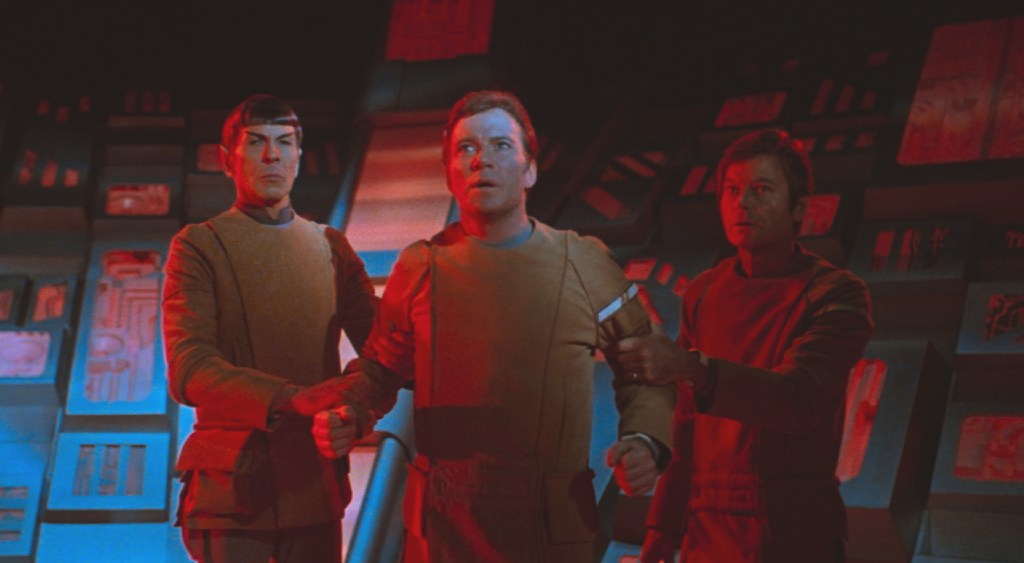
The Director’s Edition
Ironically enough, the Robert Wise-supervised “Director’s Edition” of Star Trek: The Motion Picture runs for two hours and 16 minutes – four minutes longer than the theatrical release. It also includes some of the scenes Wise left out initially, which surfaced in the interim in the TV version of the movie (a detailed list of alterations and additions can be found here ).
But while it still suffers from pacing issues, they’re less of a detriment. The Director’s Edition still moves slowly, but doesn’t feel like it drags, and there’s more of a stateliness to it that is befitting the movie’s larger themes – which are also given more clarity in this version.
Latest Movie reviews
Hit man review: you owe it to yourself to watch glen powell’s movie stardom manifest, bad boys: ride or die review – out-bayhems michael bay, furiosa review: george miller makes one of the best prequels ever in new mad max.
Perhaps the most important edition in that sense is the scene in which Spock weeps for V’Ger – a scene that makes it much clearer what V’Ger is seeking as it returns to Earth, and why its quest has reached a potentially catastrophic dead end.
More importantly, the scene also brings Spock’s own character arc in the film into much better focus – he realizes that his desire to purge all remaining emotion from his own life (the kolinahr ritual) could lead him to the same cold, empty existence that V’Ger now faces, which he firmly rejects.
Also retained is Ilia’s healing of Chekov, adding a little more nuance to what is mostly a blank slate of a character, as well as some brief interactions between the supporting crew members.
What is left out are, most notably, the full-length travelogues along V’Ger’s exterior and interior (although we do get a neat shot of the entire V’Ger vessel emerging from its cloud above Earth). The scenes are still there, but this material – and a number of other visuals – is trimmed and sharpened to give the movie a little more forward motion. Along with that, so many subtle visual and audio touches have been added – whether it’s better matte or CG backgrounds or original sounds from the TV series – to create more ambiance and an overall more fulfilling cinematic Trek experience.
When Wise and his team took the movie back into the shop in 2001, they overhauled the visuals and the sound mix with the best available technology at the time – yet the limitations back then in terms of resolution meant that the Director’s Edition was only available on DVD for the next 20 years. With the new upgrade, all the visual and sonic enhancements (plus new ones) have been rendered so that they can now be seen in 4K Ultra HD – thus giving Star Trek: The Motion Picture the most up-to-date restoration possible.
The result is an often eye-popping science fiction spectacle that looks fresher and better than ever before. As rushed as the original production was, it’s a tribute to Wise, Trumbull, and the team that completed the film in 1979 that so much of their work still holds up and was able to mesh so well with the enhancements of both 2001 and 2021.
But just as importantly, Star Trek: The Motion Picture is now about as close as it will ever come to being the visionary sci-fi epic that it was first conceived as. The new version of The Director’s Edition retains all the narrative revisions that Wise made more than two decades ago, while adding the visual grandeur that such a cerebral story needed in the first place. Yes, there are still flaws in the film, and it may never replace, say, The Wrath of Khan at the top of Trek movie rankings, but more than four decades after it first came out, Star Trek: The Motion Picture is now finished.
This film’s journey is at last complete, but the human adventure is still just beginning.
Star Trek: The Motion Picture – The Director’s Edition – The Complete Adventure is out now on 4K Ultra HD and Blu-ray.

Don Kaye | @donkaye
Don Kaye is an entertainment journalist by trade and geek by natural design. Born in New York City, currently ensconced in Los Angeles, his earliest childhood memory is…
Follow Polygon online:
- Follow Polygon on Facebook
- Follow Polygon on Youtube
- Follow Polygon on Instagram
Site search
- Dragon’s Dogma 2
- Zelda: Tears of the Kingdom
- Baldur’s Gate 3
- Summer Game Fest schedule
- PlayStation
- Dungeons & Dragons
- Magic: The Gathering
- Board Games
- All Tabletop
- All Entertainment
- What to Watch
- What to Play
- Buyer’s Guides
- Really Bad Chess
- All Puzzles
Filed under:
- Entertainment
Netflix’s Eric, Star Trek: Discovery’s series finale, and more new TV this week
Plus: The end of Hulu’s Under the Bridge, Hacks season 3, and more
Share this story
- Share this on Facebook
- Share this on Reddit
- Share All sharing options
Share All sharing options for: Netflix’s Eric, Star Trek: Discovery’s series finale, and more new TV this week
/cdn.vox-cdn.com/uploads/chorus_image/image/73372608/DISCO_509_MAG_1021_01113_1_RT1.0.jpeg)
The week has barely started (if you’re in the U.S. and reading this on the Monday holiday: even less so!), and already there’s a whole lot of TV to get through.
With any luck, the long weekend gave you some time to catch up with things — after all, as our summer preview is any indication, there’s only gonna be even more coming soon. But while a bunch of new stuff might be coming up, there’s plenty to watch this week alone. Under the Bridge and Hacks are both wrapping up really strong seasons, while shows like Pyramid Game and We Are Lady Parts are just ramping up.
Here are all the best new TV premieres and finales this week.
New shows on Netflix
Genre: Drama miniseries Release date: May 30, with all episodes Showrunner/creator: Abi Morgan Cast: Benedict Cumberbatch, Gaby Hoffmann, and more
Vincent (Benedict Cumberbatch) is a puppeteer happily living and working in 1980s New York City. Then, his 9-year-old son goes missing on the way to school, plunging Vincent into a dark, volatile depression. Vincent believes his son will come back if only he can get Eric, a monster based on a drawing his son did, to the screen.
Genre: Teen show Release date: May 30 Based on the book by: Holly Smale Cast: Emily Carey, Sarah Parish, Emmanuel Imani, and more
Harriet (Emily Carey) is just another geek trying to get by in high school, even if it means brushing off some mean girl bullies to do it. But everything changes when — against the odds and Harriet’s wishes — she finds herself scouted to be the next hot supermodel.
New shows on Hulu
The veil season finale.
:no_upscale()/cdn.vox-cdn.com/uploads/chorus_asset/file/25442501/VEIL_0000054.jpg)
Genre: Spy thriller Release date: May 28 Showrunner/creator: Steven Knight Cast: Elisabeth Moss, Yumna Marwan, Josh Charles, and more
The stage is set in London for a deadly attack. But Imogen (Elisabeth Moss) and Adilah (Yumna Marwan) are also on the move. And with Imogen keeping her master plan secret from even us, it seems likely that this attack could go either way.
Under the Bridge finale
:no_upscale()/cdn.vox-cdn.com/uploads/chorus_asset/file/25453519/utb_106_ds_00393rc_3k.jpg)
Genre: True-crime mystery Release date: May 29 Showrunner/creator: Samir Mehta, Quinn Shephard Cast: Lily Gladstone, Riley Keough, and more
There’s nothing about the murder of Reena Virk (Vritika Gupta) that feels easy to swallow, and it’s a testament to Under the Bridge that the show has been able to balance the complexities of that reality in its seven episodes so far. Now, it’s coming to a close — one that no doubt will carry the weight of every ounce of tragedy in this story.
New shows on Max
Hacks season 3 finale.
:no_upscale()/cdn.vox-cdn.com/uploads/chorus_asset/file/25453526/hannah_einbinder_jean_smart_1.jpg)
Genre: Comedy Release date: May 30 Showrunner/creator: Paul W. Downs, Lucia Aniello, and Jen Statsky Cast: Hannah Einbinder, Jean Smart, and more
It’s all happening for Deborah (Jean Smart), now that she finally got her dream of hosting a late-night show. Only suddenly, there’s some last-minute doubt: Will Ava (Hannah Einbinder) be allowed to come along for the ride?
New shows on Paramount Plus
Pyramid game.
Genre: Thriller Release date: May 30, with all 10 episodes Showrunner/creator: Choi Sui Cast: Bona, Jang Da-a, Ryu Da-in, and more
Seong Su-ji is a new student at the Baekyeon Girls’ High School, and everything is already feeling like a fight for survival as she battles bullies and studies alike. And then she’s introduced to a new ranking system that lets people secretly vote for who they think should be a class outcast. Now, Su-ji has to decide whether to keep going along (and possibly accepting the violence that comes with it) or else lead an uprising against this shadowy “Pyramid Game.”
Star Trek: Discovery series finale
:no_upscale()/cdn.vox-cdn.com/uploads/chorus_asset/file/25437335/DISCO_506_MAG_0914_12774_1_RT1.jpeg)
Genre: Star Trek Release date: May 30 Showrunner/creator: Akiva Goldsman Cast: Sonequa Martin-Green, Mary Wiseman, Doug Jones, and more
The end of an era! By which I mean not only the season we got of 900 years in Star Trek’s future, but also Discovery , which wraps up this Thursday. It’s the end of the first Star Trek show of the modern era, and is free in a way Star Trek hasn’t been in a long, long while , all while paving the way for more Trek to come.
New shows on Peacock
We are lady parts season 2.
Genre: “Yeah, I’m in a band” teen comedy Release date: May 30, with all episodes Showrunner/creator: Nida Manzoor Cast: Anjana Vasan, Sarah Kameela Impey, Juliette Motamed, and more
We Are Lady Parts is back and ready to record their debut album. Which means it’s the perfect time for more bandmate shenanigans — including battling a rival Muslim band, playing a festival, exploring your “villain era.” All that and Malala Yousafzai is supposed to show up sometime this season!
New shows on Apple TV Plus
Loot season 2 finale.
Genre: Comedy Release date: May 29 Showrunner/creators: Alan Yang and Matt Hubbard Cast: Maya Rudolph, Joel Kim Booster, Nat Faxon, and more
The Wells Foundation — and Molly (Maya Rudolph), the billionaire woman who runs it — are nearing their greatest success yet. Which, of course, means reality is about to come crashing in with some major personal decisions. How will the dust settle in the season 2 finale?
New shows on Showtime
Couples therapy season 4.
Genre: Documentary series Release date: May 31, with one episode; on-air premiere at 10 p.m. EDT on June 2 Showrunner/creator: Dr. Orna Guralnik Cast: Real-life couples in therapy
It’s a new season of Couples Therapy, and an all-new cast of couples to undergo real therapy with Dr. Orna. The result will be unpredictable — couples therapy, after all, is about figuring yourselves out together, not necessarily saving the relationship. The good news? It will most likely be cathartic, one way or another.
The next level of puzzles.
Take a break from your day by playing a puzzle or two! We’ve got SpellTower, Typeshift, crosswords, and more.
Sign up for the newsletter Patch Notes
A weekly roundup of the best things from Polygon
Just one more thing!
Please check your email to find a confirmation email, and follow the steps to confirm your humanity.
Oops. Something went wrong. Please enter a valid email and try again.
Loading comments...

Wallace and Gromit’s penguin nemesis returns in teaser for new Netflix short

Where to unlock all custom deliveries in FFXIV

How to get the Overgrown Prismatic Key in Destiny 2

How to get the Divided Prismatic Key in Destiny 2

The PlayStation 5 Slim just got its first discount

You can get the Eye of Sauron in Lego form with the new Barad-dûr set

COMMENTS
After more than two decades, Robert Wise's Director's Edition of Star Trek: The Motion Picture has been remastered in 4K HDR, which debuted last month on Paramount+ (see TrekMovie review).This ...
Keen-eyed fans will enjoy spotting the additions and changes, an early highlight is the addition of Shuttle Pod 5 to the exterior of Starfleet's orbital office. ... Star Trek: The Motion Picture ...
Comparison of notable changes made to Star Trek: The Motion Picture for the Director's Edition released in 2022.Chapters:00:00 Starfleet Command00:44 Escapin...
The new 4K Director's Edition of Star Trek: The Motion Picture made our Most Anticipated Of 2022 List, and this week the team behind the Paramount+ project released some new images that indicate ...
Originally released in 1979, Star Trek: The Motion Picture became the fourth highest grossing movie of the year and earned three Academy Award® nominations for Best Visual Effects, Best Art Direction, and Best Music, Original Score. The film successfully launched the Star Trek franchise beyond the original television series, despite having been rushed to theaters with incomplete special ...
With the exception of a brief clip released on Star Trek Day 2021, details about the 4K UHD upgrade of Star Trek: The Motion Picture - The Director's Edition have been scarce. The project ...
Coming up on April 5th (also known as Star Trek Day) Paramount+ is releasing a 4K UHD upgrade of Star Trek: The Motion Picture - The Director's Edition, with a physical media release coming ...
How Star Trek: The Motion Picture made the voyage home (to 4K) Producer David C. Fein on why this version will change minds about the first Star Trek film, some "happy accidents" during the ...
Following a first few glimpses last month, the team behind the in-progress 4K UHD remastering of the Star Trek: The Motion Picture Director's Edition today shared some new high-resolution captures of some new visual effects work from the 2022 release! Shared at the official Star Trek website, the updated look behind the scenes now includes not only a look at new imagery from the film, but a ...
While Star Trek: The Motion Picture — The Director's Edition will only be available through Paramount+ at the time of its debut, the studio has already announced both theatrical screenings and an on-disc release for later in the year. Fathom Events will be holding theatrical screenings of the new TMP-DE release on May 22, May 23, and May 25 (local timings and ticket sales coming to Fathom ...
On April 5, 2022, the new 4K restoration of Star Trek: The Motion Picture: Director's Edition debuted on Paramount+. Overseen by David Fein, Daren Dochterman, and Mike Matessino, this cut of the ...
Star Trek: The Motion Picture: Directed by Robert Wise. With William Shatner, Leonard Nimoy, DeForest Kelley, James Doohan. When an alien spacecraft of enormous power is spotted approaching Earth, Admiral James T. Kirk resumes command of the overhauled USS Enterprise in order to intercept it.
Eagerly anticipated by Star Trek fans for over two decades, Star Trek: The Motion Picture—The Director's Edition will make its long-awaited debut exclusively on Paramount+ on April 5, 2022, in celebration of First Contact Day. The film will be available to stream on Paramount+ in 4K Ultra HD on supported devices and platforms. The newly restored film will subsequently arrive on 4K Ultra HD ...
Additionally, the "Star Trek: The Original Motion Picture Collection," featuring all six big-screen adventures with the original series crew, is also available on 4K Ultra HD. This interview was ...
The road to Star Trek: The Motion Picture was a long one. Initially conceived by series creator Gene Roddenberry in 1969 following the cancellation of the original television series, it wasn't ...
After investigating, the crew discovers that the alien cloud harbors artificial intelligence with an ominous primary directive. Crisis strikes when a probe dispatched by the energy cloud attacks ...
The newly released Star Trek: The Motion Picture ... How are these changes improvements that are aligned with the director's vision when Wise himself could have made these changes when he was ...
In 1987, Star Trek: The Next Generation traded the famous flip-up Starfleet communicator for a wearable badge that you tapped; kind of like jewelry that was also a cellphone. But, the idea of having a wearable communicator actually started in Star Trek: The Motion Picture.. In this movie, everybody has wrist-communicators that look like Apple watches manufactured by Atari.
Released in 1979, Star Trek: The Motion Picture is a prime example of years of lingering chaos on a major theatrical production. It wasn't originally intended for the big screen, either, as they were actually working on Star Trek: Phase Two in series format as a continuation of the '60s series Star Trek.Paramount Pictures then switched to a feature film in the middle of the project, which was ...
Star Trek: The Motion Picture is a 1979 American science fiction film directed by Robert Wise. ... Taylor took on the nacelles, and Probert the rest of the ship. Changes included "radiator grill" nacelle caps, a glowing deflector dish, a new impulse engine, new shapes for the aft end and hangar doors of the secondary hull, more docking ports ...
The Star Trek film series starring the cast of Star Trek: The Original Series saw the crew of the USS Enterprise undergo some jarring changes. The story of Star Trek's resurrection is the stuff of pop culture legend at this point.A ratings failure during its initial run, TOS became a phenomenon in syndication in the 1970s. While there were tentative plans to revive the television series, the ...
The Expedition 21 crew dressed in uniforms from the original series, while the STS-134 crew chose as their motif the 2009 reboot motion picture Star Trek. Left: Picture of the Gemini VI launch in the background in the 1967 Star Trek episode "Court Martial." Credit: Image courtesy of Collectspace.com. Middle: NASA astronaut Mae C. Jemison ...
Wolfman and Cockrum were on a roll in the late 1970s, and they brought this energy to the adaptation of Star Trek: The Motion Picture. Later released as a one-shot edition by Marvel, the ...
Your changes have been saved. Email Is sent. close. Please verify your email address. Send confirmation email. close. ... Star Trek: The Motion Picture's monochrome-colored uniforms from the 1970s look great when worn by the Lower Deckers of the USS Cerritos. By John Orquiola. Mar 26, 2024.
The release of Star Trek: The Motion Picture - The Director's Edition in November 2001 on home video (DVD and VHS) confirmed for many fans that there was a far better film after all hidden ...
Genre: Thriller. Release date: May 30, with all 10 episodes. Showrunner/creator: Choi Sui. Cast: Bona, Jang Da-a, Ryu Da-in, and more. Seong Su-ji is a new student at the Baekyeon Girls' High ...